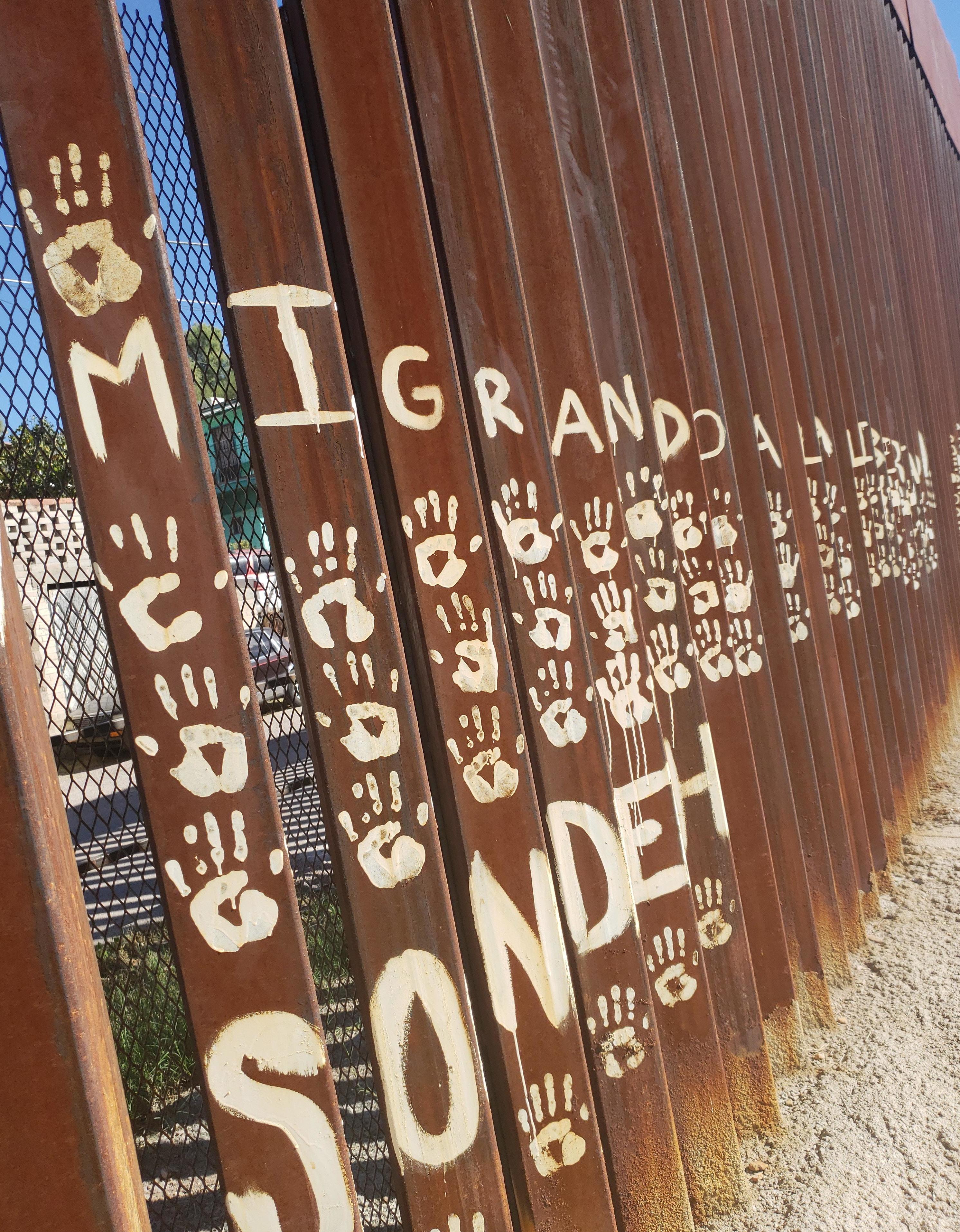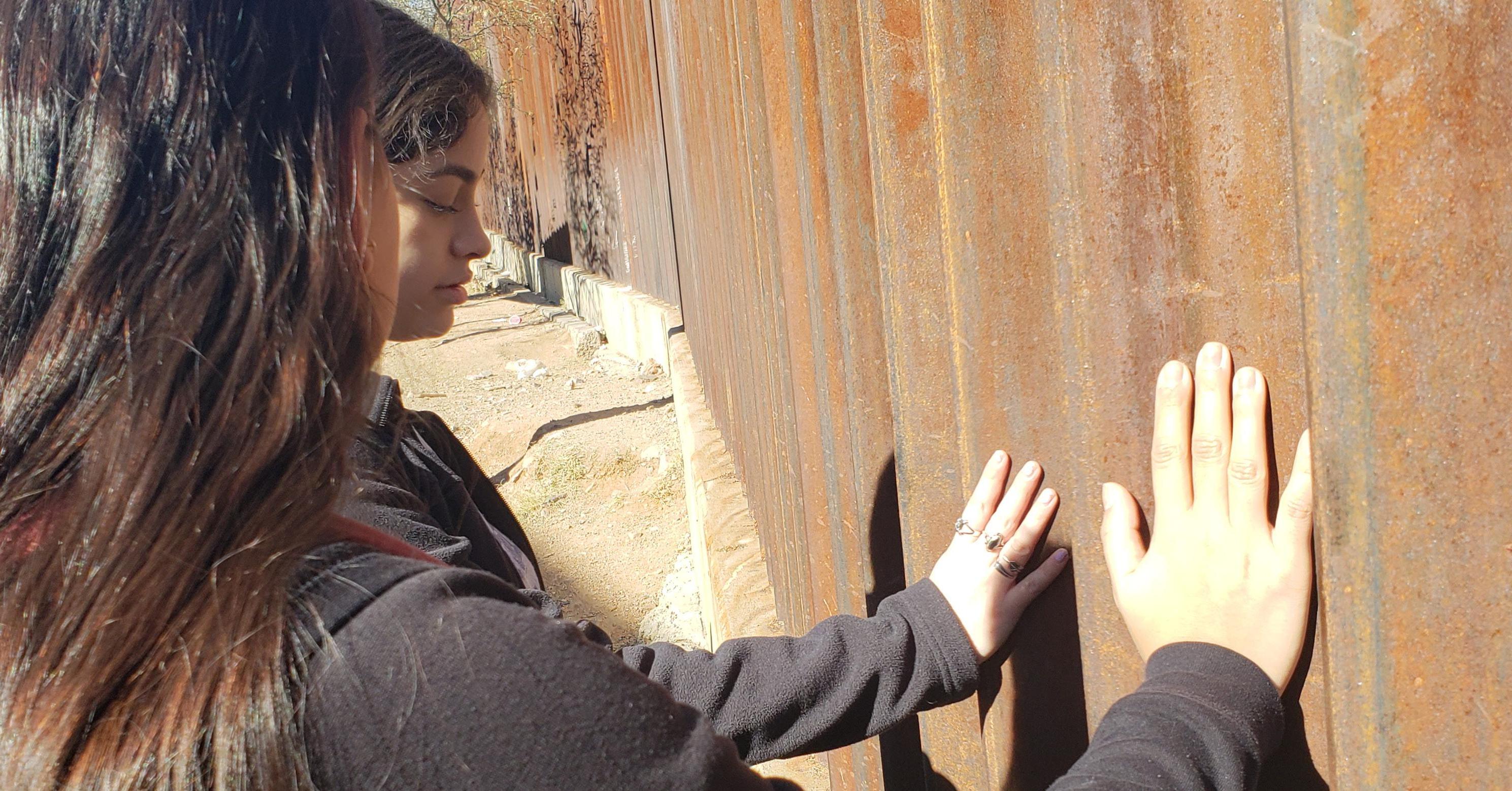AUTUMN 2019

BEYOND THE BORDERS
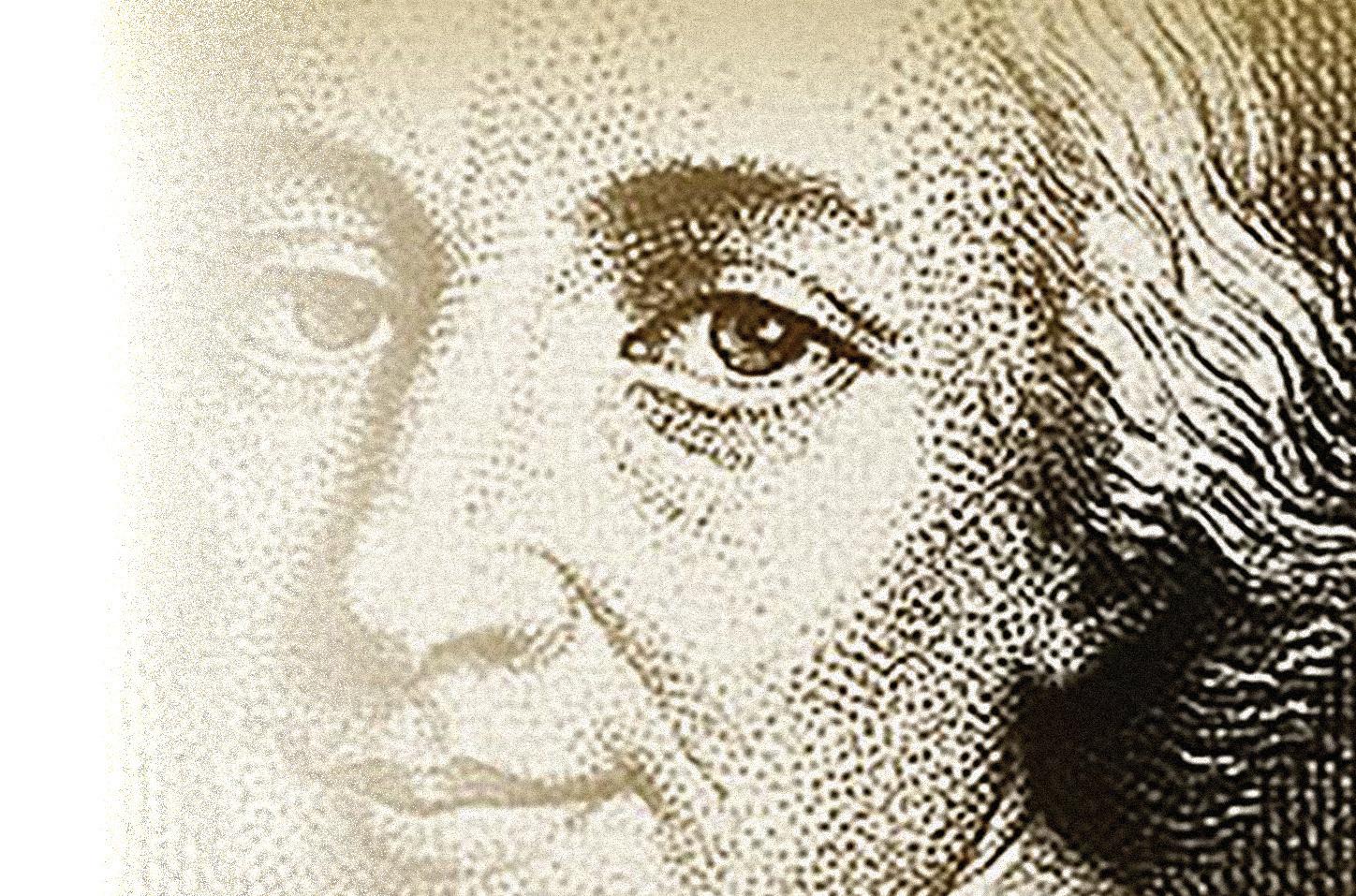
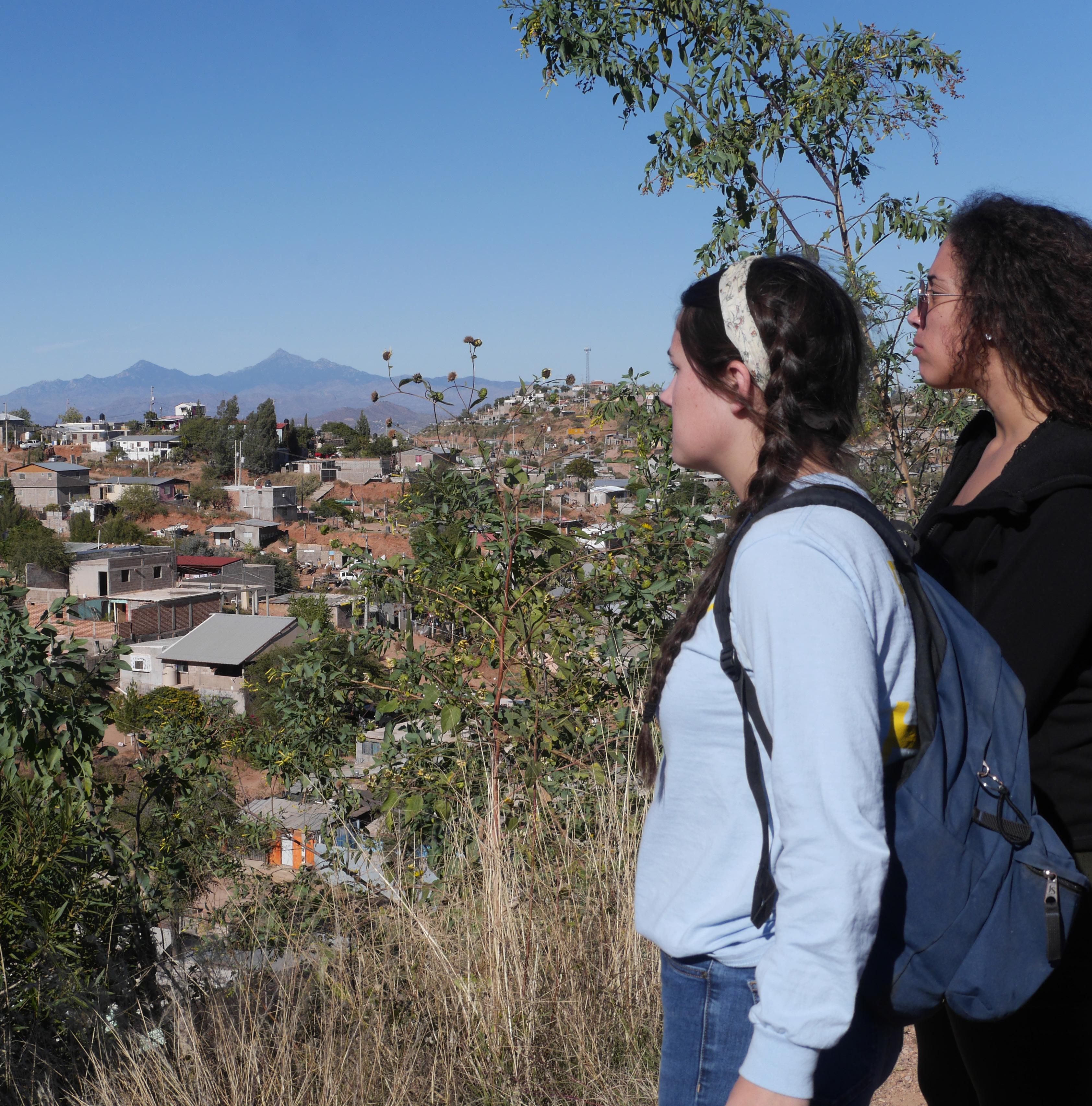
TODAY A MAGAZINE FOR THE LASALLIAN FAMILY IN THE LASALLIAN REGION OF NORTH AMERICA
Dear Readers,
As Lasallians, we are often called go beyond our borders—whether that means geographically, societally, personally, etc. In May 2019, the Institute of the Brothers of the Christian Schools introduced the Beyond the Borders initiatives, a series of projects that spread across all five Regions serving those most in need. This issue of De La Salle Today is inspired by those initiatives.
We begin by explaining the background and significance of the Beyond the Borders initiatives. Then, we tell the stories of the transformative initiatives that are part of it. First, you’ll learn about the two projects in the Lasallian Region of North America (RELAN): El Otro Lado at the U.S.-Mexico border and OKI-NI-SOO-KA-WA Blackfeet Immersion at De La Salle Blackfeet School in Montana. Then, you’ll read about the projects in the other four Regions. These are powerful examples of what it means to go beyond the borders.
From there, we look at other ways in which we go beyond the borders in RELAN. First, we show you how the twinning program has been connecting young people in RELAN and the Lwanga District of Africa for 25 years. Then, we look at a different kind of border: financial. You'll hear from all six Lasallian colleges and universities in the United States about how they stop financial struggles from standing between students in need and higher education. We also share examples of how secondary schools are going beyond the borders through innovative efforts within the walls of their schools and beyond.
Finally, we focus on Brother James Miller, FSC, who went beyond his borders to serve the poor in dangerous conditions and, as a result, died a martyr in 1982 in Huehuetenango, Guatemala. Ahead of his December beatification, we hear from two people who were close with Brother James. In compelling interviews, they share their perspectives on who Brother James was, what his death and beatification journey have been like for them, and what they hope for Brother James’ legacy.
We hope this issue inspires you and challenges you to go beyond your borders to reach those in need.
Live Jesus in our hearts … Forever!
ELIZABETH MOORS JODICE Editor
Cover: During an El Otro Lado immersion in 2018, Lasallian Volunteer Savannah Mattox (right) stands with a student from Justin-Siena High School in Napa, California, looking out over homes belonging to Mexican factory workers in Nogales, Sonora, Mexico. They work in American factories, which are located in Mexico and manufacture products that are sold in the United States. Courtesy Sister Jodi Min, OP
CHRISTIAN BROTHERS CONFERENCE
415 MICHIGAN AVENUE NE, SUITE 300
WASHINGTON, DC 20017
202-529-0047
COMMUNICATIONS@LASALLIAN.INFO
WWW.LASALLIAN.INFO
GENERAL COUNCILOR, RELAN
BROTHER TIMOTHY COLDWELL, FSC
EXECUTIVE DIRECTOR, OFFICE FOR LASALLIAN EDUCATION
MARK JOHN FREUND
EDITOR
ELIZABETH MOORS JODICE
ASSISTANT EDITOR/LAYOUT AND DESIGN
ANNA WADDELOVE
STORY DEVELOPMENT
BOB CARREJO
PHILIP DE RITA
DENIS DE VILLERS
ALEX VASILIADES
TRANSLATION
DENIS DE VILLERS
CONTRIBUTING WRITERS
BOB CARREJO
BROTHER CRAIG FRANZ, FSC
ELIZABETH MOORS JODICE
ALEX VASILIADES
RYAN WALL
PHOTOGRAPHY
BAMBOO SCHOOL
CHRISTIAN BROTHERS ACADEMY, LINCROFT
CHRISTIAN BROTHERS UNIVERSITY
CRETIN-DERHAM HALL DE LA SALLE BLACKFEET SCHOOL
MARYANN DONOHUE-LYNCH
FELIXPHOTO – NAKA
LASALLIAN REGION OF EUROPE/MEDITERRANEAN (RELEM)
LA SALLE SCHOOL – RUMBEK
LA SALLE TECHNICAL COLLEGE – HOHOLA
MATT LEHMAN
LEWIS UNIVERSITY
ANDRES LOPEZ
ABBY MICHELS
MIDWEST DISTRICT
MULLEN HIGH SCHOOL
PROJECT ALÉM
SAINT MARY’S COLLEGE HIGH SCHOOL
SAINT MARY’S COLLEGE OF CALIFORNIA
SAINT MARY’S UNIVERSITY OF MINNESOTA
SERVIZIO FOTOGRAFICO – VATICAN MEDIA
SISTER JODI MIN, OP
CREATIVE CONSULTANT
JOHN BURNS DESIGN GROUP

PLEASE EMAIL COMMENTS AND SUGGESTIONS TO COMMUNICATIONS@LASALLIAN.INFO. THE EDITOR OF DE LA SALLE TODAY RESERVES THE RIGHT TO EDIT AND MAKE FINAL DECISIONS REGARDING THE CONTENT
PUBLISHED IN THE MAGAZINE.
DE LA SALLE TODAY IS PUBLISHED BY CHRISTIAN BROTHERS CONFERENCE FOR THE LASALLIAN FAMILY IN THE LASALLIAN REGION OF NORTH AMERICA (RELAN).
ELIZABETH MOORS JODICE
BROTHER CRAIG FRANZ, FSC
ELIZABETH MOORS JODICE
ELIZABETH MOORS JODICE


1 | 8 LIVING THE MISSION BEYOND THE BORDERS BY
BY DENIS
13 SEPARATED NO MORE BY
TRANSLATED BY DENIS
22 A WORLDWIDE RESPONSE TO THOSE IN NEED BY
27 25 YEARS OF TWINNING: BUILDING RELATIONSHIPS BETWEEN STUDENTS IN RELAN AND LWANGA BY
31 MAKING HIGHER EDUCATION FINANCIALLY ACCESSIBLE BY
36 A GLOBAL COMMUNITY STARTS IN THE CLASSROOM BY
40 BROTHER JAMES MILLER: BEFORE BECOMING BLESSED BY ALEX VASILIADES LETTER FROM THE EDITOR 2 NEWS AND APPOINTMENTS 36 CALENDAR OF EVENTS TODAY
TRANSLATED
DE VILLERS
BOB CARREJO
DE VILLERS
RYAN WALL
SUPERIOR GENERAL IN RELAN FOR PASTORAL VISIT
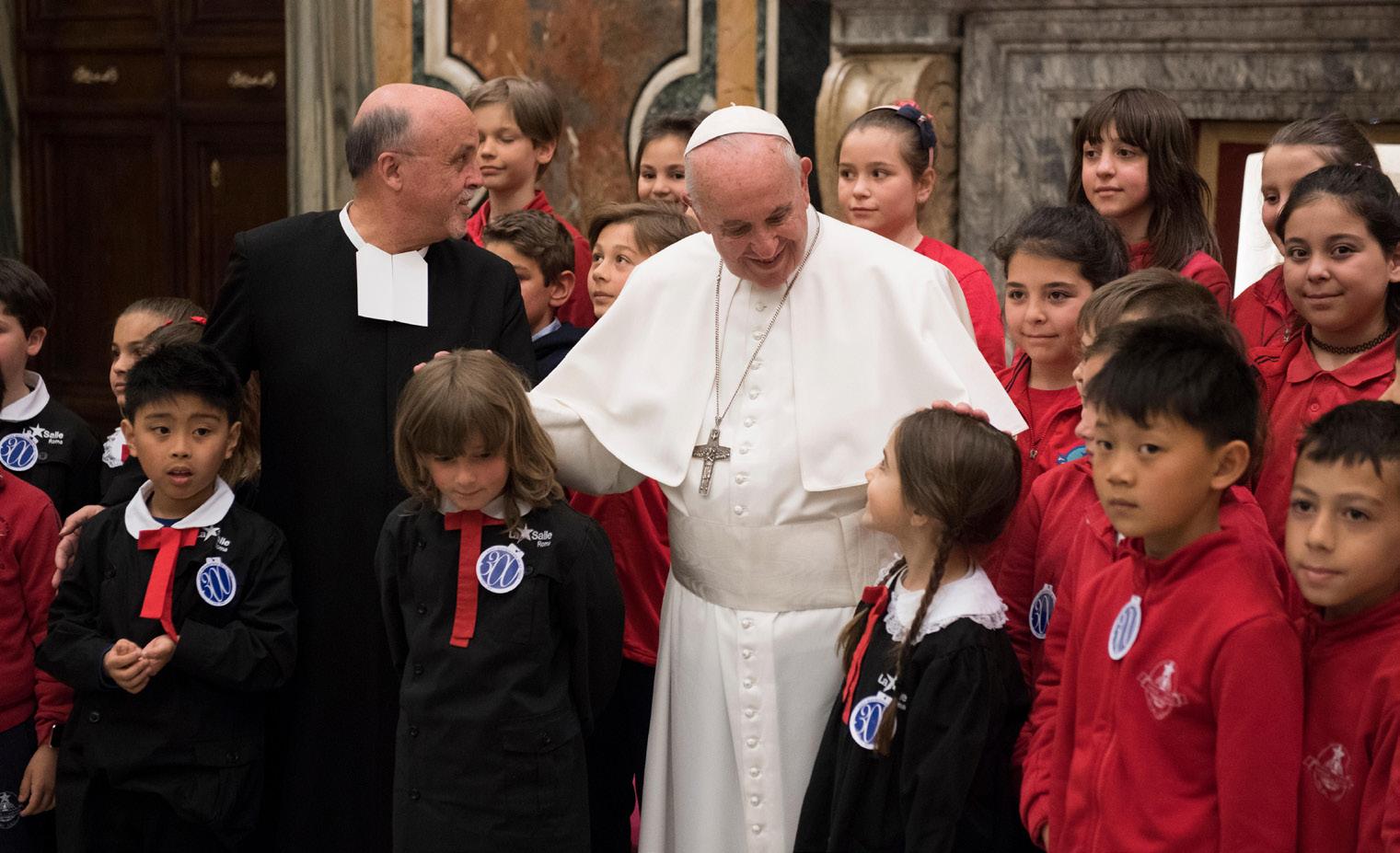
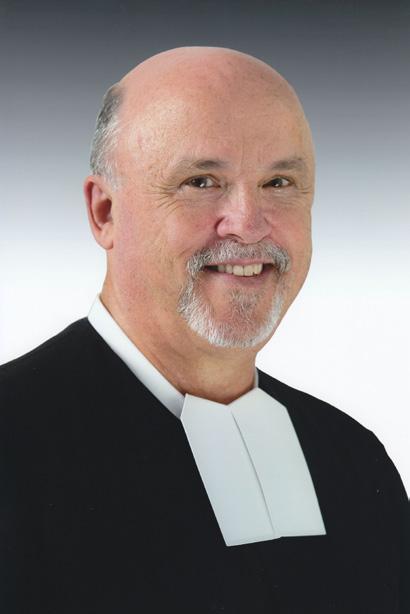
Brother Superior General Robert Schieler, FSC, is currently in the Lasallian Region of North America (RELAN) for a pastoral visit with members of the General Council. In November, Brother Robert is visiting the District of Francophone Canada, the District of Eastern North America and Christian Brothers Conference, the office for the Lasallian Region of North America. He will also give keynote addresses at the Huether Lasallian Confer-
ence and the Congress of the Association of Lasallian Alumni (UMAEL), both of which will be held in Minneapolis, Minnesota, in late November. Brother Robert will visit the District of San Francisco New Orleans and the Midwest District in March 2020. The pastoral visit offers the Superior and General Council opportunities to learn about the vitality and viability of the mission in the Region. During his trip, Brother Robert will meet with key leadership groups, visit with Brothers in the community setting, and spend time with educators and students. The Superior General conducts one pastoral visit to each Region during his term. RELAN is the fifth and final pastoral visit for Brother Robert.
November 24, 2019, will mark the end of the Year of Lasallian Vocations, which highlighted the 300th anniversary of Saint John Baptist de La Salle’s entry into eternal life and celebrated the impact of the mission he started. A number of celebrations, gatherings and initiatives have happened all over the world, including a Papal Audience on May 16, 2019, where Pope Francis welcomed Brothers, Partners and students.
The audience was part of the Lasallian Jubilee Year, which the Holy See declared in honor of the anniversary. The Jubilee Year will end December 31, 2019.
Our next Lasallian theme, Great Things are Possible,” will begin December 1, 2019, with the start of Advent. “Great Things are Possible” is the 2019-2020 theme developed by the Brother Superior and General Council after the 45th General Chapter. Lasallian Reflection 5 accompanies the theme and encourages Lasallians to respond to the challenges facing the world today. The reflection is available at www. lasallian.info.
YEAR OF LASALLIAN VOCATIONS TO END, ‘GREAT THINGS ARE POSSIBLE’ TO BEGIN
NEWS
Lasallians GREAT THINGS ARE POSSIBLE
2019-2020
“
A Papal Audience for Lasallians took place on May 16, 2019, with Brothers, Partners and students. Courtesy Servizio Fotografico –Vatican Media
BUTTIMER, JOHNSTON, LSJI REINVIGORATE LASALLIANS
More than 200 Lasallians renewed their zeal for the mission by participating in a variety of summer formation programs in the Lasallian Region of North America (RELAN).
Lasallians from all four Districts in RELAN, along with participants from Australia, Singapore, Ethiopia, New Zealand, India, Pakistan, South Africa, Hong Kong, the United Kingdom, Vietnam and Kenya, took part in the Buttimer Institute of Lasallian Studies. More than 100 Lasallians gathered at Manhattan College in Riverdale, New York, for the two-week program. Buttimer provides an intensive experience over three summers to study the life and work of Saint John Baptist de La Salle and the origins of the mission, while providing opportunities to build community.
The third cohort of the Brother John Johnston Institute of Contemporary Lasallian Practice had its first in-person gatherings by District over the summer. In the respective gatherings, the 60 partic-
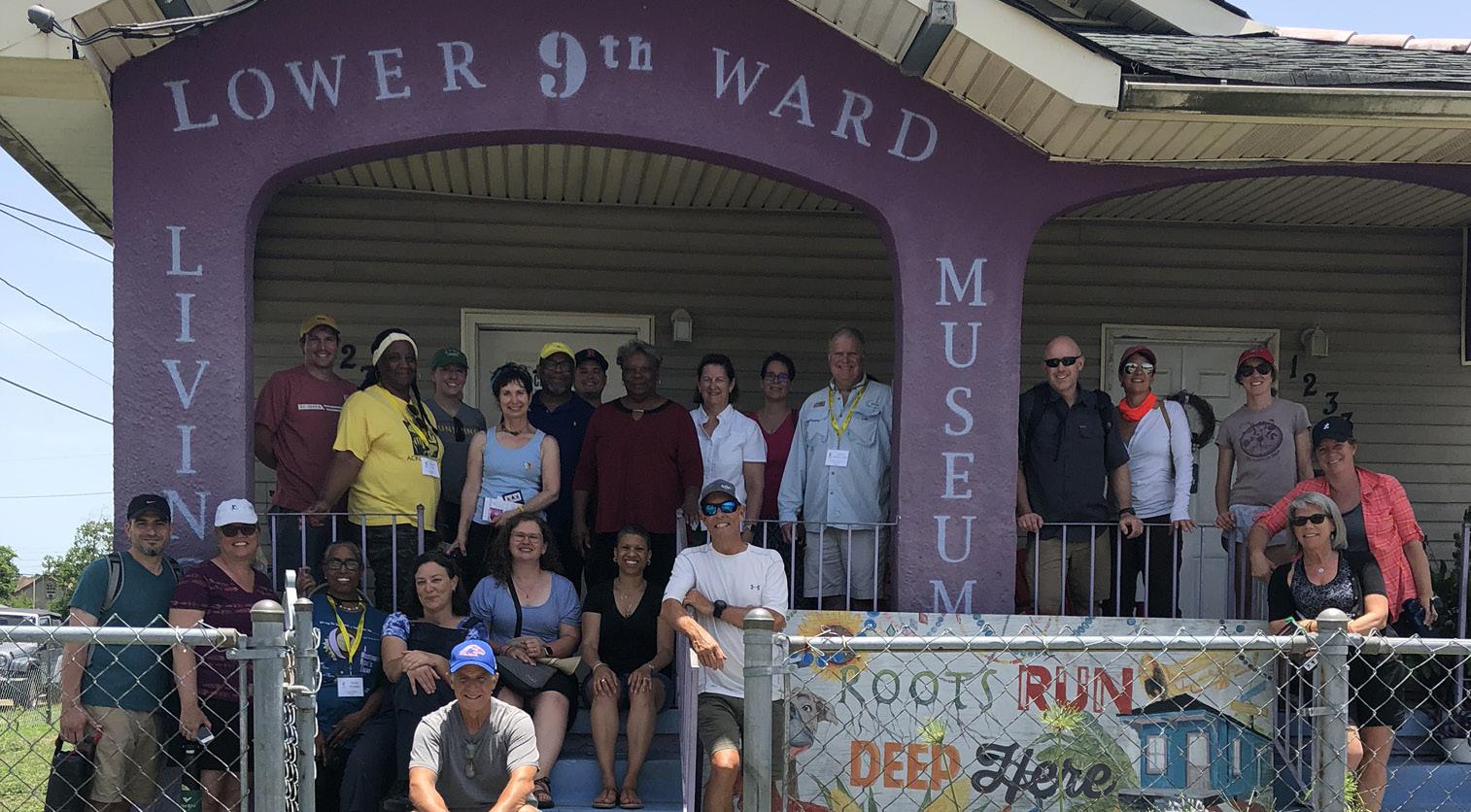
ipants engaged in conversation and reflection on the founding story and vision. They also had time to form community through prayer and socials. They gathered again by District in October. Johnston is a two-year program with five District gatherings and one Regional gathering.
The Lasallian Social Justice Institute (LSJI) explored a new topic in a new location. Focusing on environmental justice, this year’s LSJI took place in New Orleans and opened the eyes of its 20 participants to the realities of the environmental challenges that area faces, such as disappearing coastal wetlands, damage from hurricanes, sustainability and more. In previous years, LSJI has focused on urban challenges, human trafficking, immigration, gang violence, homelessness and civil rights.
Buttimer, Johnston and LSJI are programs of the Office for Lasallian Education at Christian Brothers Conference. Learn more about these formation opportunities at www.lasallian.info/programs-events.
3 | DE LA SALLE TODAY AUTUMN 2019
LSJI participants visit the Lower Ninth Ward Living Museum, which features oral histories of community members and exhibits of key events from the history of the Lower Ninth Ward.
NEWS CONTINUED
REGIONAL VEGA INSPIRES YOUNG LASALLIANS
Forty-nine Young Lasallians from the Lasallian Region of North America (RELAN) and one from the Lwanga District in Africa took part in the Regional VEGA gathering in July at Christian Brothers University in Memphis, Tennessee. VEGA is an acronym for the Italian words Vedere, Giudicare, Agire, meaning See, Judge, Act. Hosted as part of the Year of Lasallian Vocations and supported by the Regional Council of Young Lasallians, VEGA offered a formation opportunity organized by Young Lasallians for Young Lasallians. It included learning more about Lasallian spirituality and pedagogy, along with giving participants time to build community. The first Regional VEGA experience was held in RELAN at Christian Brothers University in Memphis in 2010.
LVS CELEBRATE 30TH ANNIVERSARY
Lasallian Volunteers (LV) is celebrating its 30th anniversary during the 2019-2020 service year with 35 volunteers serving in 18 ministries. Over 30 years, LVs have served in ministries in 19 states throughout the United States, as well as internationally in Kenya, Palestine and Jamaica. A number of events are highlighting the anniversary during this service year, including the kickoff celebration that took place in July at the Brother Charles Kitson Institute for Formation of Lasallian Volunteers at Lewis University in Romeoville, Illinois. In early October, the FSC Awards honored three Lasallians from the District of San Francisco New Orleans at Mont La Salle in Napa, California: Bob Carrejo, The Johnston Faith Award; Carrie Davis, LV 96-00, The Bassen Service Award; and Brother Tom Westberg, FSC, The Farrell Community Award. The remaining celebrations include a gathering for LV alumni on November 23, 2019, at the Huether Lasallian Conference in Minneapolis, Minnesota, along with a Mass and gala to close the year on April 25, 2020, at Manhattan College in Riverdale, New York. Visit www. lasallianvolunteers.org to learn more.
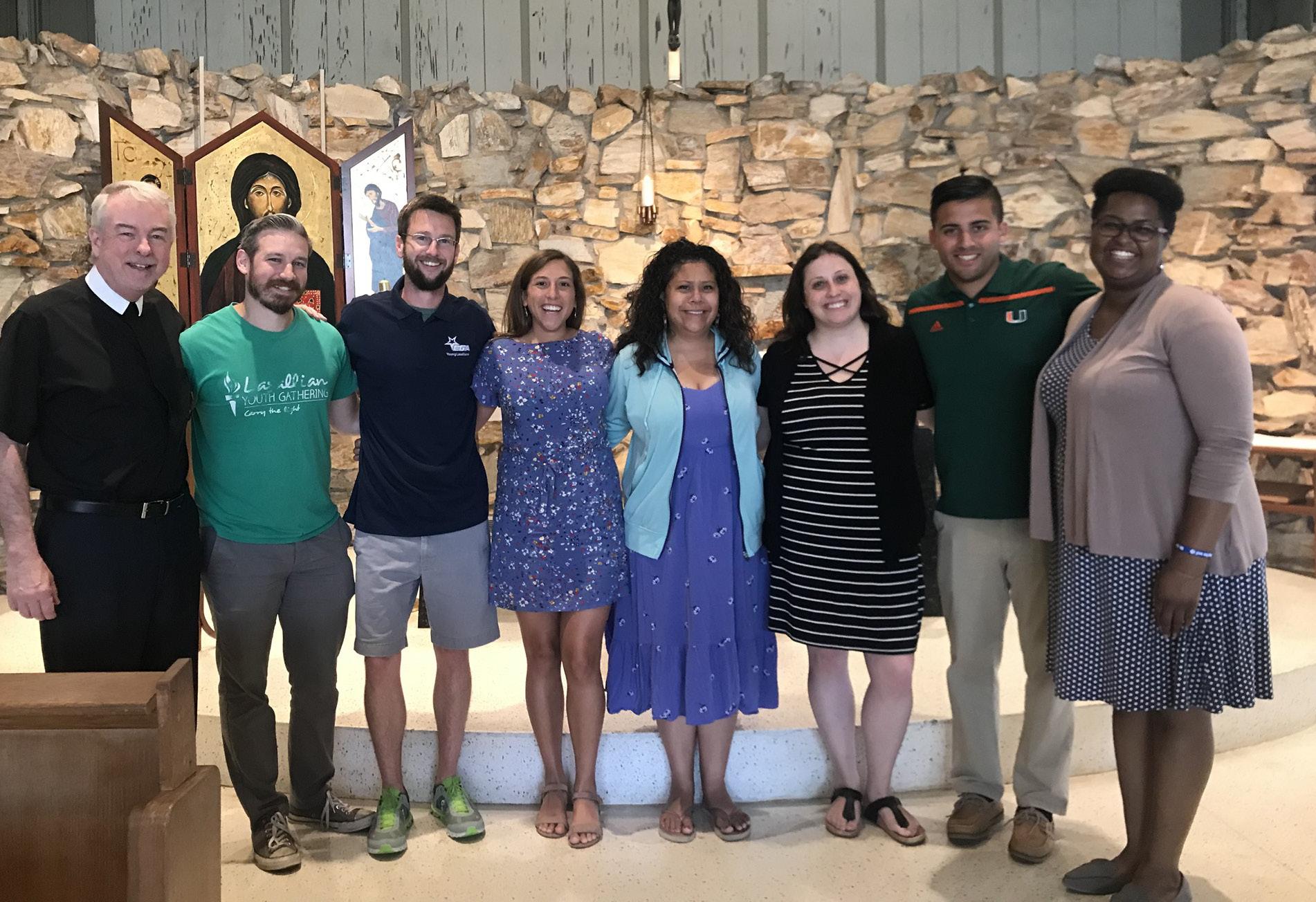
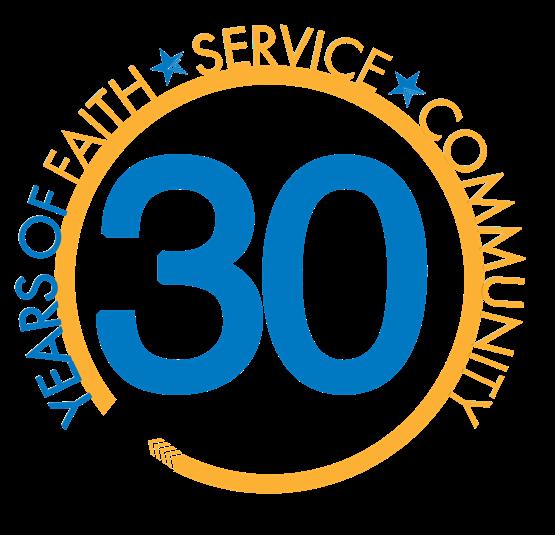
4 | DE LA SALLE TODAY AUTUMN 2019
Brother Timothy Coldwell, FSC, General Councilor, stands with current and former members of the Regional Council of Young Lasallians. Courtesy Abby Michels
DENA CELEBRATES 10TH ANNIVERSARY
The District of Eastern North America (DENA) celebrated its 10th anniversary with two events, a Day of Service on September 9, 2019, and the DENA Association Celebration on November 8, 2019. Hundreds of Lasallians gathered at various locations throughout the District for the November program, which included Brother Superior General Robert Schieler, FSC, who is from DENA, offering remarks from La Salle University in Philadelphia, Pennsylvania. His address was live-streamed to the other geographically central ministries throughout the District that were hosting festivities, including Central Catholic High School, Pittsburgh, PA; Christian Brothers Academy, Albany, NY; Christian Brothers Academy, Lincroft, NJ; Christian Brothers Academy, Syracuse, NY; De La Salle Collegiate High School, Warren, MI; De La Salle “Oaklands,” Toronto, ON; La Salle Academy, Providence, RI; Manhattan College, Riverdale, NY; St. John’s College High School, Washington, D.C.; Saint John Paul II Academy, Boca Raton, FL; and St. Joseph’s Collegiate Institute, Buffalo, NY. Breakout sessions, Q&A sessions, and even celebratory cake were part of the day. DENA was formed in 2009 through the bringing together of the legacy Baltimore, Long Island-New England and New York Districts.
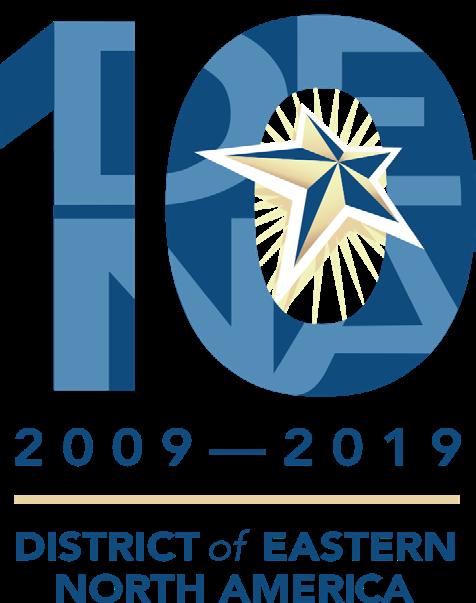
DISTRICT LEADERSHIP ANNOUNCEMENTS
The Districts of the Lasallian Region of North America have announced a number of changes to their leadership. In the District of San Francisco New Orleans, effective July 1, 2019, Brother Nick Gonzalez, FSC, is now Assistant Visitor based at Mont La Salle in Napa, California, and Brother James Joost, FSC, continues his role as Auxiliary Visitor with a move to the Provincialate office in Covington, Louisiana. Brother Lawrence Goyette, FSC, is an Auxiliary Visitor for the District of Eastern North America, effective August 1, 2019, and Brother Florent Gaudreault, FSC, was appointed to serve a second term as Visitor for the District of Francophone Canada, effective May 15, 2019. As previously announced, Brother Michael Fehrenbach, FSC, began his term as Visitor of the Midwest District and Brother Chris Englert, FSC, as Auxiliary Visitor on July 1, 2019.
WANT TO RECEIVE EMAILS WITH LASALLIAN NEWS? EMAIL US AT COMMUNICATIONS@LASALLIAN.INFO 5 | DE LA SALLE TODAY AUTUMN 2019
MIDWEST DISTRICT WELCOMES NEW SCHOOL
With the start of the 2019-2020 academic year, the Midwest District welcomed Resurrection College Prep High School to the Lasallian family. The Sisters of the Resurrection established the all-girls school in Chicago, Illinois, in 1922. With a diminishing number of sisters, they could no longer support the school and wanted to find a new sponsor to help the school continue to thrive. While joining the Lasallian family, Resurrection College Prep High School will retain its strong heritage of the Sisters of the Resurrection.
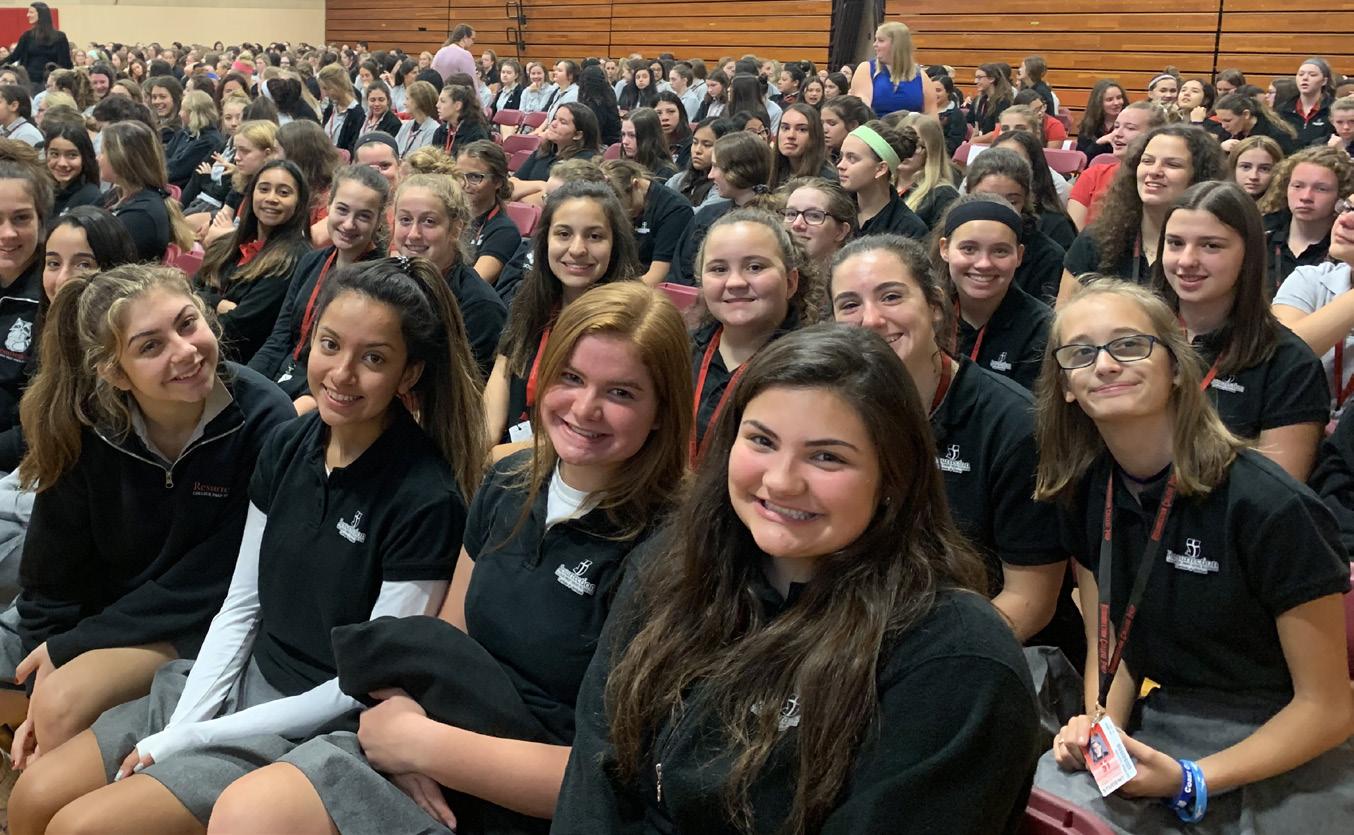
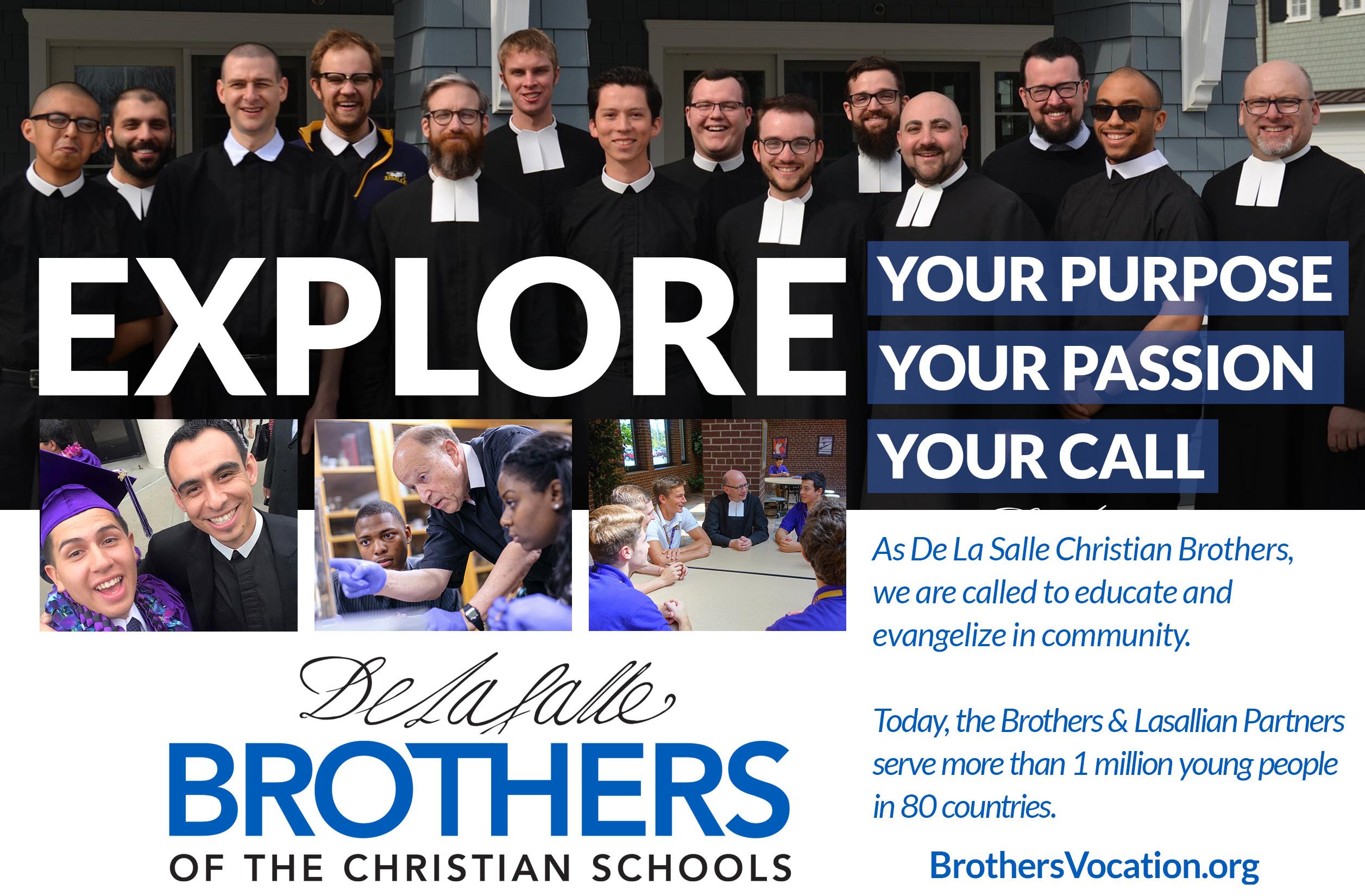
NEWS CONTINUED
Students, faculty, staff and Midwest District leadership celebrated Resurrection College Prep High School’s first school liturgy as a Lasallian ministry on August 26, 2019. Courtesy Midwest District
APPOINTMENTS
BROTHER MICHAEL ANDREJKO, FSC, Director of Vocations, District of Eastern North America, effective July 1, 2019
MAUREEN APPEL, President, San Miguel School, Washington, D.C., effective July 1, 2019
BROTHER THOMAS CASEY, FSC, President, La Salle Academy, New York, NY, effective July 16, 2019
KERRY CONROY, Interim Principal, La Salle Academy, New York, NY, effective August 1, 2019
BROTHER FLORENT GAUDREAULT, FSC, Visitor (second term), District of Francophone Canada, effective May 15, 2019
CHRIS GIANGREGORIO, Principal, De La Salle Academy, Concord, CA, effective May 8, 2019
BROTHER NICK GONZALEZ, FSC, Assistant Visitor, District of San Francisco New Orleans, effective July 1, 2019
BROTHER LAWRENCE GOYETTE, FSC, Auxiliary Visitor, District of Eastern North America, effective August 1, 2019
NATHAN MAUS, Principal, De La Salle Collegiate High School, Warren, MI, effective July 1, 2019
MICHAEL RICHARDS, Principal, San Miguel High School, Tucson, AZ, effective July 1, 2019
ADOLFO SANCHEZ, M.ED., Principal, Cathedral High School, El Paso, TX, effective July 1, 2019
JACK SHANNON, President, Christian Brothers University, Memphis, TN, effective July 1, 2019
RICHELLE SHERWOOD, Director, De La Salle Vocational, Bensalem, PA, effective August 1, 2019
JOSEPH TRAINOR, Executive Director, Martin De Porres Schools, Elmont, NY, effective July 1, 2019
JAY UNDERWOOD, Interim Head of School, George Jackson Academy, New York, NY, effective July 1, 2019
HONORED AS AFSC s, BFSC
Lasallians recognized with Letters of Affiliation (AFSC) have been formally honored by the Institute of the Brothers of the Christian Schools for having served the Lasallian mission in an extraordinary way. Lasallians who receive Letters of Benefaction (BFSC) have been formally honored by the Institute for important services rendered to the Lasallian mission.
LASALLIAN REGION OF NORTH AMERICA
RAFAEL AND VIVIAN MORERA, AFSC, longtime supporters of ministries worldwide
DISTRICT OF EASTERN NORTH AMERICA
FRANCIS G. COLEMAN, AFSC, Vice Chair, Christian Brothers Investment Services, New York, NY
JOHN D. PICOTTE, BFSC, alumnus and longtime supporter of Christian Brothers Academy, Albany, NY
MIDWEST DISTRICT
DAVID HOTEK, AFSC, Lasallian animator, St. Joseph High School, Westchester, IL
ROBERT SCHWENDAU, AFSC, former Brother, resident Partner in the De La Salle Community of Chicago, IL
7 | DE LA SALLE TODAY AUTUMN 2019
FOLLOW US ON FACEBOOK AND TWITTER! FACEBOOK.COM/LASALLIANRELAN TWITTER.COM/LASALLIAN_RELAN
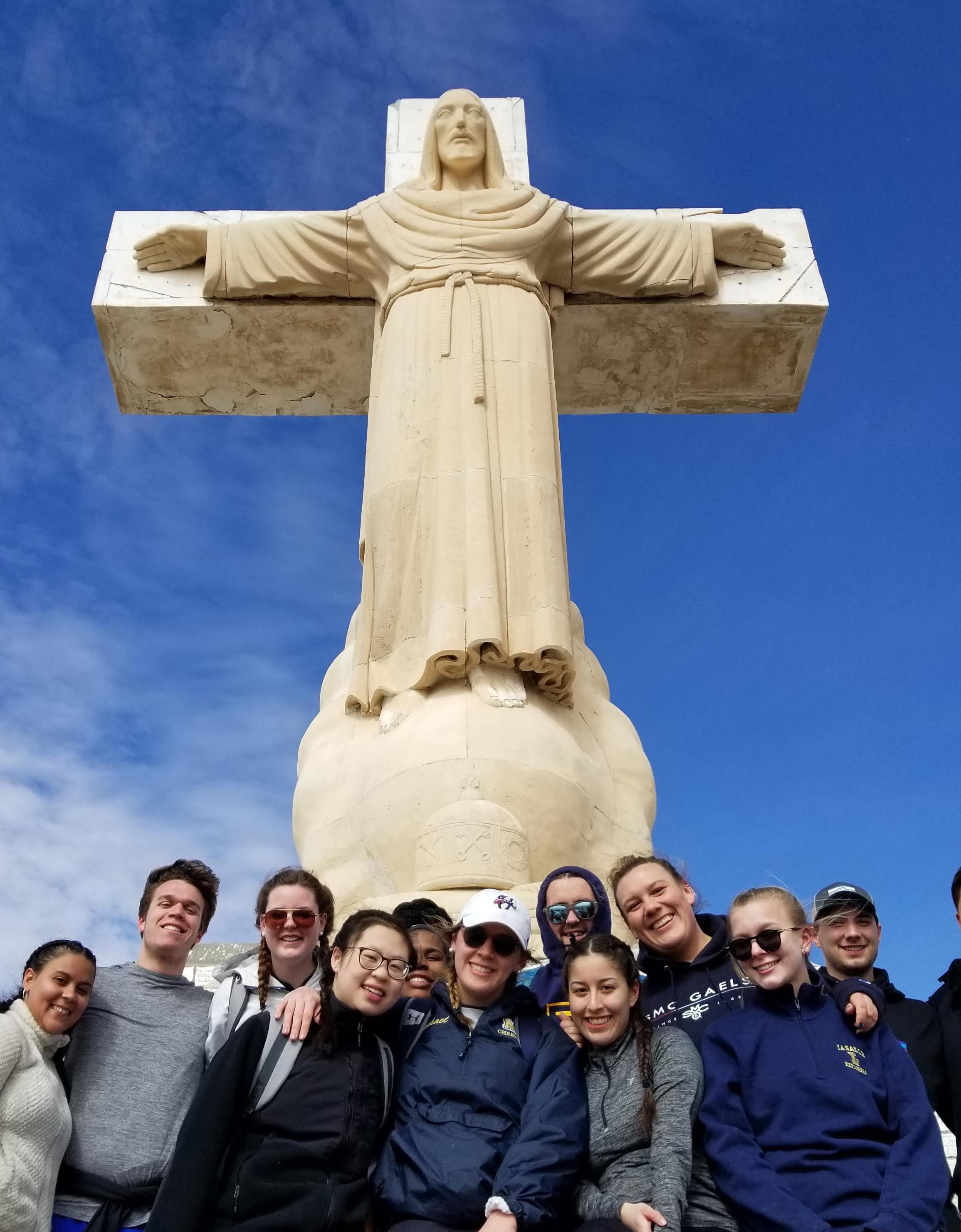
LIVING THE MISSION BEYOND THE BORDERS INTRODUCING
THE BEYOND THE BORDERS INITIATIVES
BY ELIZABETH MOORS JODICE
Saint John Baptist de La Salle and the early Brothers offered accessible education to vulnerable populations by teaching in the native language, educating in a classroom setting, establishing classes for working men, serving delinquent youth, forming teachers with a sense of vocation and mission, and more. These efforts went beyond that day’s social and ecclesial understanding of education in order to serve those on the peripheries of society.
Today, the Institute that De La Salle founded has a new response to reach those in need, one rooted in mission and history, influenced by Pope Francis, and grounded in calls from the 45th General Chapter. The Beyond the Borders initiatives, promoted by the Institute of the Brothers of the Christian Schools’ Solidary and Development Secretariat, are projects that serve those most in need.
An inspiration for this response came from Pope Francis and a message he shared shortly after his election in 2013: “How I would like a Church which is poor and for the poor!” (Audience to Representatives of the Communications Media, March 16, 2013)
Remembering Pope Francis’ words and while looking back on calls and responses from previous General Chapters, two propositions came out of the 45th General Chapter in 2014. The first called for Regions to establish and manage initiatives that meet needs expressed in the metaphor of “beyond borders” (Circular 469, Proposition 19), and the second called for the establishment of an international community of Brothers and volunteers that offers vocation ministry and discernment in the context of a community life dedicated to the service of the poorest (Circular 469, Proposition 27). From there, Circular 470 combined these initiatives with a call to “encourage new educational experiences which, while challenging Brothers and Partners to engage in ‘Beyond the Border’ commitments to urgent contemporary needs among
9 | DE LA SALLE TODAY AUTUMN 2019
SINCE THE VERY FIRST LASALLIAN CLASSROOM, THE MISSION HAS ALWAYS BEEN ONE TO GO TO, AND REACH BEYOND, BORDERS.
El Otro Lado, an immersion program that takes place at the U.S.-Mexico border, is a Beyond the Borders initiative located in RELAN. Courtesy Andres Lopez
LIVING THE MISSION BEYOND THE BORDERS CONTINUED
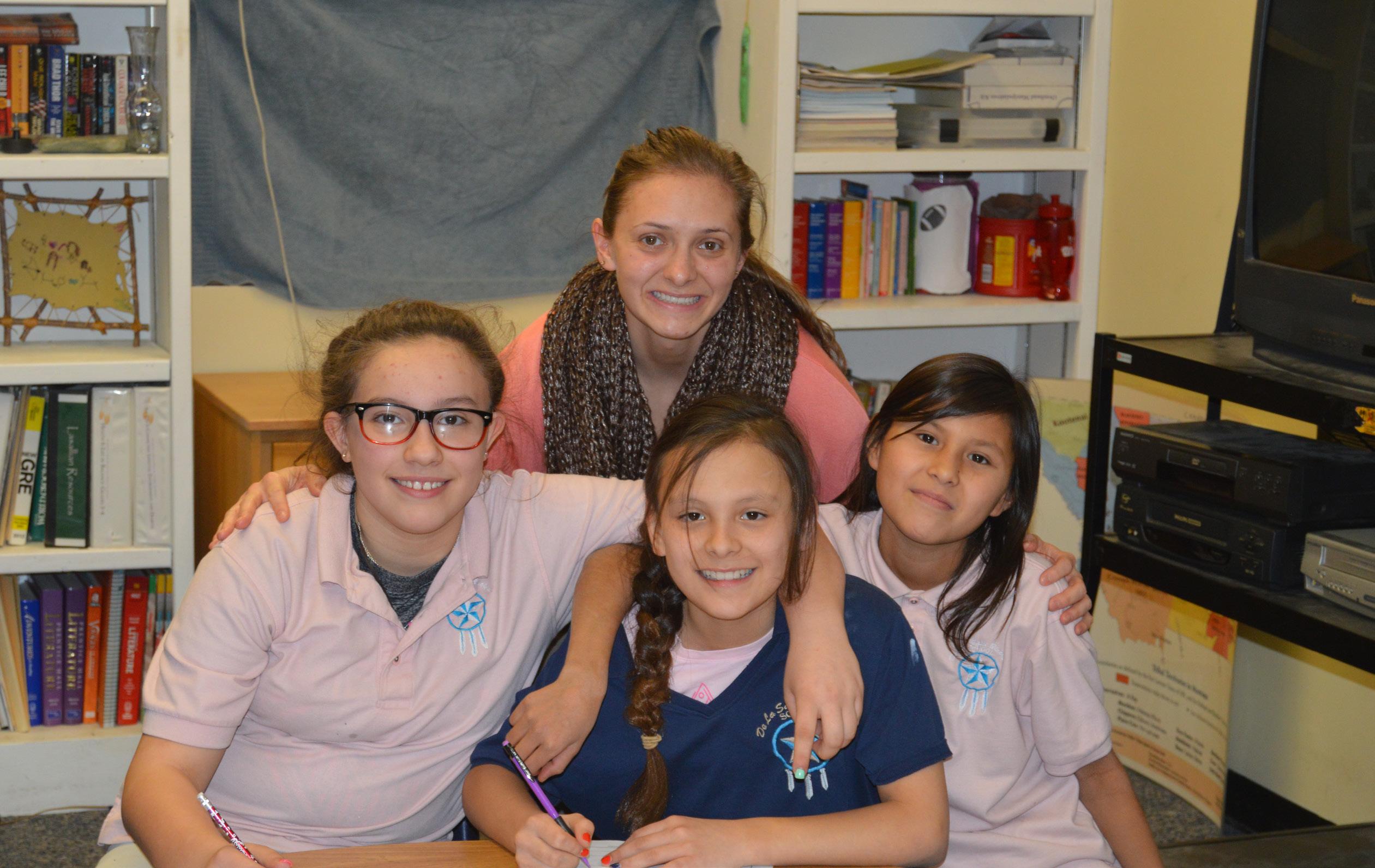
the most vulnerable groups, offer to the members of the community a fraternal environment for vocation discernment” (Strategy 2.4).
To answer these calls, the Institute unveiled Beyond the Borders in May 2019. This response encompasses new and existing projects in each Region approved by the Brother Superior and General Council. The projects, which have varied funding sources, are based on the following criteria, although they do not need to meet each point in full. The project will 1) be inserted in the project of the local Church dealing effectively with the mission needs of immigrants, refugees, the homeless, unemployed youth, and all vulnerable people, especially children and youth that are found on “the borders”; 2) include the existence of a mixed community of Brothers, lay volunteers and/or members of other Religious congregations; 3) be open to include vocation ministry and discern-
ment in the context of a community life dedicated to the service of the poorest; 4) ensure an enriching community life and proper accompaniment of its members; and 5) ensure its sustainability.
In this issue of De La Salle Today, we introduce these initiatives as part of the campaign to promote the Beyond the Borders response. “Separated No More” (page 13) explores the two initiatives located in the Lasallian Region of North America, El Otro Lado at the U.S.-Mexico border in Tucson, Arizona, and El Paso, Texas, and OKI-NI-SOO-KA-WA Blackfeet Immersion at De La Salle Blackfeet School in Montana. “A Worldwide Response to Those in Need” (page 22) shares the six projects located throughout the other Regions. You can also learn more about the projects at www.lasallian.info. •
Elizabeth Moors Jodice is the director of communications at Christian Brothers Conference.
The OKI-NI-SOO-KA-WA Blackfeet Immersion at De La Salle Blackfeet School in Montana is a Beyond the Borders initiative located in RELAN. Courtesy De La Salle Blackfeet School
VIVRE LA MISSION AU-DELÀ DES FRONTIÈRES
PRÉSENTATION DES INITIATIVES « BEYOND THE BORDERS »
PAR ELIZABETH MOORS JODICE
DEPUIS LA TOUTE PREMIÈRE SALLE DE CLASSE LASALLIENNE, LA
MISSION A TOUJOURS ÉTÉ D'ALLER AU-DELÀ DES FRONTIÈRES.
Saint-Jean-Baptiste de La Salle et ses premiers Frères offraient une éducation accessible aux populations vulnérables en enseignant dans la langue maternelle, en éduquant en classe, en établissant des classes pour les travailleurs, en s’occupant des jeunes délinquants, en formant les enseignants qui démontraient un sens de la vocation et de la mission, pour ne mentionner que ceux-là. Ces efforts vont au-delà de la compréhension sociale et ecclésiale de l'éducation actuelle afin de servir ceux qui sont en marge de la société.
Aujourd'hui, l'Institut que De La Salle a fondé, offre une nouvelle réponse pour rejoindre ceux qui sont dans le besoin. Cette réponse ancrée dans la mission lasallienne et son histoire et influencée par le Pape François, répond aux appels du 45e Chapitre général. L'initiative Au-delà des frontières, promue par l'Institut des Frères des Écoles Chrétiennes par l’entremise du Secrétariat Solidarité et Développement, sont des projets qui ambitionnent de servir ceux qui en ont le plus besoin.
Une source d'inspiration pour cette réponse est venue du pape François et en particulier un message qu'il a partagé peu après son élection en 2013 : «Comment je voudrais une Église pauvre et pour les pauvres!" (Audience aux représentants des médias de communication, 16 mars 2013)
Se souvenant des paroles du pape François et en regardant rétrospectivement les appels et les réponses des Chapitres généraux précédents, deux propositions ont émergé du 45e Chapitre général en 2014. La première demandait aux régions de mettre en route « une initiative nouvelle qui réponde effectivement à l’un ou l’autre besoin exprimé dans la métaphore de la frontière et détermine le processus pour l’établir et la gérer. » (Circulaire 469, Proposition 19), et la seconde appelait à la « création d’une communauté internationale de Frères et Volontaires dans chaque Région afin d’offrir un lieu de discernement vocationnel dans le cadre d'une vie communautaire significative au service des plus pauvres. » (Circulaire 469, Proposition 27). À partir de là, la Circulaire 470 a combiné ces initiatives avec un appel à «encourager de nouvelles expériences éducatives qui, tout en
11 | DE LA SALLE TODAY AUTUMN 2019
(Ci-dessous) Des élèves de l'école secondaire des Frères des écoles chrétiennes de Sacramento, en Californie, prient à la barrière frontalière qui sépare les États-Unis et le Mexique. Avec l'aimable autorisation de Sœur Jodi Min, OP
mettant au défi les Frères et Partenaires de s'engager dans 'Au-delà de la frontière', s'engagent à répondre à des besoins contemporains urgents parmi les groupes les plus vulnérables et offrir aux membres de la communauté un environnement fraternel pour le discernement des vocations (Stratégie 2.4).
Pour répondre à ces appels, l'Institut a dévoilé Au-delà des frontières en mai 2019. Cette réponse englobe les projets nouveaux et existants dans chaque Région approuvés par le Frère Supérieur et le Conseil Général. Les projets, qui ont des sources de financement variées, sont fondés selon l’un ou l’autre des critères suivants : Le projet sera inséré 1) dans le projet de l'Église locale qui s'occupe efficacement des besoins missionnaires des immigrants, des réfugiés, des sans-abri, des jeunes chômeurs et de toutes les personnes vulnérables, en particulier les enfants et les jeunes qui se trouvent aux « frontières »; 2) comprennent l'existence d'une communauté mixte de Frères, de bénévoles laïcs et/ou de membres d'autres congrégations religieuses; 3) être ouvert à inclure le ministère des vocations et le discernement dans le
(Droite) Les messages sont laissés du côté mexicain d'une clôture frontalière séparant les États-Unis et le Mexique. Avec l'aimable autorisation de Sœur Jodi Min, OP
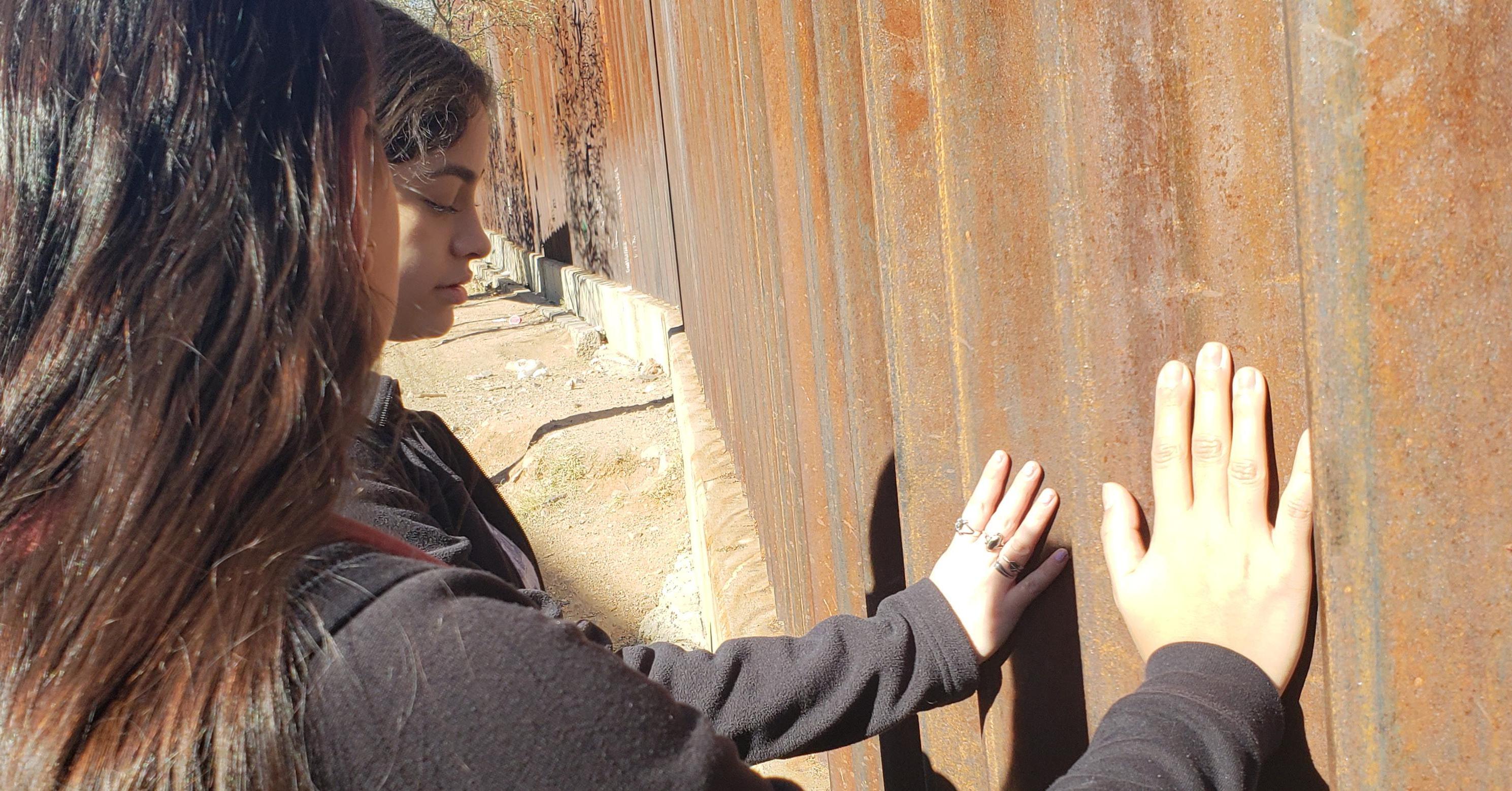
(Right)
contexte d'une vie communautaire dédiée au service des plus pauvres; 4) assurer une vie communautaire enrichissante et un accompagnement adéquat de ses membres; et 5) assurer sa durabilité.
Dans ce numéro de De La Salle Today, nous présentons ces initiatives dans le cadre de la campagne de promotion de la réponse à Au-delà des frontières.
L’article “Separated No More” (page 13) explore les deux initiatives situées dans la région lasallienne de l'Amérique du Nord, El Otro Lado à la frontière des États-Unis et du Mexique à Tucson, en Arizona, et à El Paso, Texas. De même qu’à OKI-NI-SO-KA-WA dans un programme d’immersion des Pieds-Nois à De La Salle Blackfeet School dans le Montana. « A Worldwide Response to Those in Need » (page 22) partage les six projets situés dans les autres Régions. Vous pouvez également en apprendre davantage sur les projets à www.lasallian.info. •
Elizabeth Moors Jodice est la directrice des communications pour Christian Brothers Conference.
Messages are left on the Mexican side of a border fence separating the United States and Mexico. Courtesy Sister Jodi Min, OP
»
(Below) Students from Christian Brothers High School in Sacramento, California, pray at the border fence that divides the United States and Mexico. Courtesy Sister Jodi Min, OP
SEPARATED NO MORE
TWO RELAN IMMERSION PROGRAMS TEACH PARTICIPANTS THAT GOING BEYOND BOUNDARIES IN OUR WORLD CALLS FOR GOING BEYOND THE ONES IN OUR MINDS.
BY BOB CARREJO
Central to the Lasallian educational mission is the responsibility to recognize and respond to human needs. Doing this often requires stepping out of familiar and comfortable environs and into new and challenging ones.
In our schools, service-learning immersion experiences enable participants to cross both social and personal boundaries in order to join with the marginalized of our world in their struggles to find dignity, fulfillment and peace.
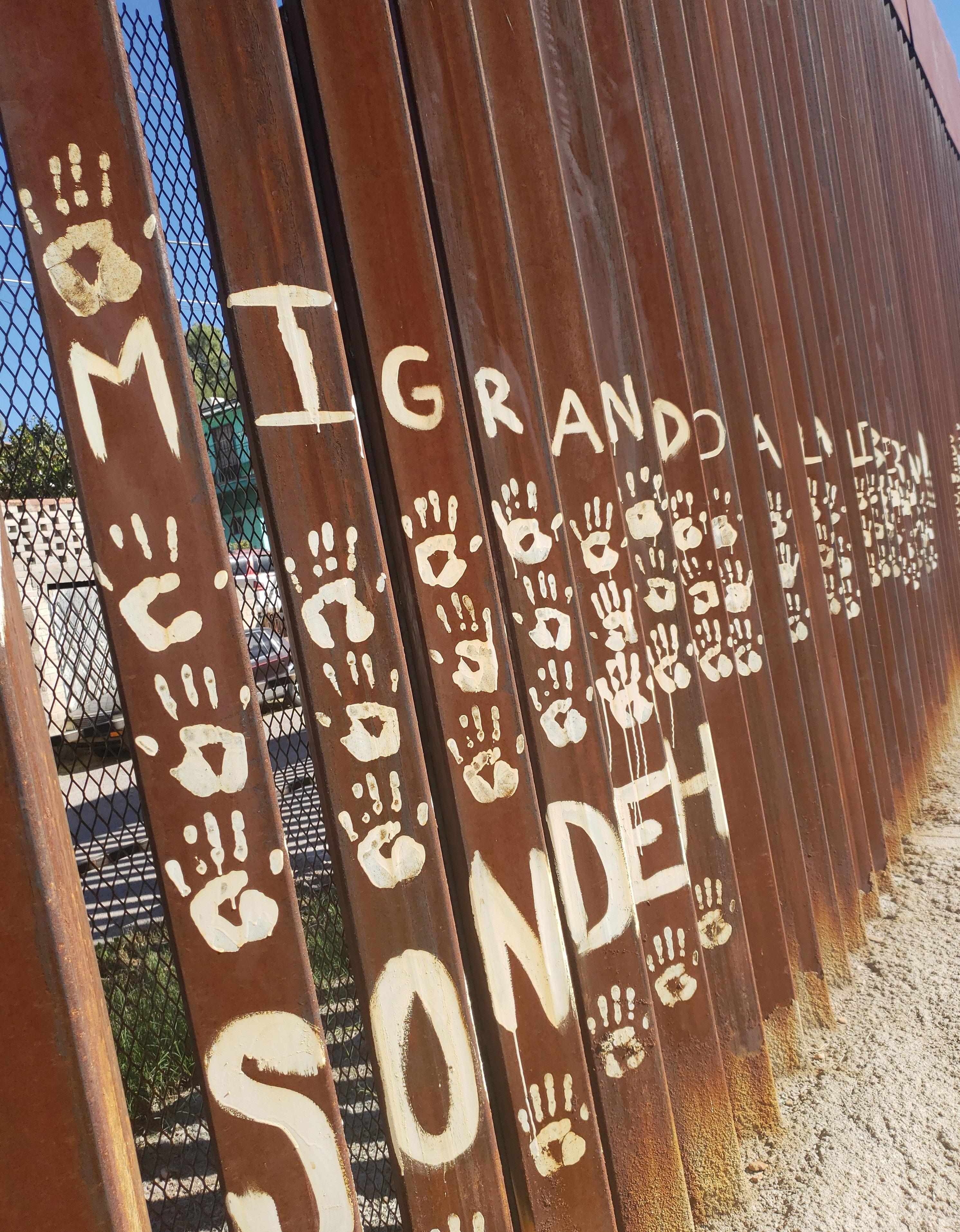
In the Lasallian Region of North America (RELAN), two such experiences are part of the Institute of the Brothers of the Christian Schools’ Beyond the Bor-
ders initiatives, programs that serve marginalized persons in each of the Institute’s five Regions (page 22). One works to respond to issues around populations migrating along the U.S. southern border in search of better lives. The other seeks to focus attention on longstanding educational and social needs of the Blackfeet American Indian Tribe living in northwestern Montana.
13 | DE LA SALLE TODAY AUTUMN 2019
EL OTRO LADO
El Otro Lado (EOL) is a five-day immersion program in the District of San Francisco New Orleans (SFNO). Established in 2008, the program provides Lasallian high school students with first-hand experience of the realities of life for migrants along the U.S.-Mexico border.
The immersion began as a program at San Miguel High School, in Tucson, Arizona, which was its sole sponsor until 2016, when Cathedral High School in El Paso, Texas, was added as a host site. Since 2015, EOL has been coordinated by the Lasallians Without Borders Committee (LWOB), a group of SFNO and District of Mexico Norte representatives that operate in cooperation with the SFNO Office of Education to develop and conduct initiatives to aid in advocacy for vulnerable migrant populations.
EOL was the brainchild of LWOB project manager Alma Mejia-Garcia, who in 2008 was a teacher at San Miguel. She describes the program’s beginning as an outgrowth of an earlier initiative at the school.
“I first took San Miguel students in 2006 to a program I started called VENAVER Tijuana (Mexico),” recalled Mejia-Garcia. “Later, another teacher took over the program but was unable to continue the trips because of a wave of violence that was sweeping the city back then. Brother Nick Gonzalez, who was our principal at the time, recommended that we explore possibilities in our own back yard. After a few months of research, students participated in the first EOL experience in 2008.”
Another early contributor to EOL’s inception, Brother Chris Patiño, FSC, SFNO director of Vocation Ministry and former San Miguel administrator, recalled a defining moment in both EOL’s and LWOB’s development.
“In January 2015,” he remembered, “the District held a Think Tank of San Miguel, SFNO and District of
Mexico Norte representatives to assess the program and consider how to move forward. A vivid memory was of Tucson’s Bishop Gerald Kicanas encouraging the group to do what Lasallians do best—education. I think this has been what makes the program truly Lasallian: committed ‘to provide a human and Christian education’ on this issue that seems to be more and more critical given the unfortunate current rhetoric surrounding immigrants and refugees.”
El Otro Lado is Spanish for “the other side.” The reference is not only to the physical reality of the border between two nations, but also to the human reality of the complexities that geo-political boundaries can introduce into people’s lives. EOL is designed to connect students to facts about people and places in ways that news outlets and social media cannot.
“The students are not told what to learn,” explained Mejia-Garcia. “They are given opportunities to experience different viewpoints and then reflect on them. They are invited to be in solidarity with those who need to migrate, in dialogue with those who do not share their views, and responsibly advocate for just treatment, laws and understanding of the ‘other.’"
Brother Nick, now SFNO Assistant Visitor, has the unique perspective of having participated in both the inception of EOL as principal of San Miguel, and then in its expansion as principal-president of Cathedral High School. For him, EOL’s evolution reflects a cultural and socio-political landscape that, while becoming better known, is yet to be fully understood.
“On the one hand, interest in the border has magnified,” Brother Nick observed. “On the other, unfortunately, so has ignorance and the willingness to accept easy analysis and simple solutions. The program continues to patiently educate participants, to invite participants to examine the realities through the lens of Catholic social teaching, and to see humanity and not simply statistics…to see Christ among the many faces of the migrants.”
14 | DE LA SALLE TODAY AUTUMN 2019
SEPARATED NO MORE CONTINUED 14 | DE LA SALLE TODAY AUTUMN 2019
It is for this kind of engagement and consciousnessraising that EOL gathers its participants. However, it does not stop there. Students are reminded that in the Lasallian tradition learning is always a practical means to a transformative end. They are challenged not only to reflect on the world’s pain, but also to discern what they can do about it.
“It is a goal of the program for young Lasallians to develop the empathy needed to intelligently formulate their views on immigration,” said Mejia-Garcia. “We hope that they then are able to carry the experience with them as they make career choices and participate in a democratic way of life.”
OKI-NI-SOO-KA-WA
De La Salle Blackfeet School is a San Miguel-model school of the Midwest District for fourth through eighth-grade boys and girls who live on the Blackfeet Indian Reservation in Browning, Montana. In 2003, the school began welcoming high school and college students from across RELAN for one-week immersion experiences called OKI-NI-SOO-KA-WA, which means “come and see” in the Blackfeet language.
In the immersion, participants work with students, help around the school, and learn about the history and lives of the Blackfeet people. The lessons and benefits run both ways. As Jon Ficaro, De La Salle Blackfeet immersion director, explained, “Informing these students about the culture and life of the Blackfeet American Indian Tribe not only helps us to realize our specific goal of assisting our own students’ growth toward fulfilling their potential, but also offers to the immersion students a chance to reflect on the poverties that exist within their own communities.”
The program includes time each day in the classroom with students, a speaker series with Blackfeet community members, the experience of shared community living, and trip to Glacier National Park. A recent program addition has been follow-up opportunities wherein staff can accompany participants in their transition back to their “old world,” a world now to be viewed through the lens of their immersion experience.
I think that while getting to know the kids and helping them along with their school work, you learn a lot about yourself,” shared Ryan Dobryznski, a student at La Salle Academy in Providence, Rhode Island, who participated in the immersion in February 2019.
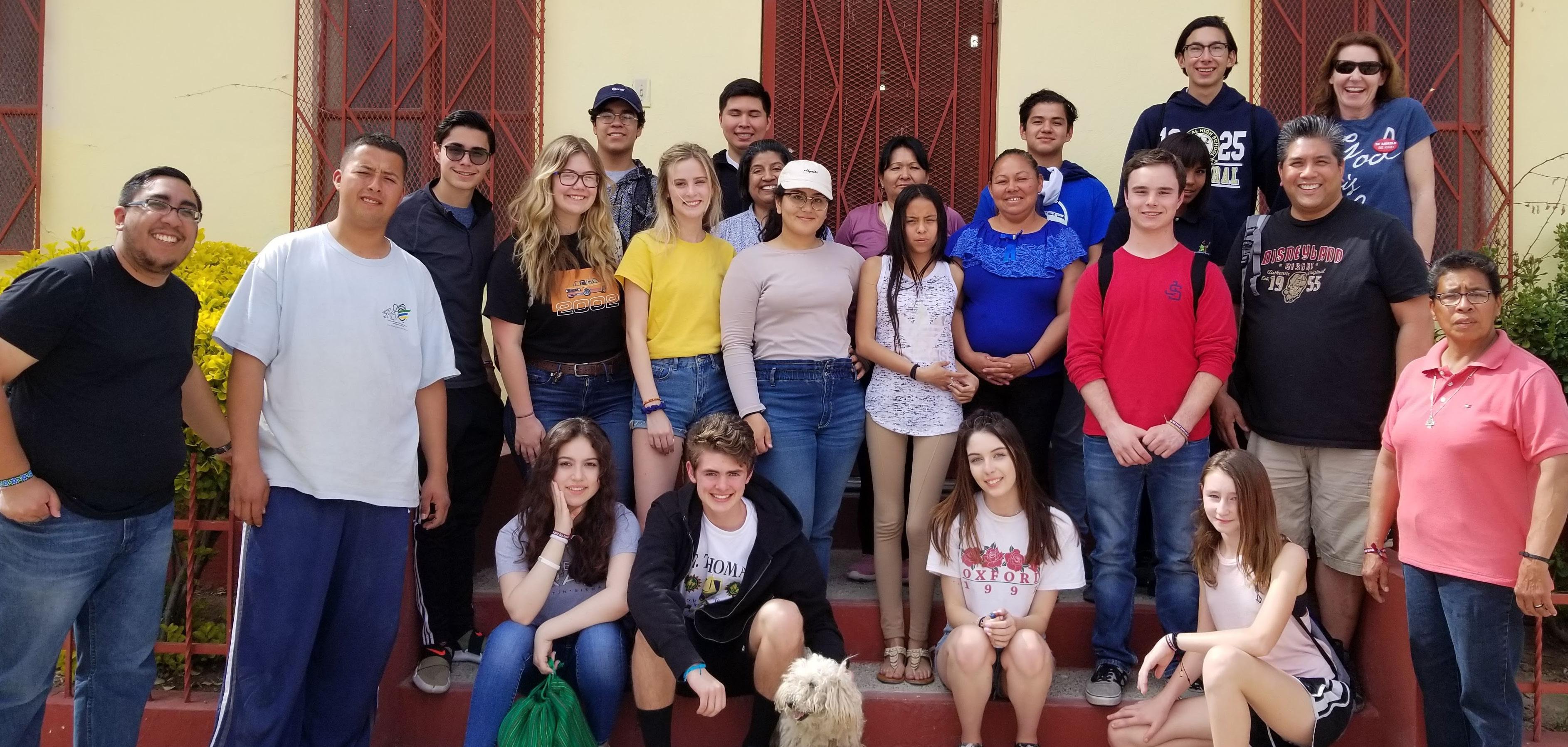
15 | DE LA SALLE TODAY AUTUMN 2019
“
Students from Justin-Siena High School in Napa, California, visit Centro Mujeres Tonantzin, which is operated by the Sisters of Charity of the Incarnate Word to promote gender equality, respect for human rights and social development. The center also has a community garden and offers a scholarship program for students to help them pay for school, supplies, uniforms and other educational needs. Courtesy Andres Lopez
“I know that this experience will make me so much more grateful for everything I have. Seeing how these kids can give a good effort every day and still deal with everything going on in their lives is so inspiring. I am leaving this experience with a definite desire to go off and serve other places.”
True to its Lasallian Catholic tradition, the immersion provides students with a faith formation experience that both invites them to affirm their common bond with all people as children of God and challenges them to move past perceived boundaries to that bond.
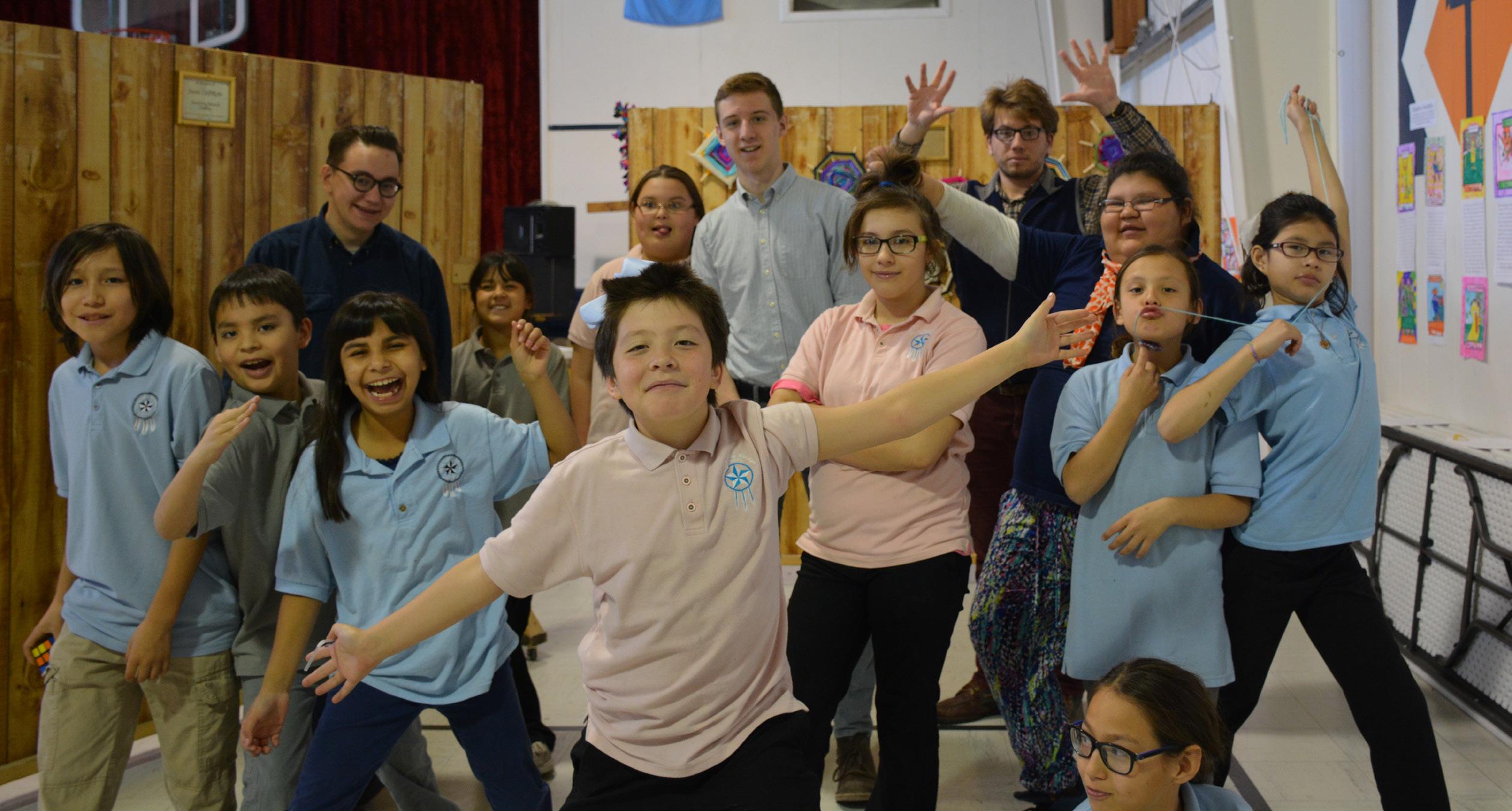
“Ours,” said Ficaro, “is an experience designed to break down the barriers by having participants live a week in an intentional community, in an empathetic spirit and with a shared understanding of poverty and its impact on individuals. Developing a new perception and appreciation of others doesn’t just usher participants through conceived-of barriers, but also demonstrates that these barriers were never there in the first place.”
Central to the participants’ exploration of the effect of poverty on the Blackfeet students and community is being confronted by what lies at its root—the history of systemic discrimination and exploitation of native peoples in the United States. According to
Ficaro, “The legacy of these interactions—largely issues of poverty—has had far reaching effects not only on American Indians as individuals and on their communities, but also on other, seemingly untouched communities throughout the United States. The program is designed so that people can experience the ramifications of this through the lens of our community.”
Ultimately, OKI-NI-SOO-KA-WA’s main contribution to the Institute’s focus on “going beyond boundaries” may be that its participants are moved to learn of not only the realities of the Blackfeet American Indian experience, but also of the humanity of persons who before may have been thought of as distant and different.
“I believe,” reflected Ficaro, “that the constant takeaway for each immersion participant after being in our community and with our students is that the Blackfeet people are full of life and love, which oftentimes surprises visitors who have limited experience in communities affected by poverty. As they engage with our community members, the groups come away with a greater understanding of American Indian history, a different approach to exploring our shared history, an appreciation for diverse cultures, and ultimately a new way to perceive their world.”
16 | DE LA SALLE TODAY AUTUMN 2019
The OKI-NI-SOO-KA-WA Blackfeet Immersion opens the eyes of participants to the struggles students at De La Salle Blackfeet School face. Courtesy De La Salle Blackfeet School
“This experience was life-changing. I loved hearing about the community and history of the Blackfeet. Their story is truly inspiring and has shown me how great community can be,” said Cassidy Meyer, a student at Saint Mary’s University of Minnesota of her March 2019 immersion experience. “I now feel that I understand more of how adversity can affect students. Overall this trip has been educational, and I loved working with the children. They are the future and show the presence of Jesus Christ.”
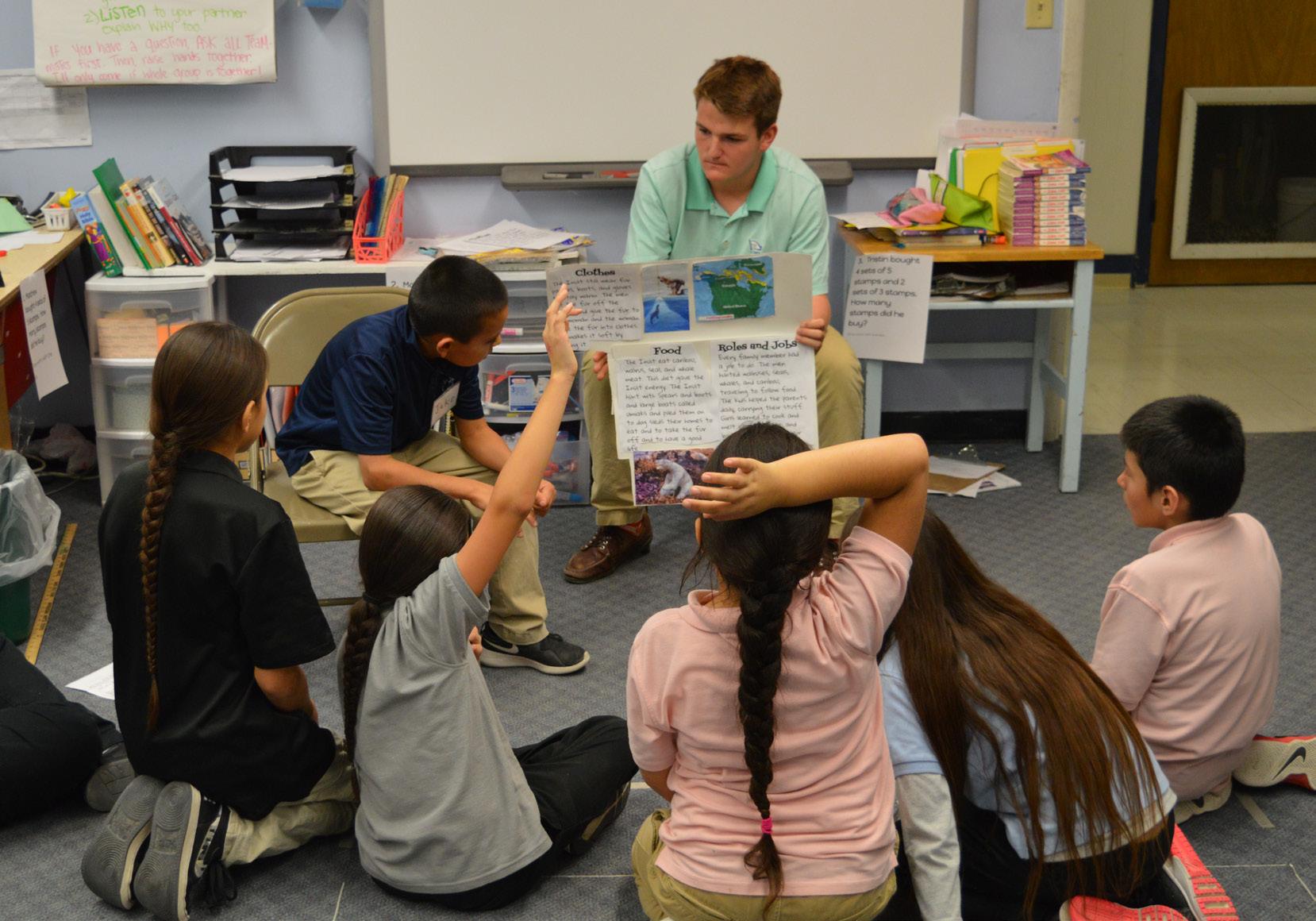
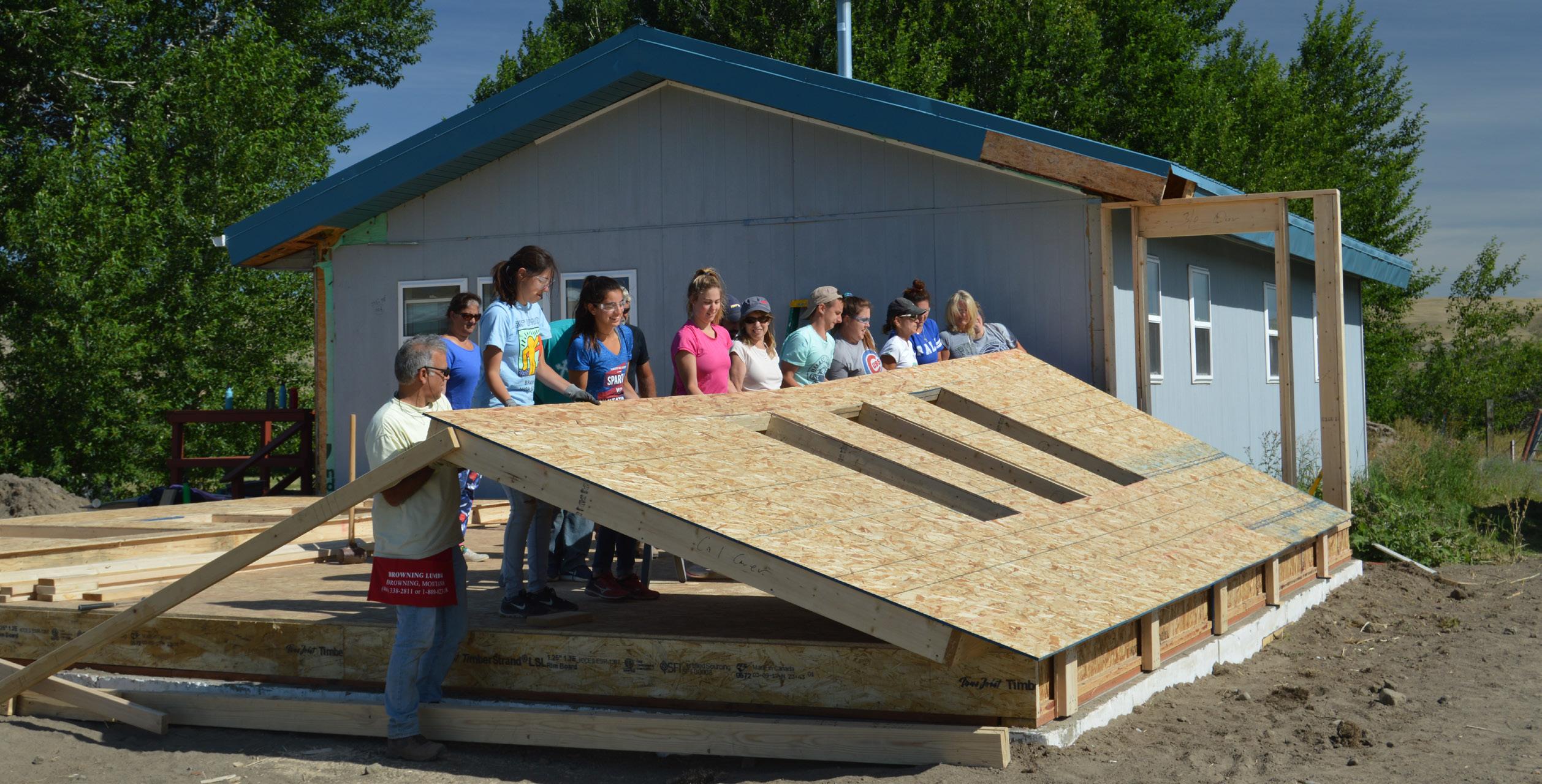
OPENING MINDS AND HEARTS
As statements of the Region’s efforts to form young Lasallians into persons committed to living the Gospel, El Otro Lado and OKI-NI-SOO-KA-WA stand out in the scope of their outreach and the power of their impact. Two programs that cross borders to open minds and
hearts to other places and other lives. Two experiences that overcome boundaries by erasing the distances that created them. •
Bob Carrejo is director of communications for the District of San Francisco New Orleans.
Participants in the OKI-NI-SOO-KA-WA Blackfeet Immersion spend time working with Blackfeet students in the classroom. Courtesy De La Salle Blackfeet School
Volunteers raise up a wall of the bunkhouse addition, which is now complete and used by immersion groups during their weeklong visits to De La Salle Blackfeet School. Courtesy De La Salle Blackfeet School
PLUS JAMAIS SÉPARÉS
DEUX PROGRAMMES D'IMMERSION RELAN ENSEIGNENT AUX PARTICIPANTS QU'ALLER AU-DELÀ DES FRONTIÈRES DANS NOTRE MONDE EXIGE D'ALLER AU-DELÀ DE CELLES QUI SONT DANS NOS ESPRITS.
PAR BOB CARREJO
Dans nos écoles, les expériences d'immersion dans le service communautaire permettent en effet aux participants de franchir les frontières sociales et personnelles afin de se joindre aux marginalisés de notre monde dans leurs luttes pour trouver la dignité, l'épanouissement et la paix.
Dans la région lasallienne de l'Amérique du Nord (RELAN), deux de ces expériences font partie des initiatives de l'Institut des Frères des Écoles Chrétiennes Au-delà des frontières, des programmes au service des personnes marginalisées dans chacune des initiatives des cinq régions de l'Institut (voir page 22). On s'efforce de répondre aux problèmes entourant les populations qui migrent le long de la frontière sud des États-Unis à la recherche d'une vie meilleure. L'autre cherche à attirer l'attention sur les besoins éducatifs et sociaux de longue date de la tribu amérindienne des Pied-Noirs dans le nord-ouest du Montana.
EL OTRO LADO
El Otro Lado (EOL) est un programme d'immersion de cinq jours dans le district de San Francisco / Nouvelle-Orléans (SFNO). Créé en 2008, le programme offre aux élèves du secondaire une expérience de première main de prise de conscience des réalités de la vie des migrants le long de la frontière États-UnisMexique.
L'immersion a commencé en tant que programme de formation à San Miguel High School, à Tucson, Arizona, qui était le seul rrsponsable jusqu'en 2016, lorsque Cathedral High School à El Paso, Texas, s’est jointe au projet. Depuis 2015, EOL est coordonné par le Comité Lasallien Sans Frontières (LWOB), un groupe de représentants de la SFNO et du District du Mexique-Nord qui opèrent en coopération avec le Bureau de l'éducation de la SFNO pour élaborer et mener des initiatives pour la défense et la promotion des populations migrantes vulnérables.
18 | DE LA SALLE TODAY AUTUMN 2019
Au cœur de la mission éducative lasallienne se trouve la responsabilité de reconnaître et de répondre aux besoins humains. Pour ce faire, il faut souvent sortir de l'environnement familier et confortable et se donner de nouveaux défis.
18 | DE LA SALLE TODAY AUTUMN 2019
EOL est l'idée originale d’Alma Mejia-Garcia, chef de projet de LWOB, qui en 2008 était une enseignante à San Miguel. Elle décrit le début du programme comme le résultat d'une initiative antérieure à l'école.
« J'ai d'abord emmené des étudiants de San Miguel en 2006 dans un programme que j'ai commencé appelé VENAVER Tijuana (Mexique), » se rappelle Mejia-Garcia. « Plus tard, un autre enseignant a repris le programme, mais n'a pas pu poursuivre les voyages en raison d'une vague de violence qui balayait la ville à l'époque. Frère Nick Gonzalez, qui était notre directeur à l'époque, nous a recommandé d'explorer les possibilités dans notre propre terrain. Après quelques mois de recherche, les étudiants ont participé à la première expérience EOL en 2008.
Des élèves de Mullen High School à Denver, Colorado, travaillent avec des bénévoles locaux pour transporter des gallons d'eau à laisser aux migrants pendant El Otro Lado. Avec l'aimable autorisation de Sœur
Jodi Min, OP
Students from Mullen High School in Denver, Colorado, work with local volunteers to carry gallons of water to leave for migrants during El Otro Lado. Courtesy Sister Jodi Min, OP
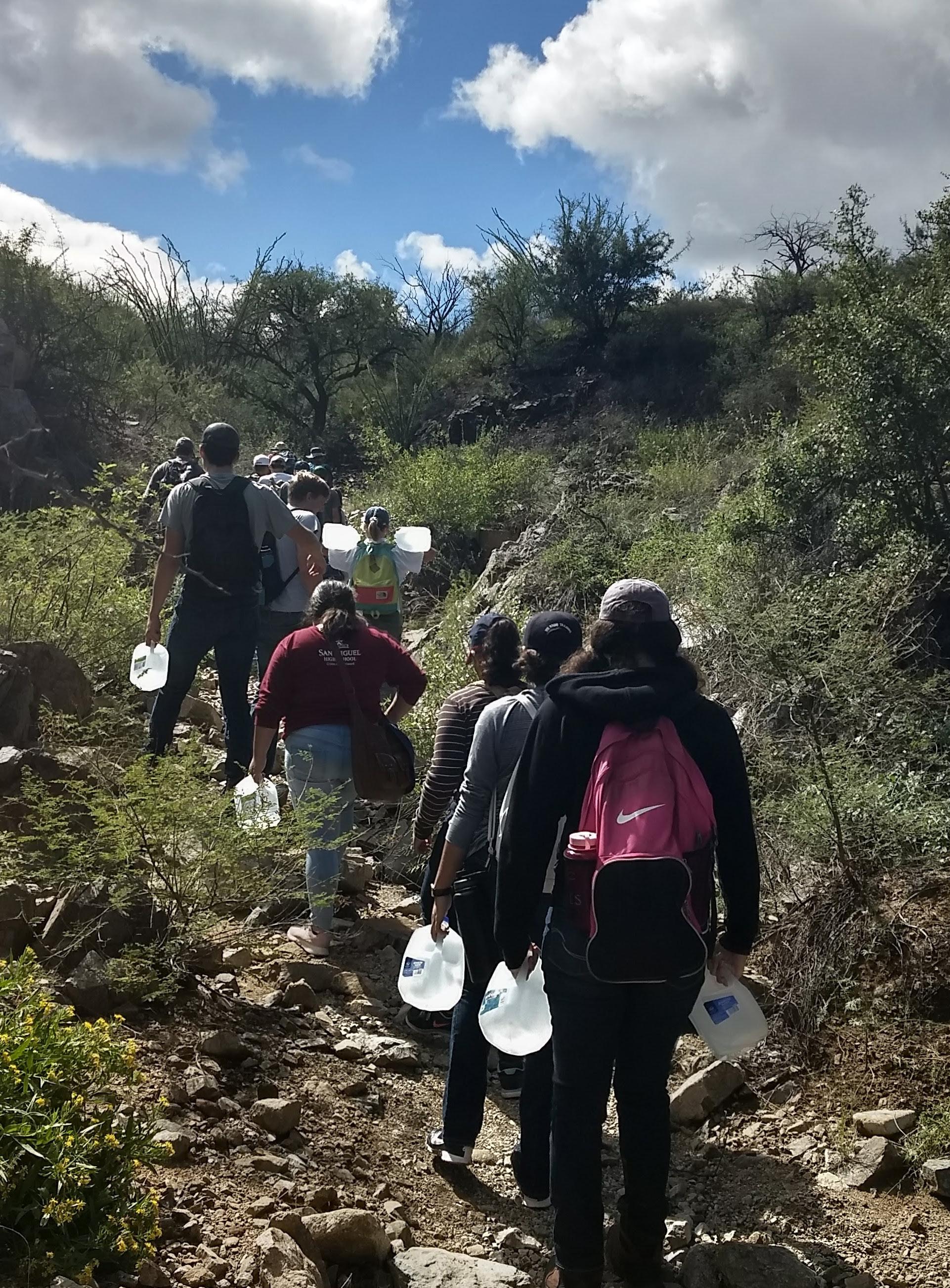
Un autre des premiers contributeurs à la création d'EOL, le Frère Chris Patiào, FSC, directeur du ministère des Vocations de la SFNO et ancien administrateur de San Miguel, a rappelé un moment déterminant dans le développement d'EOL et de LWOB.
« En janvier 2015, se souvient-il, le district a organisé un groupe de réflexion de représentants de San Miguel, de la SFNO et du district de Mexico Nord pour évaluer le programme et réfléchir à la façon d'aller de l'avant. L'évêque de Tucson, Gerald Kicanas, a partagé un souvenir vivant qui encourageait le groupe à faire ce que les Lasalliens font le mieux c’est-à-dire l'éducation. Je pense que c'est ce qui rend le programme vraiment lasallien : il s'est engagé à « fournir une éducation humaine et chrétienne » sur cette question qui semble de plus en plus critique compte tenu de la rhétorique actuelle malheureuse entourant les immigrants et les réfugiés.
El Otro Lado signifie "l'autre côté" en espagnol. La référence n'est pas seulement liée à la réalité physique de la frontière entre les deux nations, mais aussi à la réalité humaine des complexités que les frontières géopolitiques peuvent introduire dans la vie des gens. EOL est conçu pour conscientiser les élèves à des faits sur les personnes et les lieux d'une manière que les médias d'information et les médias sociaux n’arrivent pas à faire.
« On ne dit pas aux élèves quoi apprendre », explique Mejia-Garcia. « Ils ont l'occasion de découvrir différents points de vue et d'y réfléchir. Ils sont invités à être solidaires de ceux qui ont besoin de migrer, en dialogue avec ceux qui ne partagent pas leurs points de vue, et à plaider de manière responsable pour un traitement juste, des lois et une compréhension de l'autre. »
Frère Nick, maintenant assistant Visiteur du district SFNO, a la perspective unique d'avoir participé à la fois à la création d'EOL en tant que directeur de San Miguel, puis dans son expansion en tant que
19 | DE LA SALLE TODAY AUTUMN 2019
PLUS JAMAIS SÉPARÉS CONTINUED
directeur-président de Cathédrale High School. Pour lui, l'évolution d'EOL reflète un paysage culturel et sociopolitique qui, tout en étant mieux connu, n'est pas encore pleinement compris.
« D'une part, l'intérêt pour la frontière s'est amplifié », a observé frère Nick. « D'autre part, malheureusement, l'ignorance et la volonté d'accepter des analyses faciles et des solutions simples l'ont été aussi. Le programme continue d'éduquer patiemment les participants, d'inviter ces derniers à examiner les réalités à travers le prisme de l'enseignement social catholique, et de voir l'humanité et pas seulement les statistiques. Bref, de voir le Christ parmi les nombreux visages des migrants.
C'est pour ce genre d'engagement et de prise de conscience qu'EOL rassemble ses participants. Cependant, cela ne s'arrête pas là. On rappelle aux élèves que dans la tradition lasallienne, l'apprentissage est toujours un moyen pratique d'atteindre une fin transformatrice. Ils sont mis au défi non seulement de réfléchir sur la douleur du monde, mais aussi de discerner ce qu'ils peuvent faire à ce sujet.
« L'objectif du programme pour les jeunes Lasalliens est de développer l'empathie nécessaire pour formuler intelligemment leurs points de vue sur l'immigration », a déclaré Mejia-Garcia. « Nous espérons qu'ils pourront alors porter l'expérience avec eux alors qu'ils font des choix de carrière et participeront à un mode de vie démocratique. »
OKI-NI-SOO-KA-WA
De La Salle Blackfeet School est une école de modèle San Miguel du district du Midwest (MW) pour les garçons et les filles de quatrième à huitième année qui vivent sur la réserve indienne Blackfeet à Browning, Montana. En 2003, l'école a commencé à accueillir des élèves du secondaire et du collège de l'ensemble de RELAN pour des
expériences d'immersion d'une semaine appelées OKI-NI-SOO-KA-WA, ce qui signifie « venez voir » dans la langue des Pieds-Noirs.
En situation d’immersion, les participants travaillent avec les élèves, aident à la vie de l'école et apprennent l'histoire et la vie des Pieds-Noirs. Les leçons et les avantages vont dans les deux sens. Comme l'a expliqué Jon Ficaro, directeur de l'immersion de De La Salle Blackfeet : « Informer ces élèves sur la culture et la vie de la tribu amérindienne Blackfeet nous aide non seulement à atteindre notre objectif spécifique d'aider la croissance de nos propres élèves vers l'accomplissement leur potentiel, mais offre également aux élèves en immersion l'occasion de réfléchir sur les pauvretés qui existent au sein de leur propre communauté. »
« Je pense que tout en apprenant à connaître les enfants et en les aidant à travailler à l'école, vous apprenez beaucoup sur vous-même », a partagé Ryan Dobryznski, un élève de l'Académie La Salle à Providence, Rhode Island, qui a participé à l'immersion en février 2019. « Je sais que cette expérience me rendra beaucoup plus reconnaissant pour tout ce que j'ai. Voir comment ces enfants peuvent fournir un bon effort chaque jour et encore faire face à tout ce qui se passe dans leur vie est tellement inspirant. Je quitte cette expérience avec un désir certain d'aller servir d'autres endroits. »
Des étudiants de la Christian Brothers Academy de Lincroft, dans le New Jersey, écoutent attentivement un garde dxu Parc national des glaciers lors d'une randonnée dans le parc national des Glaciers. Avec l'aimable autorisation de L'école De La Salle
Blackfeet Students from Christian Brothers Academy in Lincroft, New Jersey, listen intently to a Glacier National Park Ranger while on a hike in Glacier National Park. Courtesy De La Salle Blackfeet School

Fidèle à sa tradition catholique lasallienne, l'immersion offre aux élèves une expérience de formation de la foi qui les invite à affirmer leur lien commun avec tous les peuples en tant qu'enfants de Dieu et les met au défi de dépasser les frontières perçues en vertu de ce lien.
« La nôtre, dit M. Ficaro, est une expérience conçue pour faire tomber les barrières en faisant vivre une semaine dans une communauté intentionnelle, dans un esprit empathique et avec une compréhension commune de la pauvreté et de son impact sur les individus. Le fait de développer une nouvelle perception et une nouvelle appréciation des autres n'interpelle pas seulement les participants en s'en prenant aux barrières préconçues, mais démontre également que ces obstacles n'ont jamais été là de premier abord. »
L'exploration par les participants des effets de la pauvreté sur les étudiants et la communauté des Pieds-Noirs est d'être confronté aux racines du phénomène, c'est-à-dire l'histoire de la discrimination systémique et de l'exploitation des peuples autochtones aux États-Unis. Selon Ficaro, « l'héritage de ces interactions, en grande partie sur la question de la pauvreté, a eu des effets considérables non seulement sur les Indiens d'Amérique en tant qu'individus et sur leurs communautés, mais aussi sur d'autres communautés apparemment intactes au travers des États-Unis. Le programme est conçu de façon à ce que les gens puissent en faire l'expérience à travers le prisme de notre communauté.
En fin de compte, la principale contribution d'OKINI-SOO-KA-WA en lien avec l’invitation de l'Institut d’« aller au-delà des frontières » est certainement que ses participants sont émus de prendre conscience non seulement des réalités de l'expérience amérindienne Blackfeet, mais aussi de l'humanité des personnes qui autrefois ont pu être considérées comme lointaines et différentes.
« Je crois, » a reflété Ficaro, « que la prise de conscience de chaque participant du programme d’immersion après avoir été dans notre communauté et avec nos étudiants, c'est que les PiedsNoirs sont pleins de vie et d'amour, ce qui surprend souvent les visiteurs qui ont une expérience limitée dans communautés touchées par la pauvreté. En s'engageant avec les membres de notre communauté, les groupes repartent avec une meilleure compréhension de l'histoire amérindienne, une approche différente pour explorer notre histoire commune, une appréciation pour les cultures diverses, et finalement une nouvelle façon de percevoir leur monde. »
« Cette expérience a changé ma vie. J'ai adoré entendre parler de la communauté et de l'histoire des Pieds-Noirs. Leur histoire est vraiment inspirante et m'a montré à quel point la communauté peut être formidable », a déclaré Cassidy Meyer, étudiante à l'Université Saint Mary's du Minnesota à Winona à propos de son expérience d'immersion en mars 2019. « J'ai maintenant l'impression de mieux comprendre comment l'adversité peut affecter les élèves. Dans l'ensemble, ce voyage a été éducatif, et j'ai adoré travailler avec les enfants. Ils sont l'avenir et démontrent la présence de Jésus-Christ. »
OUVRIR LES ESPRITS ET LES COEURS
Alors que les déclarations des efforts de la Région pour former les jeunes Lasalliens en personnes engagées dans la vie de l'Évangile, El Otro Lado et OKI-NI-SOO-KA-WA se distinguent par la portée de leur rayonnement et la puissance de leur impact. Deux programmes qui traversent les frontières pour ouvrir les esprits et les cœurs vers d'autres endroits et d'autres vies. Deux expériences qui surmontent les frontières en éliminant les distances qui les ont créées. •
Bob Carrejo est directeur des communications pour le district de San Francisco-Nouvelle-Orléans.
21 | DE LA SALLE TODAY AUTUMN 2019
21 | DE LA SALLE TODAY AUTUMN 2019
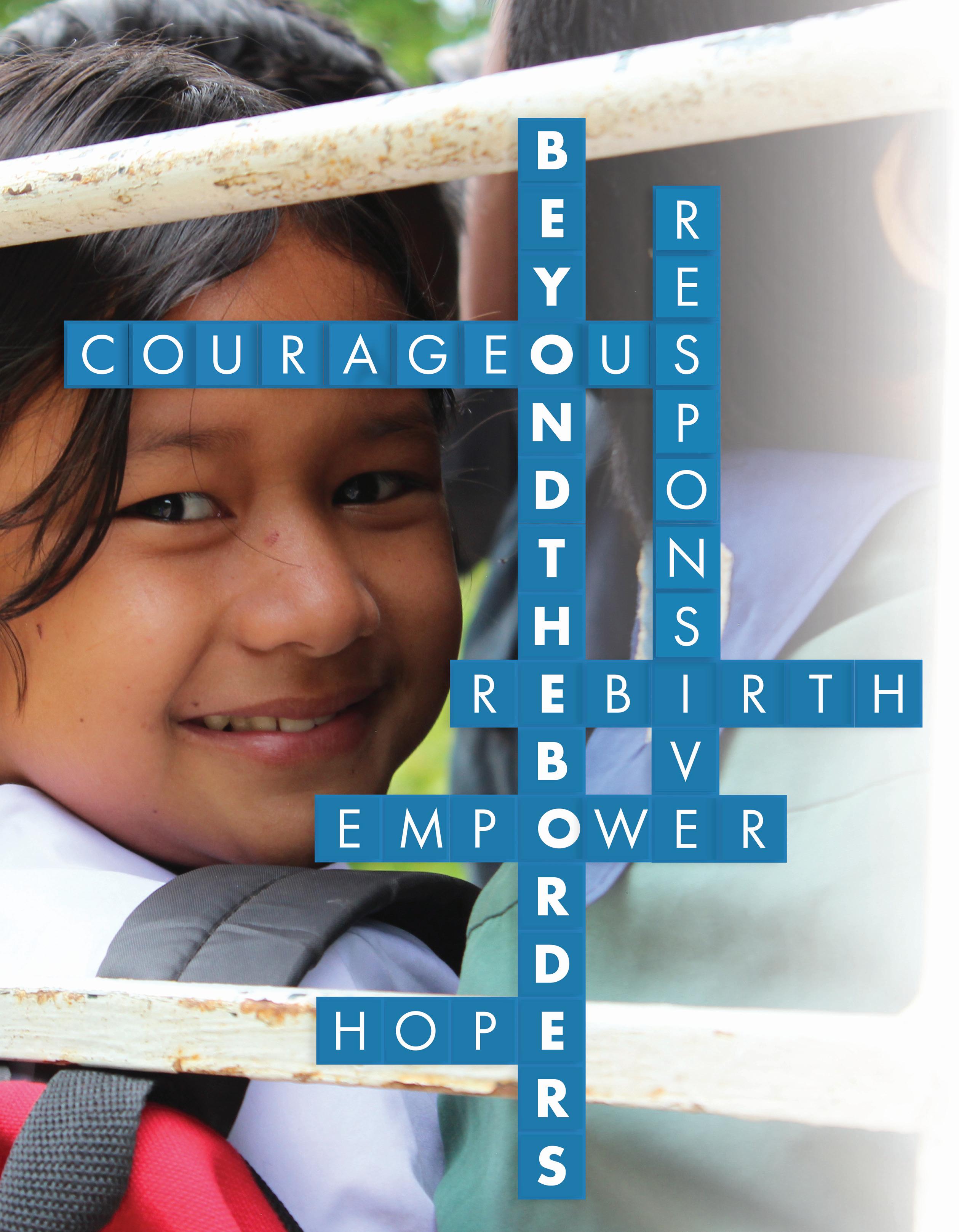
A WORLDWIDE RESPONSE TO THOSE IN NEED
BY BROTHER CRAIG FRANZ, FSC
Six of the Beyond the Borders initiatives, as introduced on page eight, serve communities in need around the world. These empowering programs that you will learn about in the pages ahead offer the hope of a better future to young people and families by providing access to education and personal care.
EMPOWER
It is a well-established daily routine. In Northern Thailand at Three Pagodas pass, hundreds of local forest-dwelling Burmese sleepily cross the border each early morning, walking through the heavy mist to a large Thai rubber factory where they will labor under harsh conditions. Their efforts yield a salary of $50 a month to support the four or five members in their family. The children of these laborers are “stateless,” belonging neither to Thailand nor Myanmar.
Realizing that the children who waited for their parents to finish work were receiving no education, the Brothers creatively started the Bamboo School. The children are transported from the rubber plant and surrounding areas to the school each day where they receive medical care, a hot lunch and an education utilizing the state instructional program. This remarkable endeavor serves approximately 550 students from the kindergarten through sixth grade levels, and the school even has a dormitory
for 23 young girls who otherwise must pass through unsafe areas to attend classes.
Through a special arrangement with the government, graduates of the Bamboo School are granted Thai citizenship status, which opens the door to beneficial social services as well as continuing educational opportunities. The Bamboo School remarkably serves children beyond the border, empowering them with citizenship, knowledge, health and a bright future.
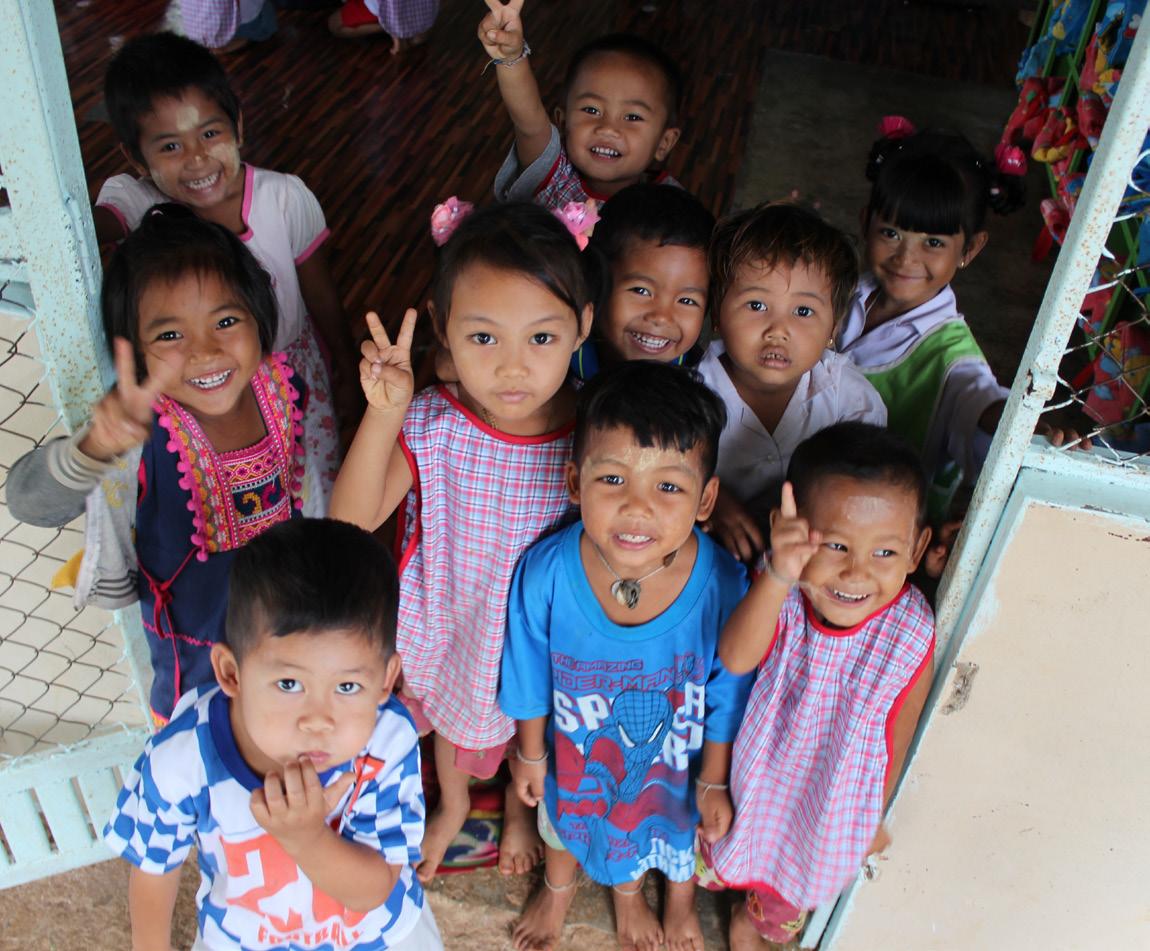 (Left) The Bamboo School opened in 2008 with 40 students. Courtesy the Bamboo School
(Below) The Bamboo School serves students who would otherwise have no access to education. Courtesy the Bamboo School
(Left) The Bamboo School opened in 2008 with 40 students. Courtesy the Bamboo School
(Below) The Bamboo School serves students who would otherwise have no access to education. Courtesy the Bamboo School
HOPE
For youth who have been kicked out, dropped out, or failed out of school, getting a job is almost impossible . . . especially if they live in an underdeveloped country such as Papua New Guinea (PNG). Without vocational training or an academic certificate, PNG’s youth are significantly more likely to involve themselves in crime and become a burden rather than a contributor to society.
Understanding this, the Brothers in Papua New Guinea operate the Hohola Youth Development Center, more recently named La Salle Technical College – Hohola. Since 1973, it has provided a valuable “second chance” for youth to be educated in not
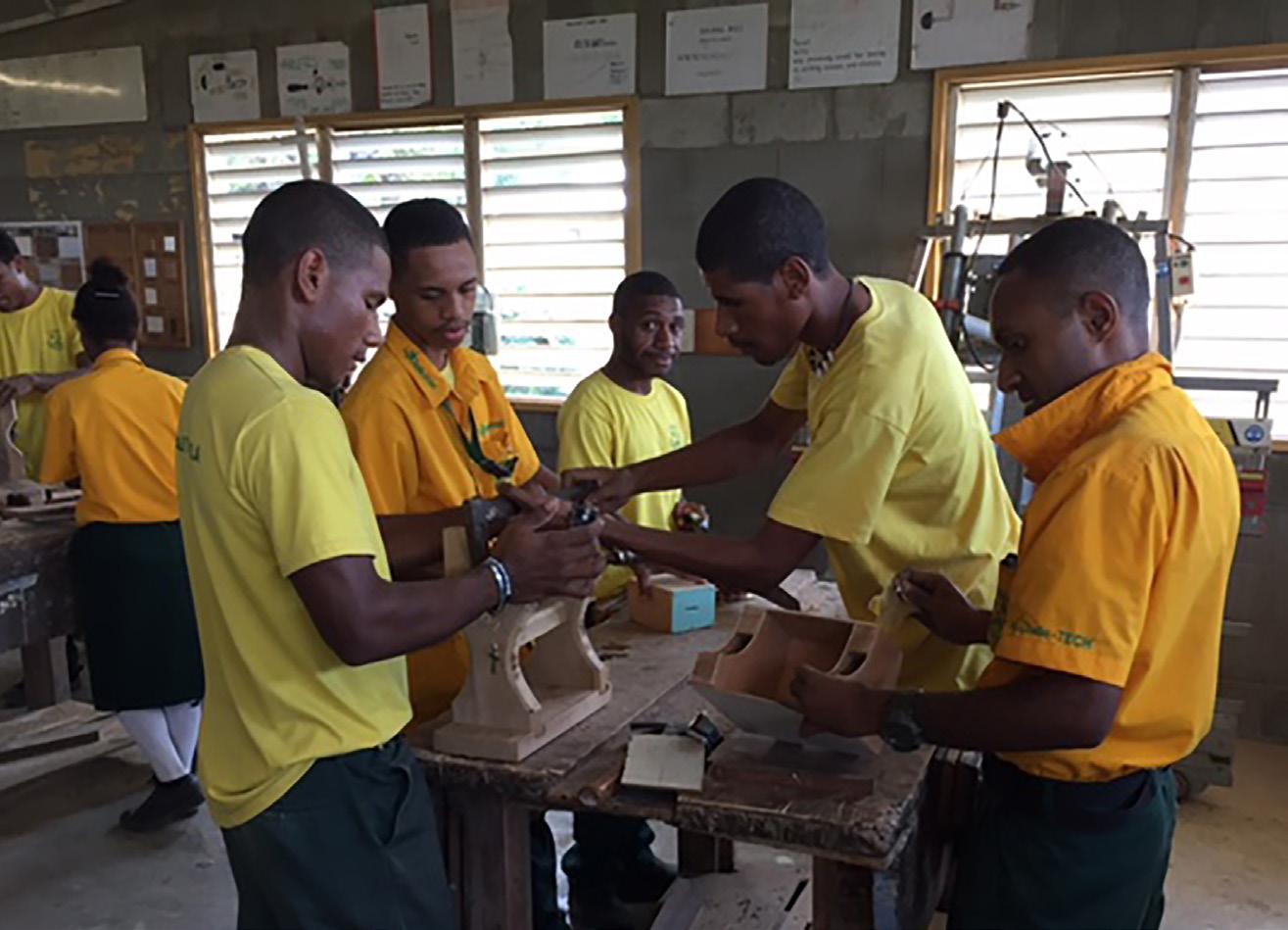
only traditional academic subjects but also technical and vocational skills.
Throughout their four years of study, the 700+ students at Hohola re-focus on achieving good grades while learning a technical skill. And they are enormously successful! Unlike virtually all other high schools, one hundred percent of the students pass their national exams. While some students may continue their education in academic-track schools, all of the students continuing through four years of vocational training are immediately offered employment upon graduation.
Brother Gary Wilson, FSC, remarks that Hohola has always been “a project of hope, an enterprise of hard work, a strong faith-filled commitment, and a dedication to pushing the boundaries” that enables young people to carry their lives forward. For PNG’s youth needing a second chance, Hohola provides both help and hope.
REBIRTH
When South Sudan was born as the planet’s newest country amid widespread civil unrest in 2011, it was not surprising that much of its educational infrastructure had been annexed for military use. In centrally located Rumbek where fighting had raged, many of the schools were damaged or destroyed.
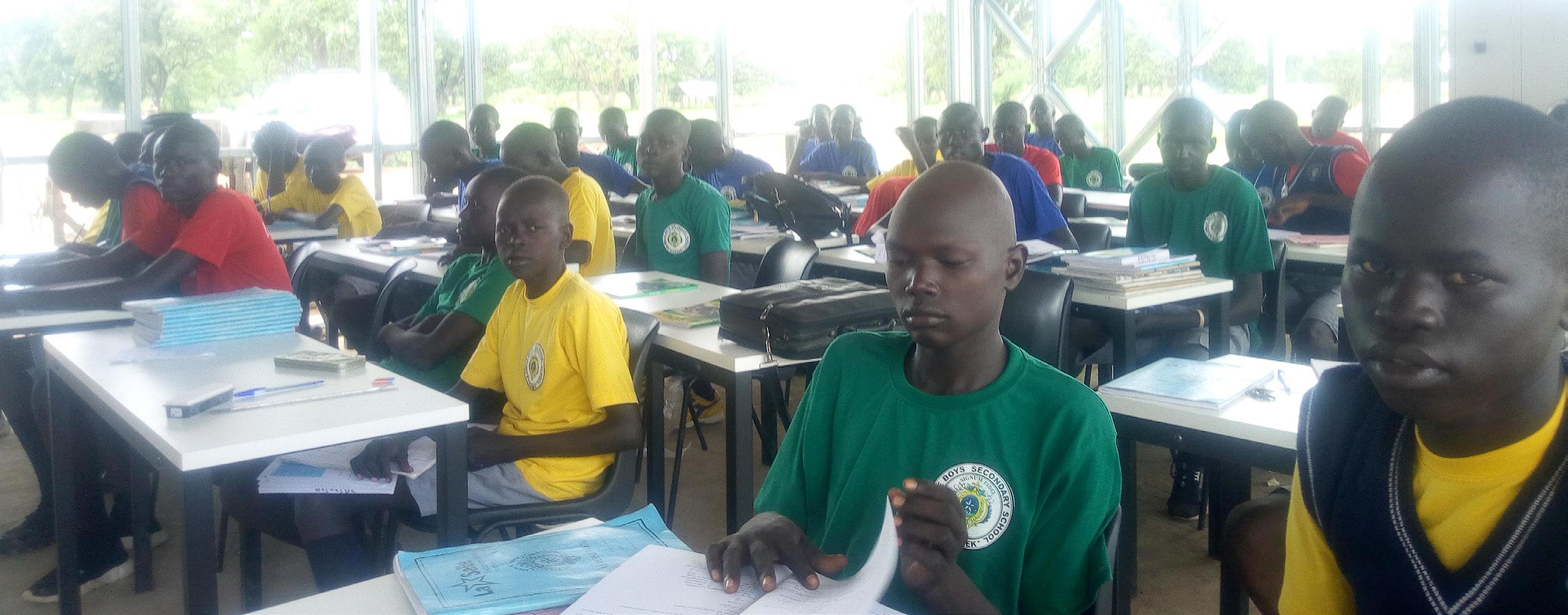 La Salle Technical College – Hohola offers an education focused on academics and vocational skills for young people who need a second chance. Courtesy La Salle Technical College – Hohola
Progress is being made at La Salle School – Rumbek, where students are able to learn in new classrooms as construction continues. They were previously being taught in a facility owned by the Loreto Sisters. Courtesy La Salle School – Rumbek
La Salle Technical College – Hohola offers an education focused on academics and vocational skills for young people who need a second chance. Courtesy La Salle Technical College – Hohola
Progress is being made at La Salle School – Rumbek, where students are able to learn in new classrooms as construction continues. They were previously being taught in a facility owned by the Loreto Sisters. Courtesy La Salle School – Rumbek
Now that peace has returned to the country, Lasallians are going beyond the border to establish a new high school for South Sudan’s youth. Thanks to its composite approach which integrates children rights, trauma healing, and education toward employability, the La Salle School – Rumbek represents a beacon of hope for the more than 300 students who will be educated within its walls.
While many of these students had to leave the area during the civil war, they are now returning to witness buildings being constructed through the generosity of a global Lasallian fundraising campaign. Upon completion, La Salle School – Rumbek will provide a quality high school education for boys much in the same fashion that the nearby Sisters of Loreto provide an outstanding high school for girls.
Through the collaborative efforts of many people on many levels, La Salle School – Rumbek is rising from the rubble of South Sudan’s civil unrest to provide renewal, rebirth, and a new start for hundreds of deserving youth.
COURAGEOUS
A compelling travel story of the Old Testament is when the 120-year-old Moses directs Joshua to succeed him in leadership and take Israel’s people into the promised land. He told them to be “strong and courageous,” but did not provide details as to what they would do, how they would live, and what obstacles they would meet. He merely told them to put their faith in the Lord.
Similarly, the Lasallian Region of Europe/ Mediterranean (RELEM) is journeying forward to establish a new community in Sint-Jean-Molenbeek, Belgium. This neighborhood in the heart of Brussels primarily houses immigrants from Morocco,
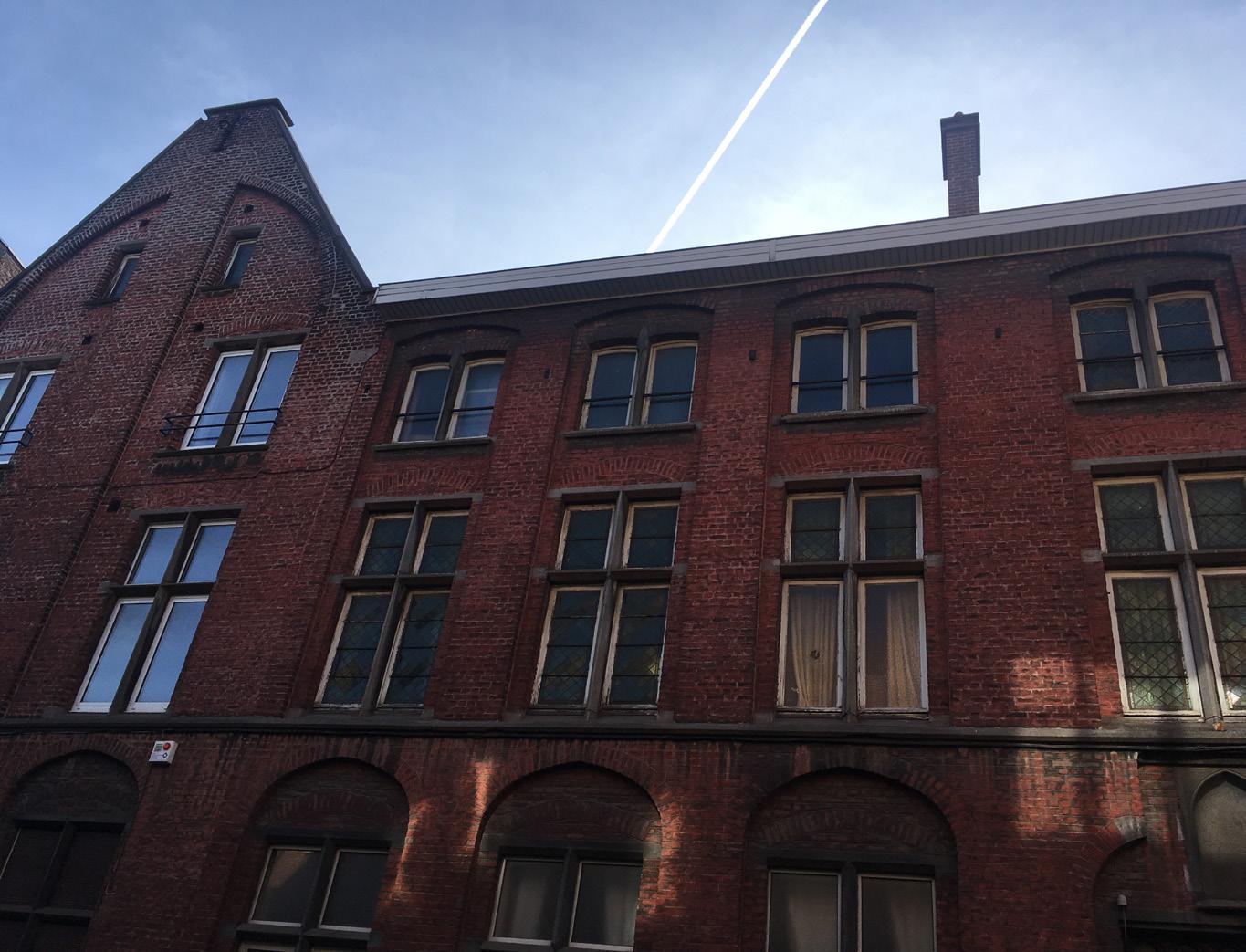
Romania, Poland, Turkey and the Congo. Over 40% of its population is Muslim.
This community opened in September 2019 as an intercultural outreach to area residents needing social and pastoral assistance. The former Brothers’ house is being renovated for a new community consisting of both Brothers and Partners.
Like Joshua, the staff of this community will be uncertain about how best to assist these people; initially, they will be a presence to the local community and church. Through this accompaniment and over time, they will discern how they can serve the unique needs of these transient people by utilizing the community’s collective talents and existing District connections with social service agencies.
The creation of this RELEM community is a bold step forward to maintain the Lasallian presence in Central Europe by assisting society’s neglected who live beyond the borders of traditional social services. It is testimony to RELEM’s being strong and courageous as it journeys forward in service to others.
25 | DE LA SALLE TODAY AUTUMN 2019
25 | DE LA SALLE TODAY AUTUMN 2019
The new community in Belgium is housed in this building. Courtesy RELEM
RESPONSIVE
When Jesus Christ, commanded us to “Go and make disciples of all nations” (Matthew 28:18), he issued a missionary mandate. In the language of the Church, “evangelization” is how we fulfill this charge. It is an invitation to expand the realm of Christ in the world.
Understanding this evangelical call of Jesus to welcome others into his discipleship, the Brothers of the Región Latinoamericana Lasallista (RELAL) have embarked on a missionary response for Lasallians in the remote regions of the Alto Solimões Diocese in Brazil’s Amazon. A new community shouldering these responsibilities will be centered in a “Casa do Migrante” (Migrant House) in Tabatinga and staffed by both Brothers and Partners.
Through missionary and itinerant evangelization, known as Project Além, Lasallians will be responsive to the needs of the eight parishes that are part of the diocese along with its riverside and indigenous communities. Lasallians will exercise their evangelical role, through the training of leaders, catechists and teachers as well as through pastoral activities
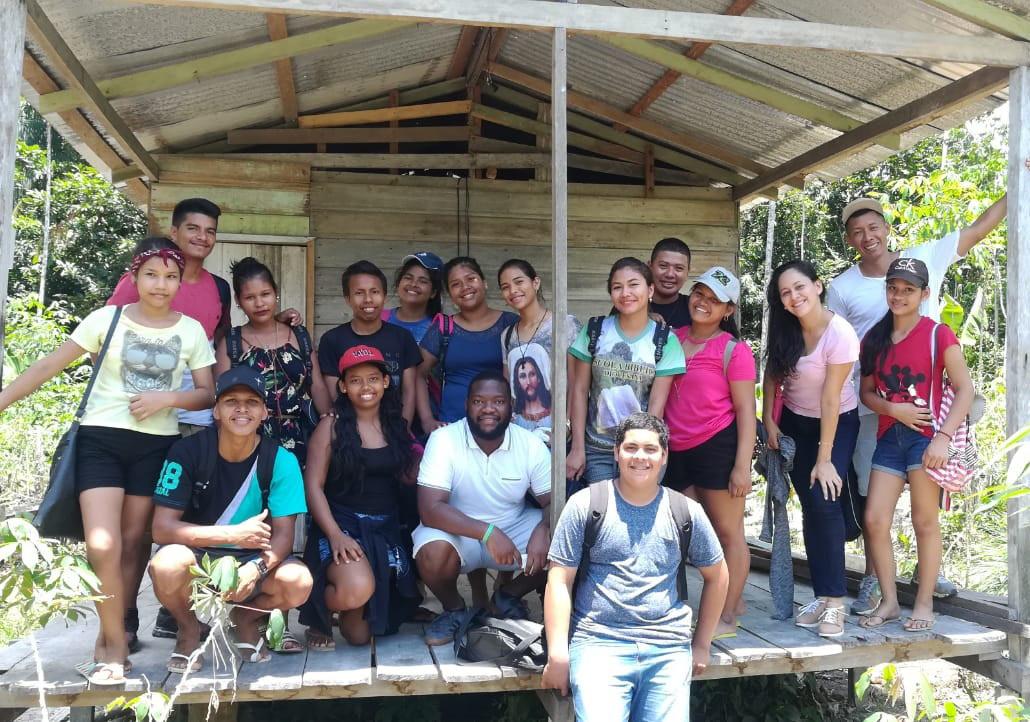
associated with local youth. Currently, four Brothers from Colombia, Venezuela, Brazil and Perú staff the community. Volunteers interested in this ministry are also welcome.
The community is focused on assisting at-risk individuals, and sees the promotion of human and ecological rights as an area of their involvement locally and nationally. Because of the diversity of people, traditions and cultures in the Amazon region, the community will be flexible in its programming and make special efforts to welcome everyone, with particular sensitivity to those who are disenfranchised.
SERVING BEYOND THE BORDERS
The sixth project, to establish a new school and community in Issa, Ghana, is currently in development. These projects, together with the projects located in the Lasallian Region of North America (page 13), are examples of how the mission responds to the needs of today and how the Lasallian family unites to serve our brothers and sisters around the world. •
Brother Craig Franz, FSC, is president and executive director of the La Salle International Foundation, a USAbased development organization that supports Lasallian ministries worldwide. Learn more and donate to these projects at www.lasalleinternational.org.
Special thanks to Laura Ballerini, communications director for De La Salle Solidarity Internazionale ONLUS, for editorial support of this story.
26 | DE LA SALLE TODAY AUTUMN 2019
–
Project Além tailors its programming based on the needs of the diverse communities it serves. Courtesy Project Além
25 YEARS OF TWINNING: BUILDING RELATIONSHIPS BETWEEN STUDENTS IN RELAN AND LWANGA
BY ELIZABETH MOORS JODICE
What’s your favorite subject?” “Do you play any sports?” “What do you want to be when you grow up?” These are the types of questions students ask when the borders of distance and culture are removed. Simple questions. Conversation starters. Relationship builders.
The twinning program between 66 middle and secondary schools in the Lasallian Region of North America (RELAN) and 14 ministries in the Lwanga District of Africa in the Lasallian Region of AfricaMadagascar (RELAF) breaks down these borders and helps young people form relationships as brothers and sisters in the Lasallian family. The program helps students make connections with young people in different cultures, while the schools in RELAN raise money for their twinned ministries in Kenya, Eritrea, Ethiopia and Nigeria. The fundraising supports those ministries on the road to self-sufficiency.
A LONG HISTORY
In 2020, the school-to-school twinning program will officially celebrate 25 years. While the concept of twinning was present before the program’s official launch, the relationship between schools in the then-United States-Toronto Region and the ministries in Africa was formalized with the Lenten season in 1995 in response to a call from the Institute of the Brothers of the Christian Schools to support young and emerging Districts.*
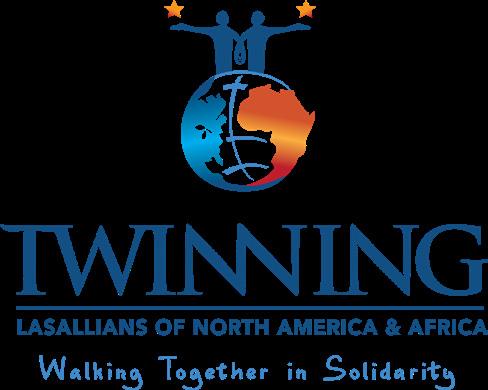
A letter from Brother Dominic Ehrmantraut, FSC, then-Regional Coordinator (and first Visitor of the Lwanga District, 1997-2006), to the directors of education and mission coordinators in the Region formalized the twinning program: “The 1995 Twinning program represents the first time the USA & Toronto Region enters into such an arrangement. Individual Districts over the years have been very much involved in twinning and very successfully so. It is my hope that the Regional twinning program meets with enthusiasm and commitment in the Districts and apostolates throughout the United States and Toronto, Canada.”
Nearly 25 years later, Brother Dominic reflected on his hopes at the start of the program, sharing, “I was hoping that they would establish a relationship with one another. That took time, of course. They began communicating, usually writing postcards. As time went on, with technology and visits, the relationships have really grown. Right now, students on both sides feel connected to their twinned ministries.”
27 | DE LA SALLE TODAY AUTUMN 2019
“
25 YEARS OF TWINNING: BUILDING RELATIONSHIPS BETWEEN STUDENTS IN RELAN AND LWANGA CONTINUED
REALITIES IN LWANGA
The type of African ministries that participate in twinning include traditional schools, vocational training centers, and centers that serve homeless and at-risk youth by providing housing and education. Students in Lwanga face many challenges; many come from very financially poor families and cannot afford education. Some are orphans who lived on the streets before being welcomed into a Lasallian ministry. They often do not have access to basic needs, such as water, food, electricity, adequate housing and health care. Lasallian schools in the Lwanga District meet these needs, as well as give young people hope, prepare them to face challenges, and shape them professionally and morally to contribute to society.
“Lasallian education helps to keep me focused and determined for my future endeavors,” said Samuel Kariuki Maina, a student at Rongai Agricultural and Technical Secondary School in Rongai, Kenya. “It helps a learner to be hardworking, engage God in each and every activity, and emphasizes unity.”
MAKING CONNECTIONS
Students in RELAN learn about their brothers and sisters in Lwanga through a variety of resources provided by Christian Brothers Conference, in addition to their own interactions with students and staff in their twinned ministry. Supported by their Districts, each RELAN school has a twinning coordinator who champions the relationship by providing educational opportunities, facilitating efforts to connect, and helping to coordinate student efforts and fundraisers. Much communication between ministries in RELAN and Lwanga takes place over email or video conferencing, as available.
Cretin-Derham Hall (CDH) in St. Paul, Minnesota, started a Twinning Club in the 2018-2019 school year as a way to build a connection with Bisrate Gabriel School in Dire Dawa, Ethiopia. In its first year, club members led the twinning prayer as part of announcements, spoke to religion classes, created displays, provided an Ethiopian dish for sampling, and organized fundraisers.

“The twinning program at CDH has given me an incredible opportunity to give back to other children my age and adults in Ethiopia,” said Twinning Club President Ethan Thompson ’20. “It was inspiring to see our committee start very small and grow into a schoolwide goal to raise money for Bisrate Gabriel School.”
MEETING FACE-TO-FACE
Over the years, a number of schools have visited their twinned ministries in Lwanga and more trips are being planned. In 2018, Mullen High School in Denver, Colorado, hosted its first trip to Ethiopia. Fourteen students and two faculty members visited St. John Baptist de La Salle Catholic School in Addis Ababa, Mullen’s twinned school, and Bisrate Gabriel School. The students attended classes, taught songs, played sports, and bonded with the students. Mullen plans to return to Ethiopia in 2020.
28 | DE LA SALLE TODAY AUTUMN 2019
Ethan Thompson, president of the Twinning Club at Cretin-Derham Hall in St. Paul, Minnesota, places materials for a display about Bisrate Gabriel School in Dire Dawa, Ethiopia. Courtesy Cretin-Derham Hall
“A powerful benefit of our trip was how it raised everyone’s awareness of Mullen’s place in the larger Lasallian family, as well as their individual roles in advancing the Lasallian tradition,” Elliot Gray, Mullen teacher and twinning coordinator, wrote in a reflection for the District of San Francisco New Orleans website.
The District of Eastern North America (DENA) hosted two extended trips to the Lwanga District in 2014 and 2016, along with a shorter visit in 2018, to strengthen twinning relationships. Each trip included visits to twinned ministries, where educators had the opportunity to interact with students and teachers, and get to know more about their lives, their cultures and the impact of the Lasallian mission. They brought their experiences back to their classrooms.

“The DENA ‘Come and Be’ program has provided opportunity to deepen our Lasallian association,” said Maryann Donohue-Lynch, associate executive director for DENA’s Office for Mission and Ministry, who serves as the District’s twinning coordinator. “When you experience the ‘story’ of another by accompanying them in their daily reality, it is transformative and connects you to the Lasallian mission in a privileged way.”
DENA is collaborating with the Lwanga District to organize a celebration in Nairobi, Kenya, in 2020 to celebrate 25 years of twinning and to plan for the future. It is the hope that a number of Lasallian adults from RELAN and Lwanga will participate.
Brother Ghebreyesus Habte, FSC, who became the Lwanga Visitor in 2014, has visited RELAN three times, in 2014, 2017 and 2019. Each time, he visited schools, interacting with students— even playing basketball with them—and learning about life on campus, while sharing realities of life in Lwanga and at the RELAN school’s twinned ministry. With each visit, he used the theme of walking hand-in-hand to build a connection between the schools.

“I think the personal relationship, making a physical symbol (walking hand-in-hand, playing basketball) is important with the RELAN students because it will remain in their mind and be remembered always when they think about their twinned schools,” said Brother Ghebreyesus.
“It was very inspiring knowing that there are other schools with the same mission and in many ways so similar to us. They teach like us with their focus on God,” said Eric Rodriguez, an eighth grade student at The De La Salle School in Freeport, New York, following Brother Ghebreyesus’ 2019 visit, which took him to 13 twinned ministries.
29 | DE LA SALLE TODAY AUTUMN 2019
Mullen High School in Denver, Colorado, hosted its first twinning visit in 2018. Courtesy Mullen High School
Brother Ghebreyesus Habte, FSC, shakes hands with student Eric Rodriguez during his 2019 visit to The De La Salle School in Freeport, New York. Courtesy Maryann Donohue-Lynch
25 YEARS OF TWINNING: BUILDING RELATIONSHIPS BETWEEN STUDENTS IN RELAN AND LWANGA CONTINUED
FINANCIAL SUPPORT
Donations Lwanga ministries receive from their twinned schools help fund everyday costs to educate students, such as tuition, books and other supplies, and other needs, like food, water and renovations to existing structures. Ministries also use donations for special projects, including those that can support self-sufficiency. For example, Mount La Salle College in Naka, Nigeria, recently used donations to start a bakery to make bread for students and to sell it to the community to generate income.
As Principal Brother Godwin Biin, FSC, described, his approach to this project was “purposefully and carefully making sure that the twinning financial assistance we got was channeled toward school development, and a viable self-sufficiency project has created a positive and lasting impact that is alleviating some of the consequences of poverty.”
That bakery has generated enough money for the school to upgrade four doors on the girls’ dormitories. Brother Godwin makes sure to share these successes with his RELAN twinned schools to continue the connection they share.

“The Skype communication that took place deepened the Lasallian identity of my students here at Mount La Salle,” said Brother Godwin. “I realized that it created a bond and unity that made them develop a feeling of friendship that is characterized by care and concern from a Lasallian world that seems far but near.”
THE FUTURE
As we approach the 25th anniversary of school-toschool twinning, we take this opportunity to reflect on a program that has removed borders between students, and we look to the future.
“My hope for the future of the twinning program is to see their relationships strengthened via Skype and any other means of communication. Technology will be more and more in place,” said Brother Ghebreyesus.
Technology will be key in strengthening relationships twinned ministries share, helping students to build connections as brothers and sisters in the Lasallian family.
“I am so happy to be in a school that is a part of this awesome program,” Samantha Hembadoon Aaka Dorcas, a student at Mount La Salle College. “It has given me the opportunity to communicate through Skype with young people of my age from another country. This program has brought development in our school. I am proud of the twinning program.” •
Elizabeth Moors Jodice is director of communications for Christian Brothers Conference. She coordinates communication and resources for the school-to-school twinning program, in collaboration with the twinning coordinators for the RELAN Districts, the Visitor of the Lwanga District and the General Councilor in RELAN. Learn more about twinning at www.lasallian.info/twinning.
*Additionally, in 2000, the 43rd General Chapter issued a call to further strengthen growing Districts. The US-Toronto Region responded by establishing an endowment for initial formation and District administration.
Mount La Salle College in in Naka, Nigeria, used twinning donations to help start a bakery on campus as a way to feed students and generate income for the school. Courtesy FelixPhoto – Naka
MAKING HIGHER EDUCATION FINANCIALLY ACCESSIBLE
BY ELIZABETH MOORS JODICE
The cost of higher education can lead many families to sticker shock. Tuition, room and board, books, meal plans and other fees can quickly add up and make a high schooler’s dream of higher education seem out of reach. Likewise, adult learners often feel that they lack the time and money to obtain a degree, complete a degree that they started, or pursue an advanced degree.
Lasallian higher education works to break those borders and help more students achieve a degree. The six Lasallian colleges and universities in the United States, which are part of a worldwide network of 64 institutions of higher learning, lean heavily on their Lasallian roots of making education accessible to all, regardless of income. During the 2018-2019 academic year, collectively, the six schools awarded $122 million in need-based financial aid, in addition to offering creative approaches to serving students in need.
THE MISSION BEHIND THE MONEY
For Lasallian colleges and universities, helping students access higher education does not mean writing a check and sending the student off to class. It means embracing the whole process and helping students and their families understand how financial aid works and supporting them along their journey.
“Without the Lasallian heritage, I think that students get lost,” explained Janeen Decharinte, director of financial aid at Lewis University in Romeoville, Illinois.
“I think we have the ability as an institution to really make a difference in students’ lives. I just think that background comes with us helping students financially, helping them academically. We always have that in the back of our minds. It’s easy just to say, ‘yeah, here’s money,’ but if you sit down with them and talk with them and go through their academic profile and go over their finances with them, I think it brings them into that sense of community.”
An important part of this support is that it is often done discreetly.
“As Lasallians, we take it very seriously, how can we meet those needs?” said Benjamin Murray, senior vice president for finance and operations at Saint Mary’s University of Minnesota. “How can we make sure that it’s done in a very respectful way to make sure that students are not treated any differently, that they are all part of our family?”
31 | DE LA SALLE TODAY AUTUMN 2019
MAKING HIGHER EDUCATION FINANCIALLY ACCESSIBLE CONTINUED
EDUCATING BEFORE ENROLLMENT
This family approach starts well before students step onto campus. The schools work to make sure families know that finances do not need to be a barrier to higher education.
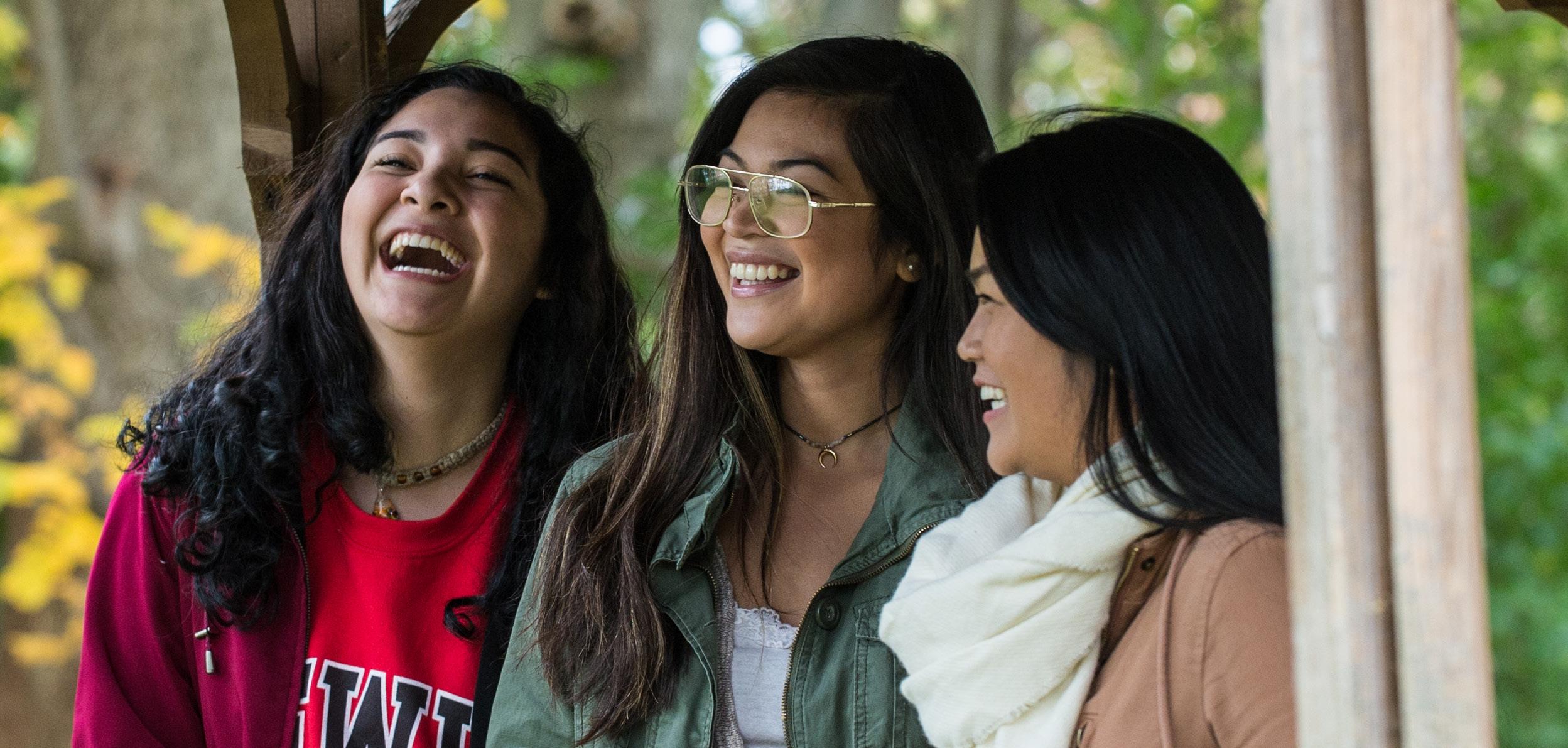
“We communicate scholarship information in printed pieces and provide a brochure and website page specifically for financial aid opportunities,” said Elizabeth Romagni, director of financial aid at Christian Brothers University (CBU) in Memphis, Tennessee. “We also use social media to get the word out to a larger audience. The admissions counselors work with each prospective student in identifying scholarship and grant opportunities.”
“We work with low-performing high schools in the area, and we do financial aid workshop nights,” explained Denise Scalzo, director of financial aid at Manhattan College in Riverdale, New York. “We help students who are thinking of Manhattan, a Lasallian school, or other schools. We have 10-15 workshops in the months of September and October.”
As a way to make higher education more accessible to more families, increase transparency about costs, and address rising tuition rates, La Salle University in Philadelphia, Pennsylvania, reduced its tuition by 29 percent in 2016 and adjusted its financial aid model.
“We take great pride as a university and community in meeting students where they are,” said Colleen Hanycz, Ph.D., president of La Salle University. “By providing a challenging and rewarding education that has a proven return on investment, students are ready for the workforce with the necessary 21st century skills that will help them face any challenges that come their way throughout their lives.”
Once a student enrolls, the schools place an emphasis on getting them ready for the college experience. For example, Saint Mary’s University of Minnesota has strengthened its first-year experience program to establish a sense of community and support student success, which has led to improved retention rates. In addition to on-campus experiences, students and their families complete an online course before move-in day, which includes a financial literacy component to help them think about how to cover costs not associated with tuition or room and board, along with discussing the realities of living away from home.
Lasallian colleges and universities make it a priority to not let financial needs pose a barrier to students seeking higher education. Courtesy Lewis University
SUPPORTING FIRSTGENERATION STUDENTS
In addition to the financial and support services offered to all students in need, Lasallian colleges and universities have a strong focus on supporting first-generation students. Through various programs, the schools ensure that students who are the first in their families to go to college have the support they need not only to enter higher education but to achieve a degree.
Saint Mary’s University of Minnesota offers its First Generation Initiative, which provides students who have high levels of need with academic, financial and social support. The program also includes Countdown to College, a summer program that prepares students for college.
A number of schools partner with organizations to help first-generation students access higher education. A few examples include TheDream.US, a program with which CBU and Lewis partner to help DREAMers access college. Lewis also partners with the Give Something Back Foundation as one way to support low-income and first-generation students.
“The foundation chooses these recipients as early as freshman year in high school,” explained Decharinte. “They mentor them through high school, and then the students have an option of choosing one of their partner institutions to attend college. In that particular case, we meet 100 percent of a student’s costs between the foundation money, our money and the student’s eligibility for financial aid.”
Saint Mary’s College of California in Moraga has its High Potential Program, which offers financial, academic and personal support to first-generation and low-income students. Partially funded by a federal grant, it also includes a preparatory summer program and mentoring by peers and faculty.
“We are an institution whose founding charism of access, equity and achievement is not only a tradition we cherish, but the vital pulse that keeps us moving,” said Dr. Frances Sweeney, vice president for mission at Saint Mary’s College of California. “In addition to financial assistance, we continue to pursue means to advance achievement.”
A recent example of that commitment at Saint Mary’s College of California is the Caminos a las Ciencias program, a grant from the Department of Education to assist Latino students in STEM fields through tutoring,
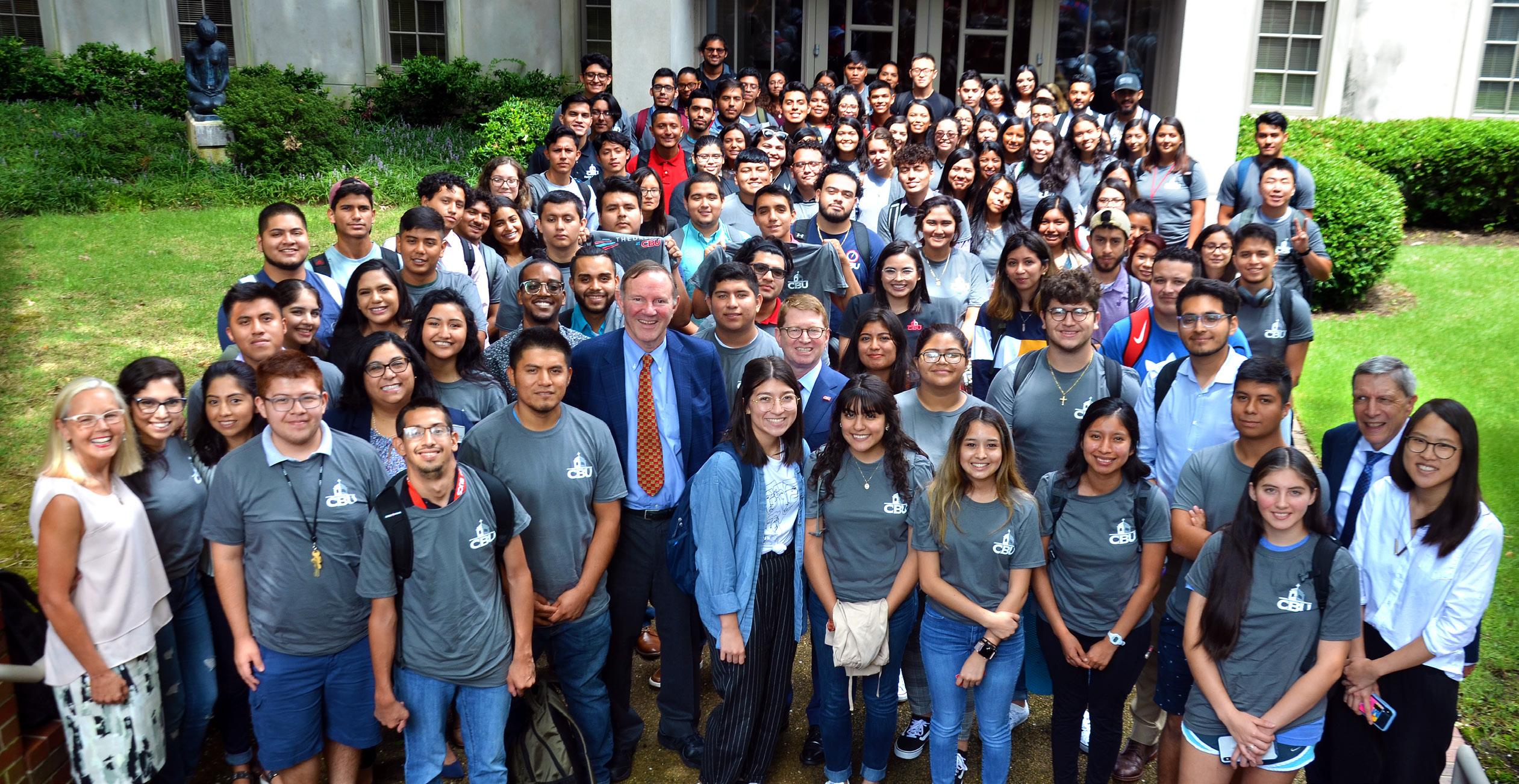
33 | DE LA SALLE TODAY AUTUMN 2019
Scholars who are part of TheDream.US at Christian Brothers University in Memphis, Tennessee, stand with Don Graham, organization founder (near center wearing tie), Candy Marshall, president (front left), and Hyein Lee, senior program officer (far right), along with CBU’s new president, Jack Shannon (next to Graham) and past president, Dr. John Smarrelli (far right). Courtesy CBU
courses, internships, research, advising and more. Manhattan also offers a STEM-related support program for first-generation students and low-income students called the Collegiate Science and Technology Entry Program, which includes assistance leading up to and during college.
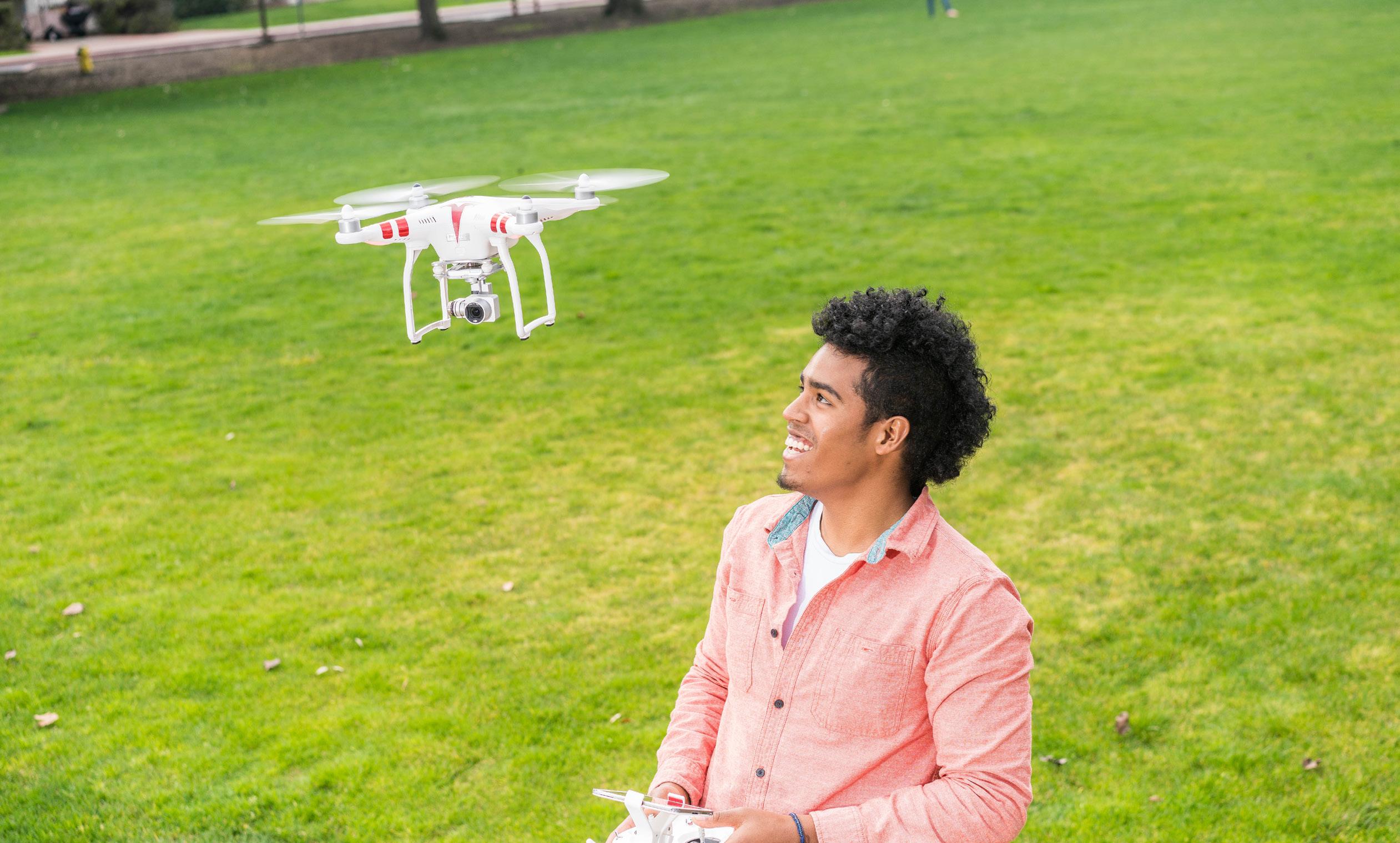
The Academic Discovery Program (ADP) at La Salle, which is partially funded by state money, serves students who live below the poverty line, many of whom are first-generation students. ADP provides financial aid and financial literacy training, along with peer mentoring, academic advising, counseling, tutoring and activities for social and cultural growth.
HELPING ADULT LEARNERS ACHIEVE A DEGREE
Many colleges and universities also focus on making higher education accessible to adult learn-
ers—whether it is a student who started college but couldn’t finish the degree, a student looking to embark on higher education, or a student interested in achieving a higher degree. The schools offer various opportunities to make higher education accessible to adults who are working, who are parents, or who have other life factors that prevent them from attending college full time.
These classes are offered on campus and/or online, frequently with evening hours, and often feature various entry points throughout the year and accelerated learning. A number of Lasallian higher education institutions have satellite campuses that focus on offering quality, affordable higher education to adult learners as they work toward a bachelor’s or advanced degree.
“What’s so exciting is at our graduations, sometimes you have somebody who is a 60-year-old and has
Saint Mary’s College of California has a new program that offers support to Latino students studying in STEM fields. Courtesy Saint Mary’s College of California
their kids and grandkids cheering them on because they’re finishing their bachelor’s degree,” said Murray. “You hear somebody whose kids are out in the audience and they’re excited, and now they feel they’re ready to go to school because they just saw mom walk across the stage.”
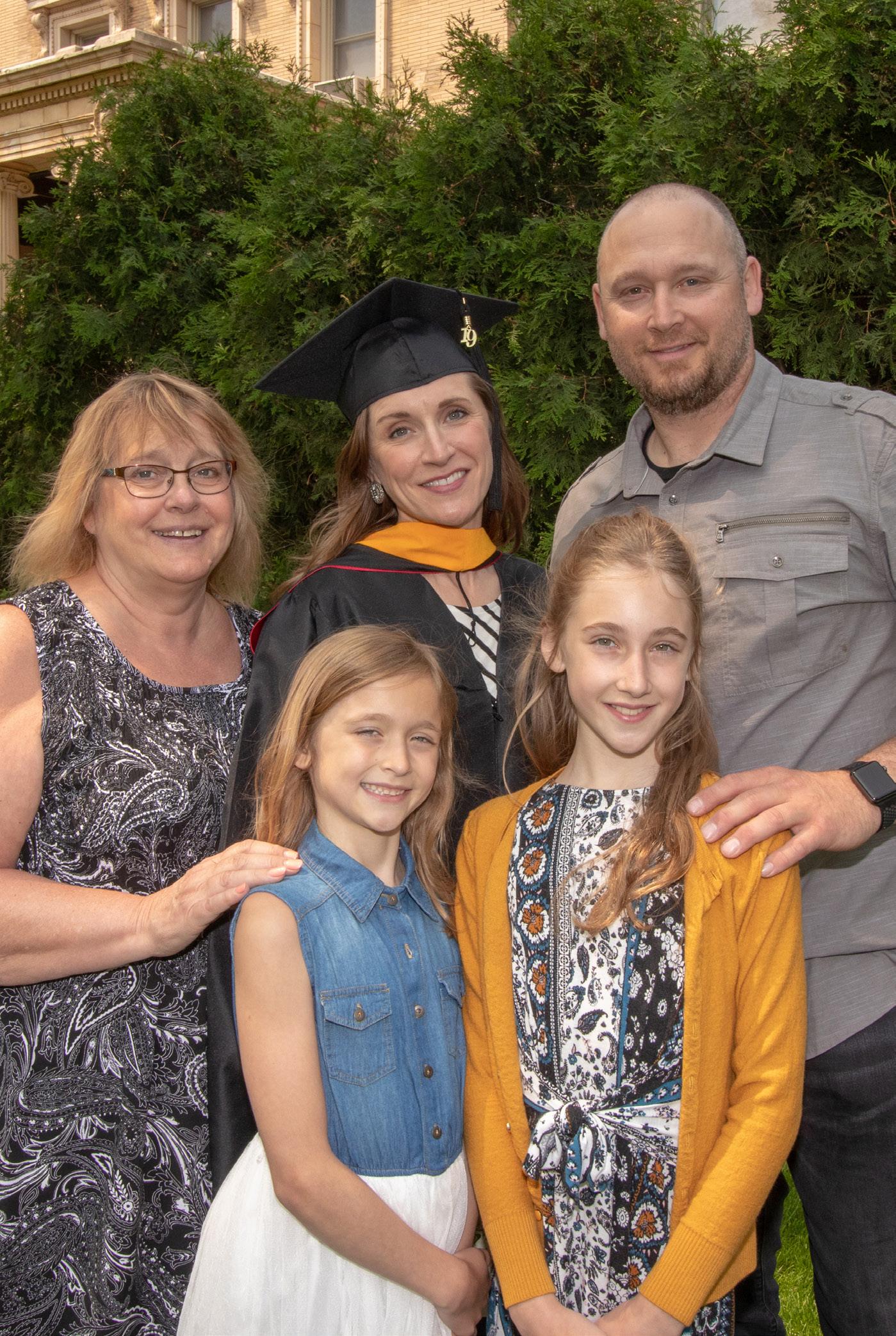
FROM ACCEPTANCE TO GRADUATION
The examples cited—and numerous others not mentioned—are ways Lasallian colleges and universities make higher education a reality for students in need. In addition to the $122 million in need-based aid, Lasallian colleges and universities strive to keep costs down and make college affordable for all students by awarding an additional $264 million in financial aid. Sixty-six percent of students received financial aid during the 2018-2019 academic year.
“It is no secret that the cost of higher education has continued to increase, making it almost impossible for many to get a college degree without financial assistance and other means of support,” said Romagni. “As Lasallians, we are called to an awareness of the poor and victims of injustice, and thus we respond to their needs through programs of community service, advocacy and justice education, using both financial and human resources.”
Because of that call, the support doesn’t stop once students get onto campus. They are welcomed into an inclusive community, where educators get to know them personally and guide them through their higher education journey. The schools stay tuned into each student’s financial and personal needs, with
a focus on helping them achieve their degree—a dream some students might never have thought could come true. •
35 | DE LA SALLE TODAY AUTUMN 2019
Elizabeth Moors Jodice is the director of communications at Christian Brothers Conference.
Saint Mary’s University of Minnesota offers numerous opportunities for adult-learners to achieve their goals. Courtesy Saint Mary’s University of Minnesota
A GLOBAL COMMUNITY STARTS IN THE CLASSROOM
BY RYAN WALL
If you close your eyes and point to a map, chances are you’ll land on an area with a Lasallian connection. Over more than three hundred years, the Brothers of the Christian Schools have established an extensive network of schools, ministries and communities serving nearly one million young people around the world.
These young people are part of a network offering them limitless opportunities, connections and experiences. Many schools are increasingly providing programs to help introduce students to their fellow Lasallian brothers and sisters around the globe. These programs foster a sense of global community, going beyond borders to exchange languages, create cultural awareness and prompt international dialogue.
BRINGING THE WORLD TO
THE CLASSROOM
At Christian Brothers Academy (CBA) in Lincroft, New Jersey, this was the case when it connected with Hakodate La Salle High School from Hokkaido, Japan, in December 2018. Nearly 80 students and 10 faculty members, including Hakodate La Salle Principal Brother Fermin Martinez, FSC, immersed themselves in the CBA community for a week. The visiting students and faculty spent each day with their American counterparts, attending classes, lunch and extracurriculars. The week was capped off with a farewell ceremony, with presentations from CBA and Hakodate participants discussing what they learned from the program.
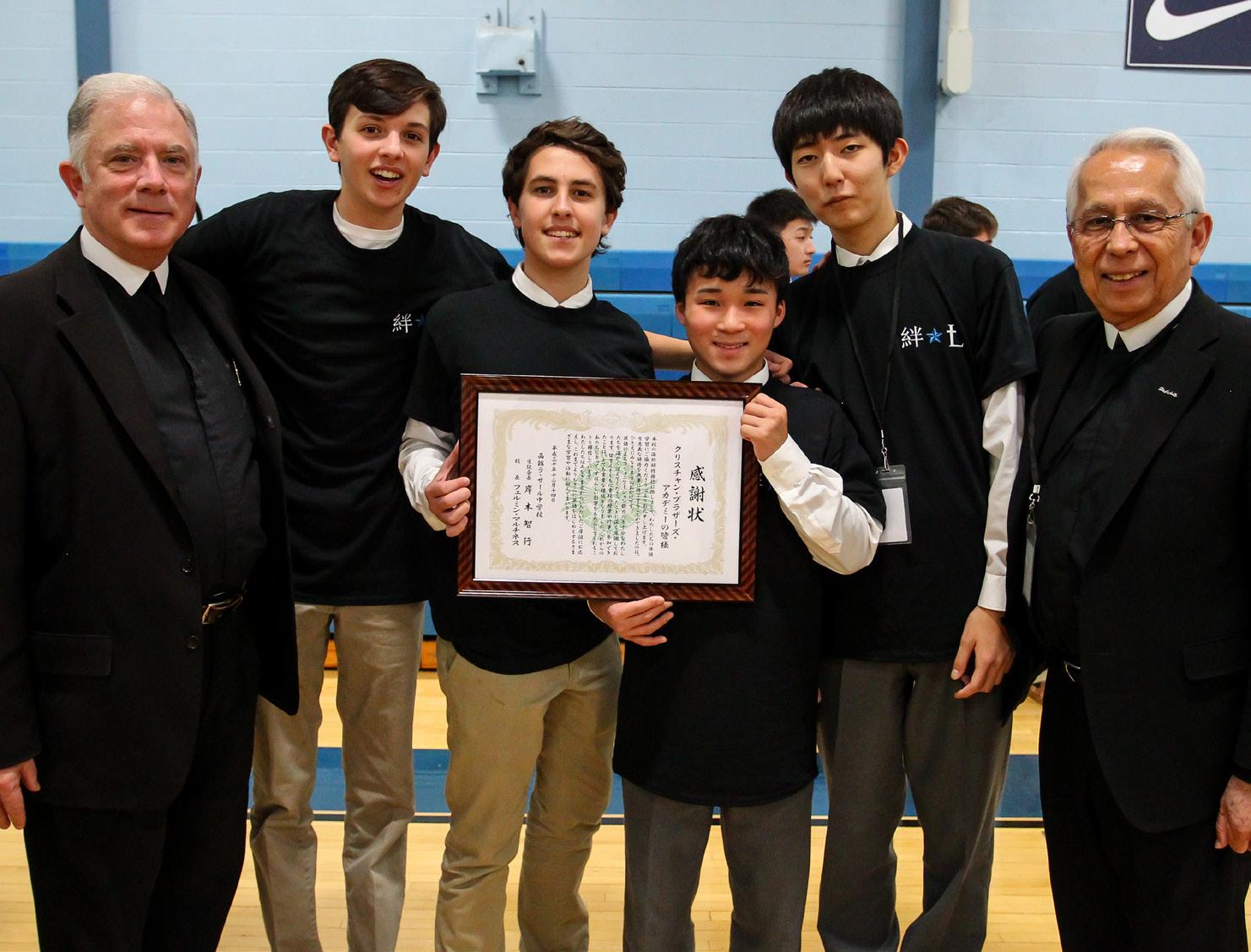 Brother Frank Byrne, FSC, (left), president of Christian Brothers Academy in Lincroft, New Jersey, and Brother Fermin Martinez, FSC, (right), principal of Hakodate La Salle High School from Hokkaido, Japan, stand with students from both schools during their visit to CBA. Courtesy CBA
Brother Frank Byrne, FSC, (left), president of Christian Brothers Academy in Lincroft, New Jersey, and Brother Fermin Martinez, FSC, (right), principal of Hakodate La Salle High School from Hokkaido, Japan, stand with students from both schools during their visit to CBA. Courtesy CBA
“What underlies this entire week is that we are all Lasallians. We have a special bond that opens each other’s hearts, so we worked so well together,” Brother Fermin said. “The students at both schools do not focus on cultural differences, which makes everyone feel equal and enjoy one another.”
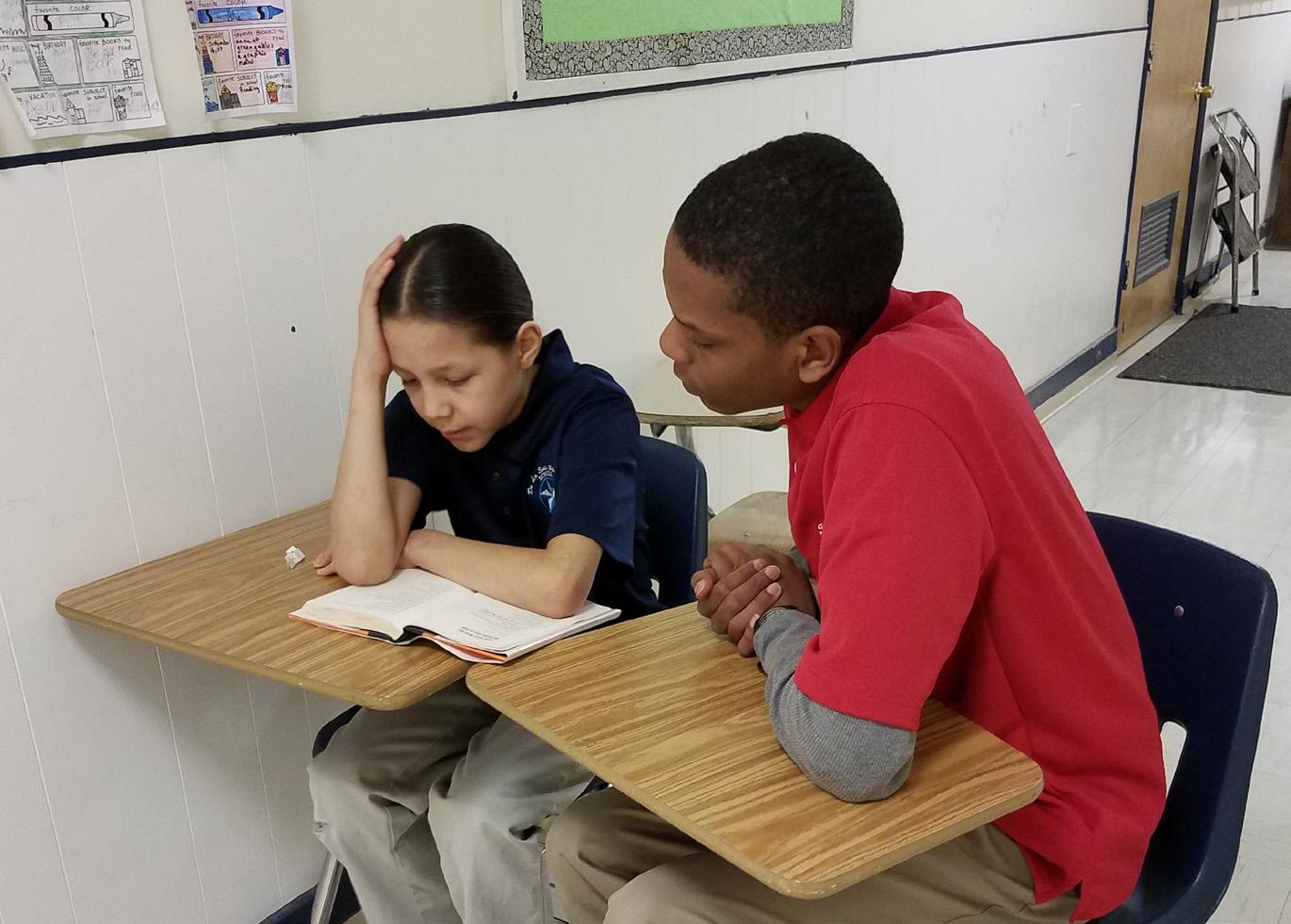
Students from CBA agreed.
“There have been countless times this week when I have seen our CBA students socializing with those from Hakodate as if we were each other’s classmates,” CBA senior Tim Murray said. “Whether it was hanging out in the cafeteria or library, playing Mario Super Smash Bros in the senior lounge, or just having a conversation in class, this week proved that we are more similar to each other than different.”
A similar offering at CBA is the Global Lasallian Scholars program, in which students spend a year learning about a country’s history, politics, culture and art before traveling there for a week. Last year, 23 students learned about Peru and visited Machu Picchu, Cusco and Lima. Next year, the class will focus on World War II, with students slated to travel to England and France.
Additionally, CBA is developing the Brothers in Service program, which will emphasize global social issues and have a significant service component. Like many other Lasallian schools, service is an
integral part of student life at CBA, and there are many service and immersion trips that take students around the United States to strengthen their sense of community.
EXPLORING THE BORDERS AT HOME AND BEYOND
Across the country, in Berkeley, California, students at Saint Mary’s College High School similarly engage with their global community. Their annual Enrichment Week (E-Week) is a highly anticipated curricular program that aims to promote the intellectual, spiritual, physical and social development of each student. The intent is to engage students and teachers in new and different experiences that build community outside of the classroom.
For E-Week, students choose from dozens of faculty-developed courses that offer a mix of academic, travel, career exploration, cultural and recreational components. Students have the opportunity to venture outside of their comfort zones to connect with the world around them—whether that be by exploring the greater Bay Area or participating in immersion trips to places like Haiti and Ghana. All offerings are led by faculty members who follow a curriculum that ties all activities back to the Lasallian mission of the school.
Over their four years at Saint Mary’s, students are expected to participate in a course from each of four categories: colleges and/or career exploration, educational and/or cultural experience, recreation and/or physical wellness, service and/or spirituality. In doing so, students experience the breadth of the Lasallian community while simultaneously receiving a holistic educational experience.
While several of the offerings emphasize local connections to the world, some offer annual or once-in-a-lifetime opportunities to travel around the country or abroad and connect with fellow Lasallians,
A student from Saint Mary’s College High School in Berkeley, California, reads with a student at De La Salle Blackfeet School in Browning, Montana, during an E-Week immersion trip. Courtesy Saint Mary’s College High School
often in locations and situations very different from a student’s own. Among these are immersion trips to the De La Salle Blackfeet School, Browning, Montana (page 13); La Salle Santiago Zobel School, Alabang, Muntinlupa City, Philippines; and Lasallian centers in India, Rome, and France.
In March 2019, one group traveled to the Bamboo School in Northern Thailand, which helps provide education to approximately 550 students on the border of Myanmar and Thailand (page 22). The 16 Saint Mary’s students and three faculty moderators spent the week constructing a chicken coop, which was needed to support the school kitchen.
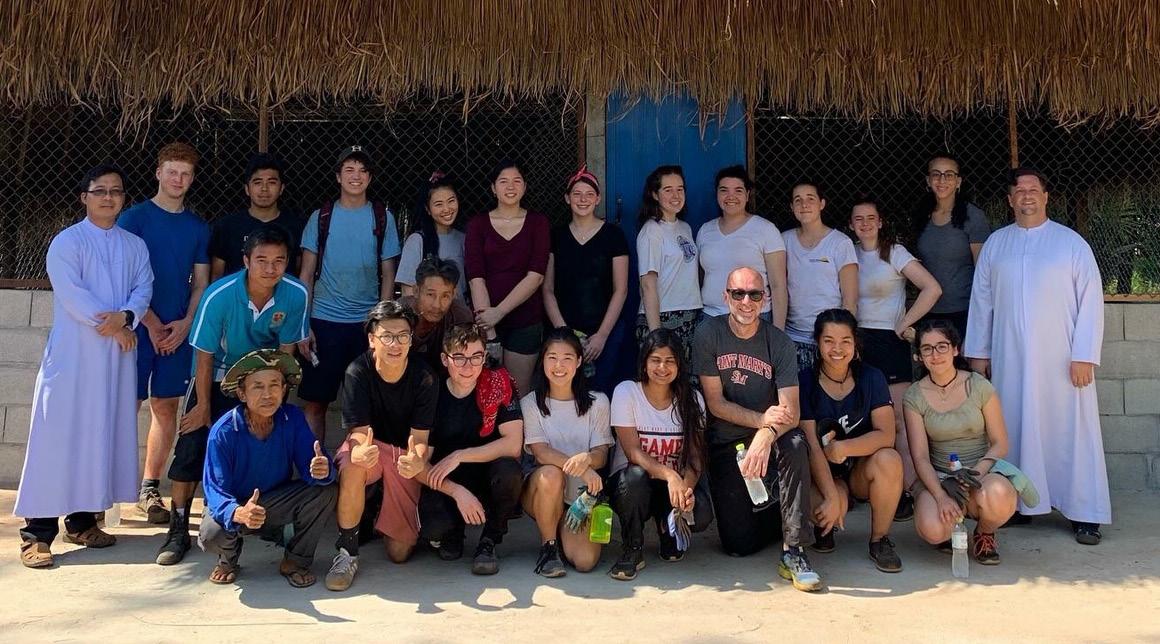
When students weren’t building the chicken coop, they were interacting with their Thai counterparts and making friends. They attended classes, taught conversational English, and helped with smaller projects for the school community like gardening and carpentry. The group also visited important Thai cultural destinations.
One of the faculty moderators, Brother David Caretti, FSC, felt that the week reinforced the Lasallian mission and stressed the importance of embracing our global community.
“I left Sangkhlaburi with an overwhelming sense of gratitude for my Brothers and the entire Lasallian
family,” he said. “Although we do amazing work in our own localities, we sometimes can be very headsdown. It is inspiring to know that our Brothers and members of the Lasallian family are doing exactly the same, as far away as Thailand.”
USING TECHNOLOGY TO BUILD COMMUNITY
Far from the hot and humid climate of Thailand, DeLaSalle High School in Minneapolis, Minnesota, also has programs to connect students to their counterparts around the world—only at DeLaSalle, many students have the opportunity to do so without leaving their classroom.
The Global Advantage Program helps create relationships between students and the larger Lasallian community by providing several opportunities for students to expand their horizons. Through the Global Advantage Problem Solving Skills (GAPSS) course, students are able to build relationships by taking a shared online class each day. Recently, the class has been held in collaboration with Colegio La Salle de Paterna in Valencia, Spain.
“We’ve had a wonderful ongoing relationship with Paterna,” said Brad Casey, who helped found the Global Advantage Program back in 2006. “The GAPSS course began when one of my colleagues,
Marta Vazquez, a science teacher, connected with a teacher at Paterna and decided to co-teach a course together on an international issue—in this case, climate change. The kids have loved it so far and it’s been a huge hit.”
This class utilizes Google Hangouts to foster relationship-building and has been constantly evolving to better suit students and teachers. For example, the class needs to be held first thing in the morning Central Time to accommodate for the seven-hour time difference. Sometimes, topics need to be framed a bit differently to account for language discrepancies. But these minor adjustments haven’t dampened enthusiasm at DeLaSalle; if anything, it has only helped make the demand for the class grow.
“We plan on expanding the program to run again in the spring, and we hope to allow more students to participate. We’ve been focusing on building a template for this class, and we hope we can leverage our relationships with other Lasallian schools to provide this incredible opportunity to broaden their horizons,” Casey said.
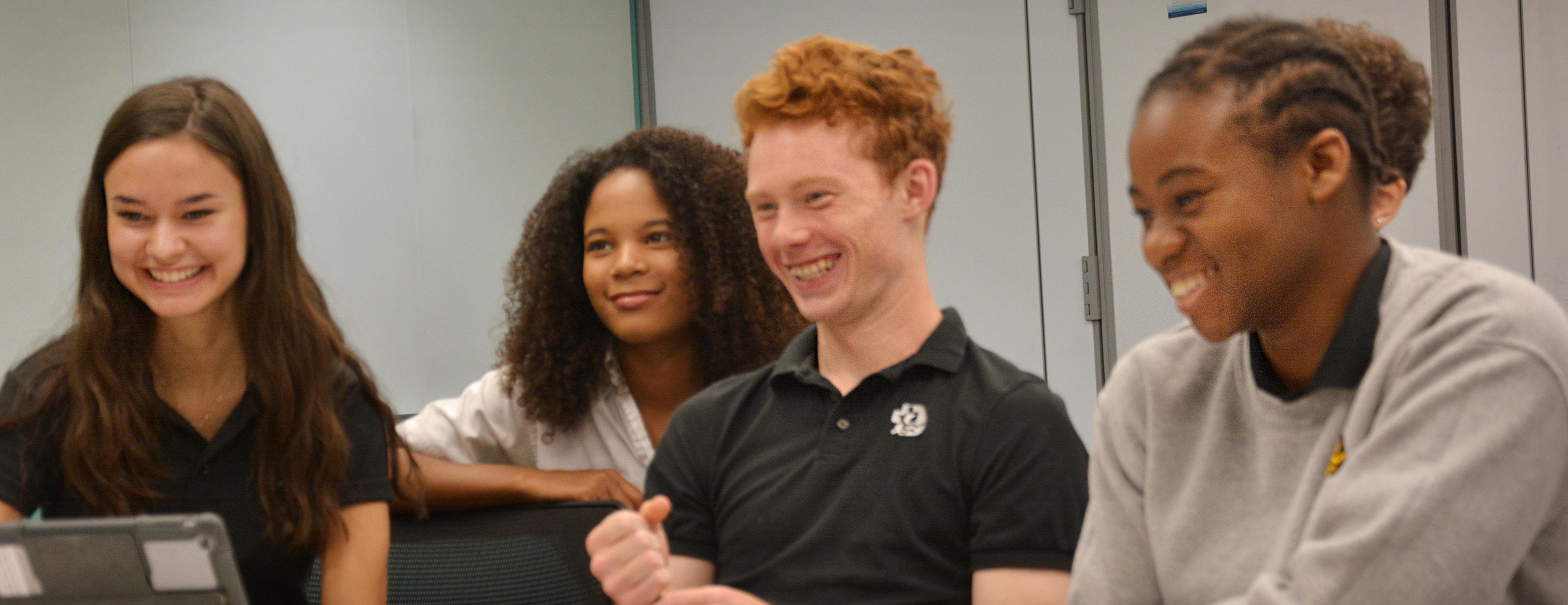
“One of the biggest advantages of the program is that all students—regardless of socioeconomic status— are able to participate. Money should never be a barrier to education. That speaks to the heart of our Lasallian mission, and I’m proud we’ve been able to
figure out a way to make this program come to life,” Casey continued.
As part of the GAPSS course, six students from DeLaSalle visited Valencia in October, after four students from Paterna traveled to Minneapolis in August. Similar Global Advantage Program initiatives help students participate in academic exchange programs, during which they connect with and stay at Lasallian schools. Since the program’s inception in 2006, DeLaSalle students have traveled to places like Argentina, Italy, Kenya, India, Bolivia, Brazil, Costa Rica, Ecuador and Slovakia showing them the breadth of the Lasallian world.
BRINGING THE FAMILY CLOSER
As Lasallians, we’re all called to the same mission— whether that mission is carried out in Thailand or New Jersey or Spain. With more and more schools around the world participating in these types of initiatives and programs, our Lasallian network has become significantly more connected. The relationships developed by going beyond the border last long beyond the school year. They create lasting bonds that prepare students for a lifetime of service as global citizens, and effectively lay the framework for a more compassionate and understanding world. •
Ryan Wall is a 2018 graduate of La Salle University in Philadelphia, Pennsylvania.
(Left) Students and faculty from Saint Mary’s College High School stand in front of the chicken coop they built at the Bamboo School in Northern Thailand in March 2019. Courtesy Saint Mary’s College High School
Students at DeLaSalle High School in Minneapolis, Minnesota, interact with students at Colegio La Salle de Paterna in Valencia, Spain, during online classes. Courtesy Matt Lehman
BROTHER JAMES MILLER: BEFORE BECOMING BLESSED
 BY ALEX VASILIADES
BY ALEX VASILIADES
On December 7, 2019, Brother James “Santiago” Miller, FSC, will become the first De La Salle Christian Brother from the United States to be beatified. Brother James was only 37 when he was shot and killed as he patched a school wall in Huehuetenango, Guatemala, in 1982.
A native of Stevens Point, Wisconsin, Brother James felt called to serve beyond the borders of the comforts and safety of his home country. He is survived by his two brothers, Bill and Ralph, his two sisters, Louise Shafranski and Patti Richter, and numerous Christian Brothers.
His cause of beatification was undertaken by the Diocese of Huehuetenango and received the Decree of Validity in Rome in 2010 when Brother James was designated a Servant of God and a martyr for the faith. The recognition of martyrdom cleared the way for his beatification. As a martyr, Brother James must have one miracle attributed to him posthumously to reach the next and final step toward sainthood, which is canonization.
Much of Brother James’ life story has been shared in various books and articles, including a recently updated biography, Hermano Santiago: The Life and Times of Brother James Miller, FSC. In the following interviews, we learn more about Brother James from two individuals who knew him well, his sister Louise, and friend and colleague Brother Stephen Markham, FSC. In addition to sharing memories of Brother James, they also tell us what life has been like for them since that tragic day.
HOW DO YOU THINK BROTHER JAMES’ UPBRINGING LED TO HIS ROLE IN THE BROTHERS?
Brother Stephen: I think Brother James’ experience growing up in a rural area on a farm with a wholesome Catholic family prepared him well to know how to appreciate the simple things of life, to learn how to create and fix things, and above all to embrace his faith, caring for and looking out for neighbors, friends and anyone in need. This prepared him to take on roles with the Brothers that led him to Nicaragua and Guatemala, where he lived and died for what he believed.
THIS IS MENTIONED IN BROTHER JAMES’ BIOGRAPHY: “‘ONE OF TWO FRIGHTENING THINGS COULD POSSIBLY HAPPEN TO ME IN GUATEMALA,’ BROTHER JAMES HAD SAID. ‘I COULD BE KIDNAPPED TORTURED, AND KILLED, OR I COULD SIMPLY BE GUNNED DOWN.’ HE TOLD HIS SISTER THAT HIS ONLY REAL FEAR IN THIS REGARD WAS THAT IT MIGHT BE THE FIRST.” DO YOU REMEMBER THIS?
40 | DE LA SALLE TODAY AUTUMN 2019
Brother James Miller, FSC, pictured in a yearbook photo, graduated from Saint Mary’s University of Minnesota in 1966. Courtesy Saint Mary’s University of Minnesota
WAS THERE EVER A POINT THAT YOU ASKED HIM NOT TO GO BACK TO GUATEMALA?
Louise: Yes, I do remember it well, as I am the sister he told that to. I remember, asking him, “Why would they do that to you? What would they hope to gain? What possible information would they hope to get?” His answer was “nothing,” but it would be a sign of power. As for telling Jim not to go back, no, I did not. I knew Jim was very dedicated and committed to his students in Huehuetenango, there was no stopping him from going back.
DO YOU REMEMBER WHERE YOU WERE WHEN YOU FOUND OUT HE HAD BEEN KILLED? WHAT WENT THROUGH YOUR MIND? HOW WERE YOU TOLD?
Louise: I was at my apartment with my husband, Rich. It was the evening of February 13, 1982. My mother called to ask if Rich and I could come out to the farm now. I asked her if it was in regards to my father, who was ill and on dialysis at the time. My mother assured me that it was not my father, but wouldn’t say any more than that. She had the strangest sound to her voice, and it was a sound I had never heard before or since. I knew something was very wrong. As I hung up the phone, there was a special bulletin on the
television. It stated that there had been a priest shot and killed in Guatemala. I turned to Rich and said, “It’s
not a priest. It’s Jim. He has been shot and killed.” Upon reaching the farm, we noticed several vehicles in the yard, one with a Pacelli bumper sticker. Seeing that, I knew without a doubt that Jim was dead. When entering the house, I saw Brother Dominic Ehrmantraut, FSC, who was the principal at Pacelli during that time. I looked directly at him and said, “It’s Jim, isn’t it? He’s dead. They shot him.” It was then that his death was confirmed.

All I could think of at the time was what a waste of human life, and how devastating this was for my parents and my other brothers and sister. I was also angry. I still cannot understand how people can commit actions like this against fellow mankind.
WHAT HAS THE PROCESS FROM HIS DEATH TO BEATIFICATION BEEN LIKE FOR YOU?
Brother Stephen: It has been moving and somewhat emotional, intriguing and educational, graced and filled with gratitude. I have been asked to give several talks and, of course, many memories from the time of his death (both stressful happenings and affirming confirmations for Jim and the Brothers) resurfaced. I spent time in Rome and visited with Brother Rodolfo Meoli, FSC, Postulator General, participated in an eight-mile pilgrimage in Wisconsin with our Lasallian Volunteers, and served as a witness at the exhumation of Brother James’ body in Ellis, Wisconsin. I learned a lot about the canonization process and was grateful to reunite with Brother James’ siblings.
Louise: Oh, where does one start. From the very beginning it was thought that Jim would someday become a saint. In the years following Jim’s death there were annual memorial/award programs in his honor. Being present at those programs at times was very difficult, as it continued to resurface the events of that tragic time. As time moved on it got better for me, and I was able to accept the honors and acknowledgements that were bestowed on Jim.
Brother James served at Casa Indígena De La Salle in Huehuetenango, which is where he was killed.
Since the actual process has begun, there has been a lot of waiting and wondering. We, as a family, were asked to assemble in October 2009 at St. Peter’s Catholic Church in Stevens Point. It was at that time that depositions and recollections of Jim were to be recorded for the official record. We, the siblings, were taken according to age in a separate room, away from the rest of the family. We swore an oath to tell the truth. We were each asked 42 questions and were to give our responses to the best of our knowledge. That process was quite thought-provoking and intense, as it was witnessed by officials from Rome and the Diocese of La Crosse.
Since that time, the family has met with Brother Larry Schatz regarding the process and things that might be addressed, including, but not limited to, the exhumation of Jim’s physical body and his eventual and final resting place after the beatification ceremony.

To say it has been a unique experience would be an understatement. This is truly a first for our family, and not to mention for the Christian Brothers of the United States. It has been incredible to be part of history, and to think this is all regarding my brother makes it more unbelievable.
WHAT IS YOUR HOPE FOR THE FUTURE? WHAT DO YOU HOPE FOR HIS LEGACY?
Louise: My hope for the future is that Jim would be canonized and that my siblings and I will be living to
see—hopefully be part of—the celebration. As far as his legacy, I would hope that Jim’s death and subsequent beatification will bring to attention the poor, underserved and underprivileged in Central America. With that attention, I would hope that more people will open their hearts, minds and resources to create opportunities to allow the people to be more self-sufficient. It would also be gratifying if more people were interested in following his example. As it is known, sometimes ordinary people can do extraordinary things.
Brother Stephen: Brother James was passionate about serving the poor, using his God-given talents to make life better for the poor in Nicaragua and Guatemala, and he is an example of our Founder’s message, “Your zeal must go so far that you are ready to give your life, so dear to you are the children entrusted to you.” It is my hope we Brothers and all those with a devotion to Brother James will embrace whatever is their passion and will live it out in practice as was the case with Brother James.
IS THERE ANYTHING THAT YOU WOULD WANT OUR READERS TO KNOW ABOUT BROTHER JAMES?
Brother Stephen: Brother James lived an authentic life, died a martyr and, rightly so, is recognized by the Catholic Church. We must remember that there are other missionaries—religious, ordained and laity—who have done the same, some of whom have been publicly remembered and many who are simply


42 | DE LA SALLE TODAY AUTUMN 2019
The casket of Brother James was carried through various streets of Guatemala.
remembered in the hearts of those who knew and loved them.
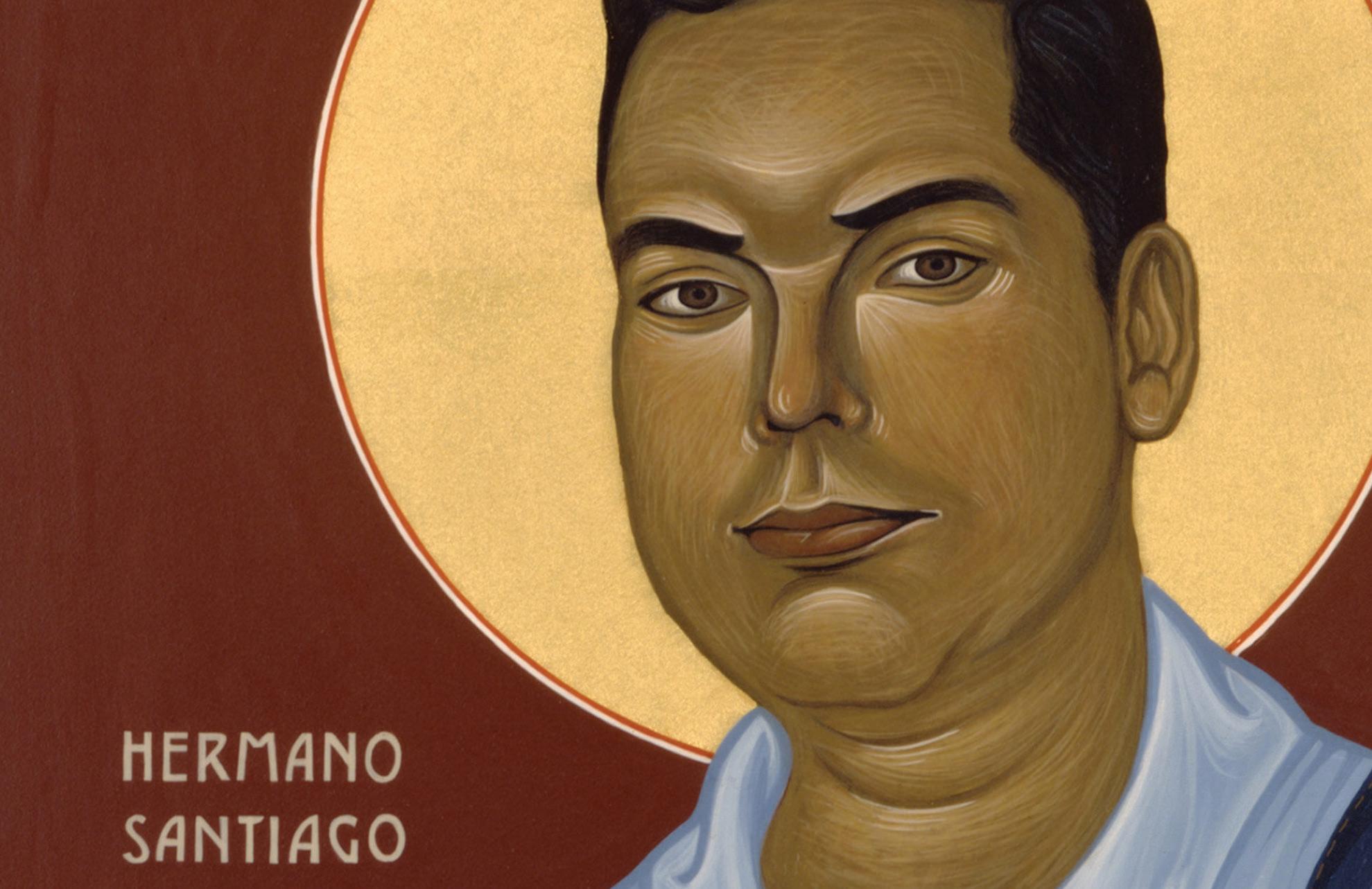
Louise: The one thing I hope people take away is that Jim was a real person. He was a son, brother, Christian Brother and friend. He had a hearty laugh, a ready smile, a quick wit, a good sense of humor, and was a genuine, hard-working person. He was a man who felt happiness and sorrow, had great love for both family and the Church. He loved working with his hands, and was, through and through, a little farm boy at heart. •

Alex Vasiliades is the communications manager for the Midwest District. The responses in this story have been lightly edited for length and clarity. All photos in this story were submitted by the Midwest District unless otherwise noted. Learn more about Brother James at www.cbmidwest.org.
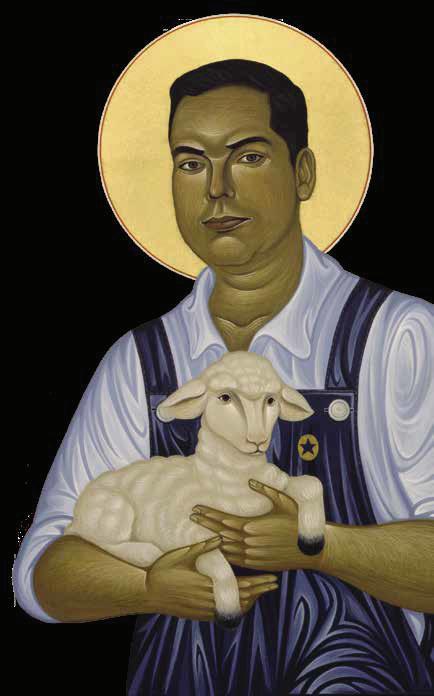
THE BEATIFICATION OF BROTHER JAMES MILLER, FSC! UPDATED HERMANO SANTIAGO NOW AVAILABLE BROTHER THEODORE DRAHMANN, FSC
to know the story of Brother James
of his beatification on December
martyr while
the poor in 1982 in Huehuetenango, Guatemala. This book is an updated version of the 2002 publication that shares Brother James’ life story and now includes details on his beatification process. VISIT SAINT MARY’S PRESS AT WWW.SMP.ORG/BJM TO ORDER. PURCHASE 2 OR MORE AND GET 20% OFF. USE PROMO CODE BROTHERJAMES. The Life and Times of Brother James
HERMANO SANTIAGO Ë|xHSLISEy904172zv;:#:!:!:+ ONLY $9.95
CELEBRATE
Get
ahead
7, 2019. Brother James died a
serving
Miller, FSC Theodore Drahmann, FSC
A restored photo of Brother James, taken during his time in the novitiate.
CALENDAR OF EVENTS
NOVEMBER 2019
1 – 3
Regional Council of Young Lasallians (RCYL) Meeting, Montréal, QC
1 – 5 Superior General Pastoral Visit, District of Francophone Canada (starts October 31)
7 – 19
19 – 21
21 – 23
21 – 23
Superior General Pastoral Visit, District of Eastern North America
Lasallian Education Council (LEC) Meeting, Minneapolis, MN
Huether Lasallian Conference, Minneapolis, MN
7th World Congress of the Association of Lasallian Alumni (UMAEL), Minneapolis, MN
23 Lasallian Volunteers 30th Anniversary Alumni Gathering, Minneapolis, MN
24 Year of Lasallian Vocations Ends

24 – 25 Regional Communications Team (RCT) Meeting, Minneapolis, MN
DECEMBER 2019
2 – 4 Lasallian Publications Committee (LPC) Meeting, Napa, CA
7 Beatification of Brother James Miller, FSC, Huehuetenango, Guatemala
31 Lasallian Jubilee Year Ends
JANUARY 2020
7 Novitiate Postulancy Committee (NPC) Meeting, Napa, CA
8 – 9 Regional Conference of Christian Brothers (RCCB) Meeting, Napa, CA
17 – 19
Lasallian Volunteers Midyear Retreat, Reisterstown, MD
FEBRUARY 2020
6 – 9 Brothers in Initial Formation Gathering, St. Meinrad, IN
23 – 26
MARCH 2020
2 – 15
4 – 6
12 – 14
15 – 18
17 – 29
19 – 21
Lasallian Association of Secondary School Chief Administrators (LASSCA) Conference, Houston, TX
Superior General Pastoral Visit, District of San Francisco New Orleans
Lasallian Education Council (LEC) Meeting, Burr Ridge, IL
Brother John Johnston Institute of Contemporary Lasallian Practice (District of San Francisco New Orleans), Duncans Mills, CA
Regional Vocation Formation Committee (RVFC) Meeting, Loranger, LA
Superior General Pastoral Visit, Midwest District
Brother John Johnston Institute of Contemporary Lasallian Practice (District of Eastern North America and Midwest District), Pocono Manor, PA
APRIL 2020
1 – 3
16 – 18
22
25

Superior General and General Council Meeting with Regional Conference of Christian Brothers (RCCB), Ocean City, NJ
Regional Formation Programs Advisory Committee (RFPAC) Meeting, Washington, DC
Regional Finance Committee (RFC) Meeting, Washington, DC
Lasallian Volunteers 30th Anniversary Gala, Riverdale, NY
TODAY
Christian Brothers Services We Are Lasallian
 Brother Joel Damian, FSC Founder of Christian Brothers Services
Brother Joel Damian, FSC Founder of Christian Brothers Services
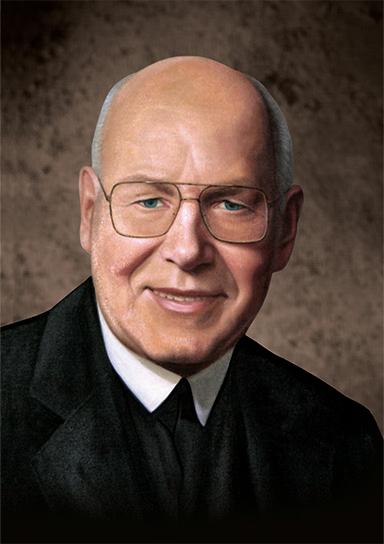
Christian Brothers Services began as an answer to the problem of expensive, and/or unattainable insurance coverage for Catholic organizations. In our 58th year, Christian Brothers Services has grown to administer 7 Trusts, which serve more than 2,000 Catholic organizations including religious orders, dioceses, colleges and schools.
> Catholic School Management
> Employee Health Plan
> Employee Pension Plan
> Employee Retirement Savings
> Property / Casualty
> BMT Management and Financial Consultants
> Religious Health
> Website Design/Board Portals
Christian Brothers Services is able to fully support Christian Brothers Conference and exemplify our Lasallian mission by understanding, protecting and guiding our members.
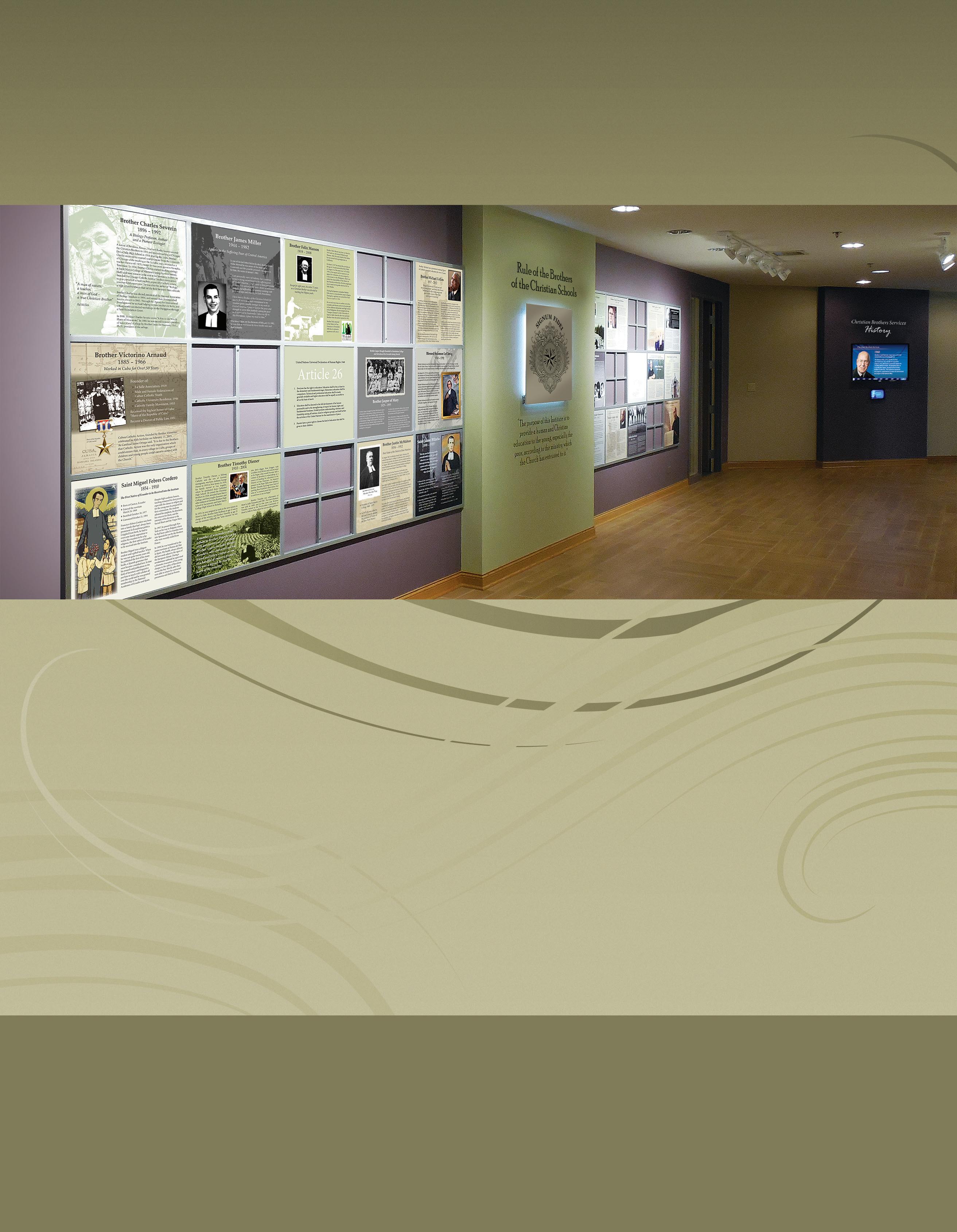
A division of Christian Brothers Services Management & Financial Consultants cbservices.org 800.807.0100
CHRISTIAN BROTHERS CONFERENCE
415 Michigan Avenue NE, Suite 300

Washington, DC 20017

TODAY


























 (Left) The Bamboo School opened in 2008 with 40 students. Courtesy the Bamboo School
(Below) The Bamboo School serves students who would otherwise have no access to education. Courtesy the Bamboo School
(Left) The Bamboo School opened in 2008 with 40 students. Courtesy the Bamboo School
(Below) The Bamboo School serves students who would otherwise have no access to education. Courtesy the Bamboo School

 La Salle Technical College – Hohola offers an education focused on academics and vocational skills for young people who need a second chance. Courtesy La Salle Technical College – Hohola
Progress is being made at La Salle School – Rumbek, where students are able to learn in new classrooms as construction continues. They were previously being taught in a facility owned by the Loreto Sisters. Courtesy La Salle School – Rumbek
La Salle Technical College – Hohola offers an education focused on academics and vocational skills for young people who need a second chance. Courtesy La Salle Technical College – Hohola
Progress is being made at La Salle School – Rumbek, where students are able to learn in new classrooms as construction continues. They were previously being taught in a facility owned by the Loreto Sisters. Courtesy La Salle School – Rumbek











 Brother Frank Byrne, FSC, (left), president of Christian Brothers Academy in Lincroft, New Jersey, and Brother Fermin Martinez, FSC, (right), principal of Hakodate La Salle High School from Hokkaido, Japan, stand with students from both schools during their visit to CBA. Courtesy CBA
Brother Frank Byrne, FSC, (left), president of Christian Brothers Academy in Lincroft, New Jersey, and Brother Fermin Martinez, FSC, (right), principal of Hakodate La Salle High School from Hokkaido, Japan, stand with students from both schools during their visit to CBA. Courtesy CBA



 BY ALEX VASILIADES
BY ALEX VASILIADES









 Brother Joel Damian, FSC Founder of Christian Brothers Services
Brother Joel Damian, FSC Founder of Christian Brothers Services









